plants
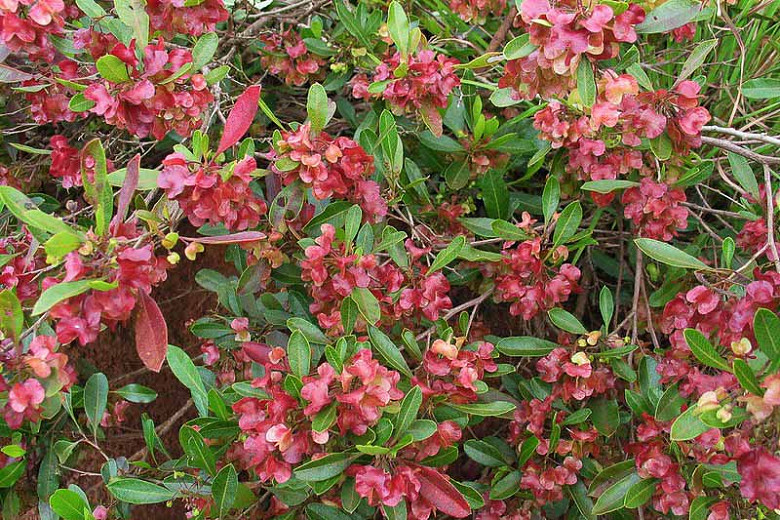
ʻAʻaliʻi - Dodonaea viscosa
A dense shrub (4-8 ft.) with small green leaves and tiny flowers that develop into star shaped papery seed capsules. These plants are mostly dioecious meaning that they’re usually separate male and female flowered plants, rarely they can be hermaphroditic having both flower types on the same plant. These seed capsules vary in color from cream to yellow, green, pink all the way to deep dark maroon-red.
The seed capsules are highly valued for used in lei weaving, and the red capsules are used for making a red dye. The beautiful wood of ʻaʻaliʻi is very hard and is used for making smaller hand tools and weapons.
ʻAeʻae - Bacopa monnieri
Dense, flat growing ground covered with light green leaves and blueish white flowers.
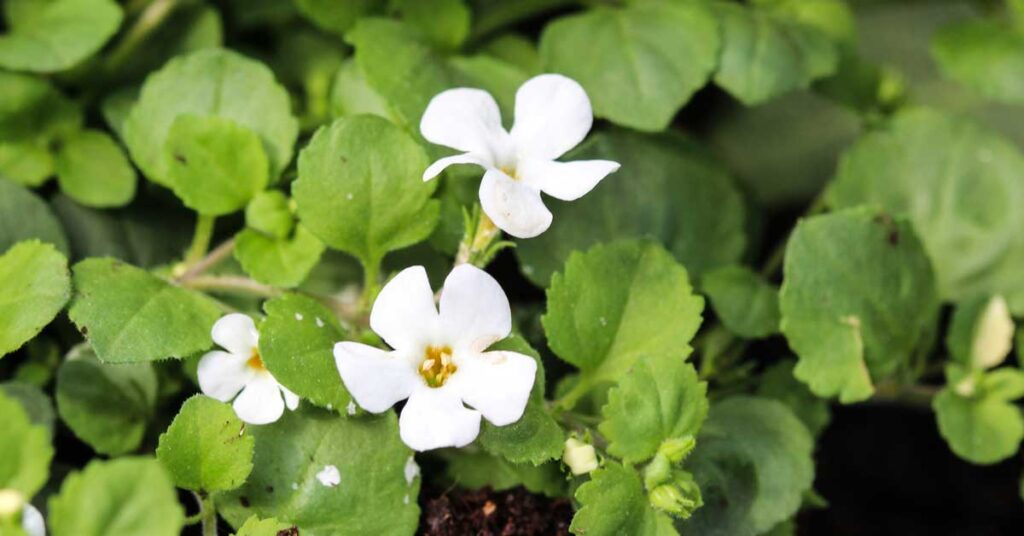
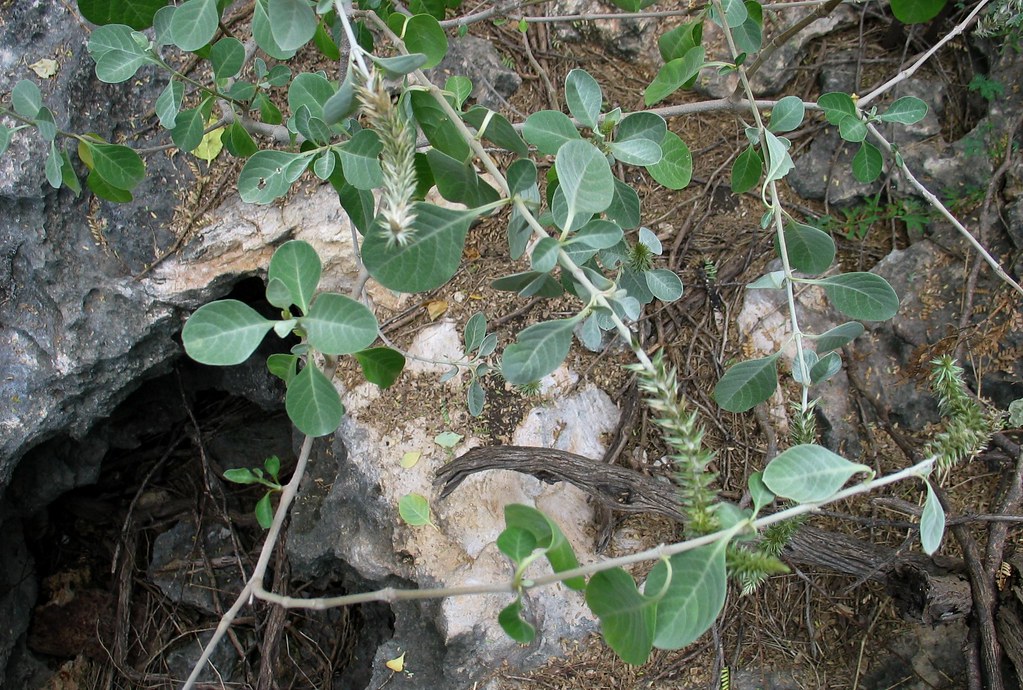
ʻAhinahina - Achyranthes splendens var. rotundata
Although the Hawaiian name for this plant is not historically known, it is often referred to today as ‘Ahinahina, Hinahina or Hinahina Ewa. The reason for these names primarily has to do with its color. In Hawaii, many plants that are silvery in color are called hinahina or have the word hinahina in its name.
This ‘ahinahina is very silvery in color, has soft rounded leaves and can reach a height of about six feet tall. Its flowers (called spikelets) are arranged on soft spikes that protrude six to fourteen inches above the plant. They are very eye-catching and attractive in a unique way.
The spikes and new leaves of this plant are used in Wili and Haku Lei.
Ahuʻawa - Mariscus javanicus
A greenish blue rush with linear leaves 40-110 cm. long. The flower clusters emerge umbrella like at the surface with many tiny spikelets (which contain the seed.) The margins of the leaves are very coarse and abrasive.
Hawaiians use the pounded stems of this plant to strain pulp out of awa- a drink made from the pound root of the awa plant.
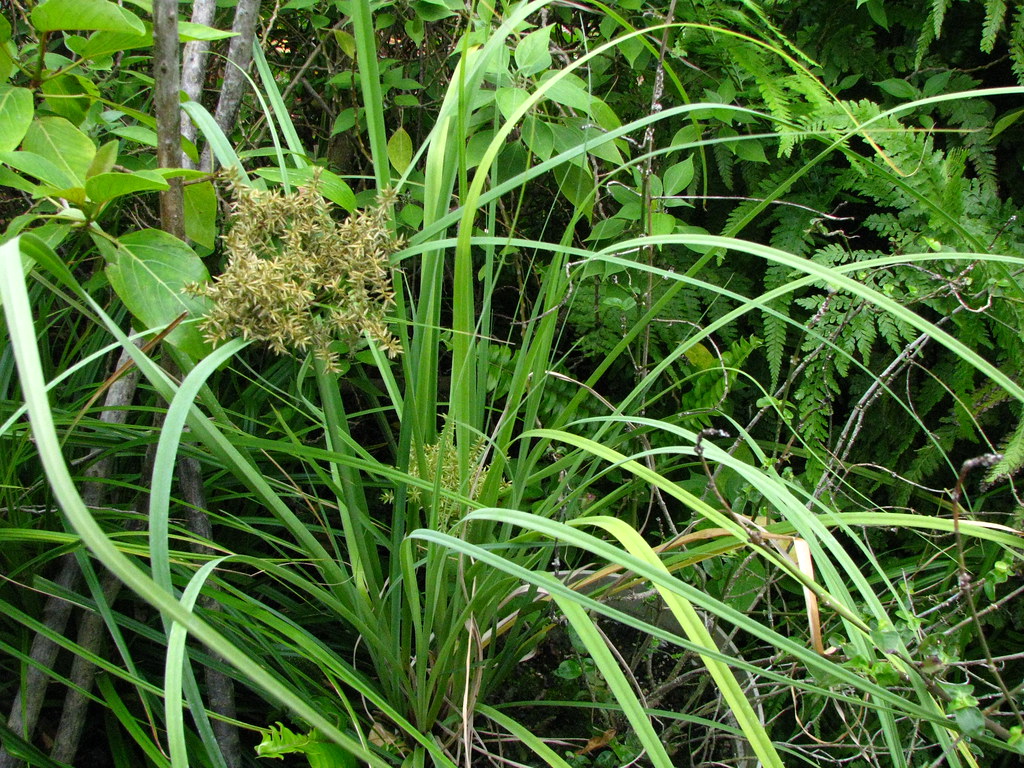
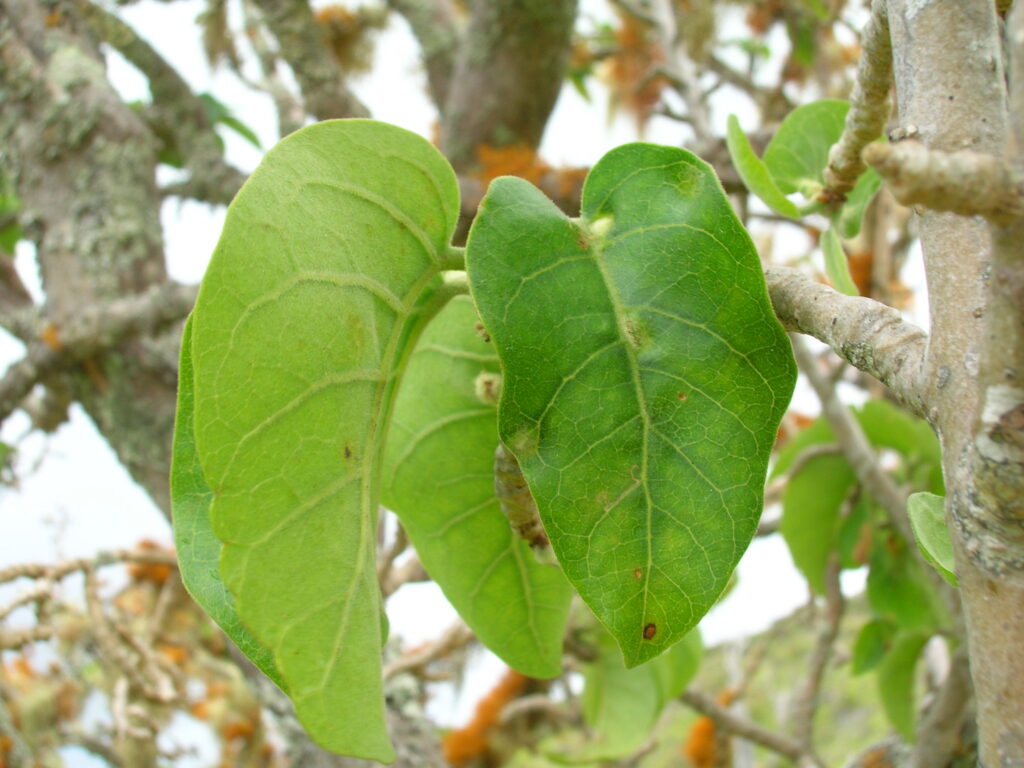
ʻAiea - Nothocestrum latifolium
A very rare group of plants, comprising four species within the endemic genus Nothocestrum. The wood of this plant is generally soft with a light brown to grayish-white bark. Most of the leaves tend to gather towards the tip of the branches but very few at that. The most impressive feature of this group of plants is their flowers. Easily one of the most pleasantly fragrant flowers native to Hawaii, it is only rivaled against by a handful of others. Once pollinated, the flowers develop into small orange-red fruit about an inch long filled with numerous little seeds.
If available the flowers make the most beautiful smelling lei.
ʻAkaʻakai - Schoenoplectiella tabernaemontani
Green onion on steroids is what they look like, but really they’re tall native bulrushes.
Used to make quick temporary mats as well as to be layered to soften bedding.
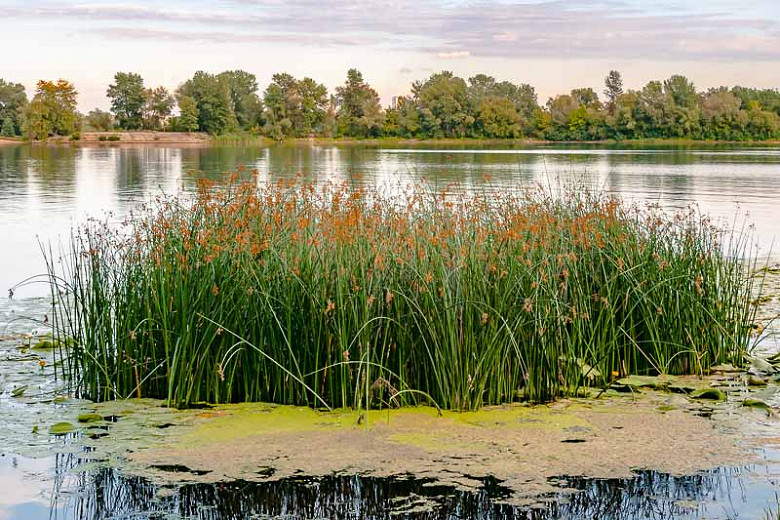
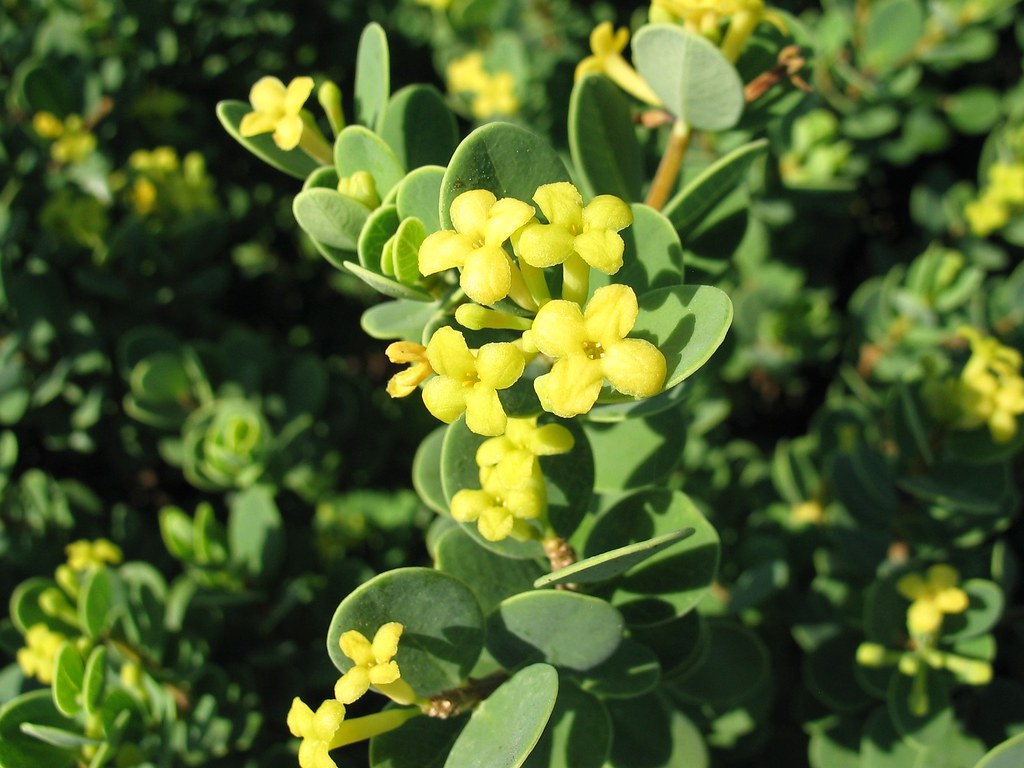
ʻĀkia - Wikstroemia uva-ursi
Endemic: Kaua’i, O’ahu, Maui, Molokai
Dense shrubs that either grow prostrate or sprawl up to 3-4 ft. tall. They have small oval shaped leaves, greenish-blue in color that is attached to braches which are reddish brown. When in bloom, numerous clusters of tiny yellow flowers develop which eventually turn into small orange or red fruits about ½-3/4 inch in diameter. The flowers have a very musky but distinct scent to them and can be easily smelt from a distance usually more so in the early evening.
Many members of this genus Wikstroemia were used as a narcotic to catch fish. The bark, roots and leaves were pounded and mixed with bait and then thrown in the water to feed the fish; upon ingesting, the fish would swim in a “drunken” state which made them easier to scoop up with a net or to spear. The mashed plant parts are also used in Hawaiian spell casting and sorcery.
ʻĀkia Kuahiwi - Wikstroemia oahuensis
Endemic: Kauai, Oahu, Molokai, Maui and Lanai
Tall shrubs or small trees up to 12 ft high with very few braches. Bark is thin and medium to dark brown with white leaf scars. Leaves vary greatly but this form has larger, narrowly elliptic leaves that are light green. Flowers form in clusters and are yellow to bright green. Once pollinated, they form orange fruit with a single black seed.
The bark of this plant was stripped to make very strong cordage. Some sources also list it as a plant used to make kapa. It was also used medicinally to treat asthma and also as a laxative. Many species of ‘akia and ‘akia kuahiwi can be used to perform a fishing method called hola to stupefy fish. Various parts of the plant were mixed with chum and spread through the water. When fish ate the mixture they became intoxicated which made them easier to scoop with a net or to spear. A concoction to execute criminals was also made from mixing the bark and roots of ‘akia kuahiwi with other plants. In addition to all of these uses the bright fruit were often strung into lei.
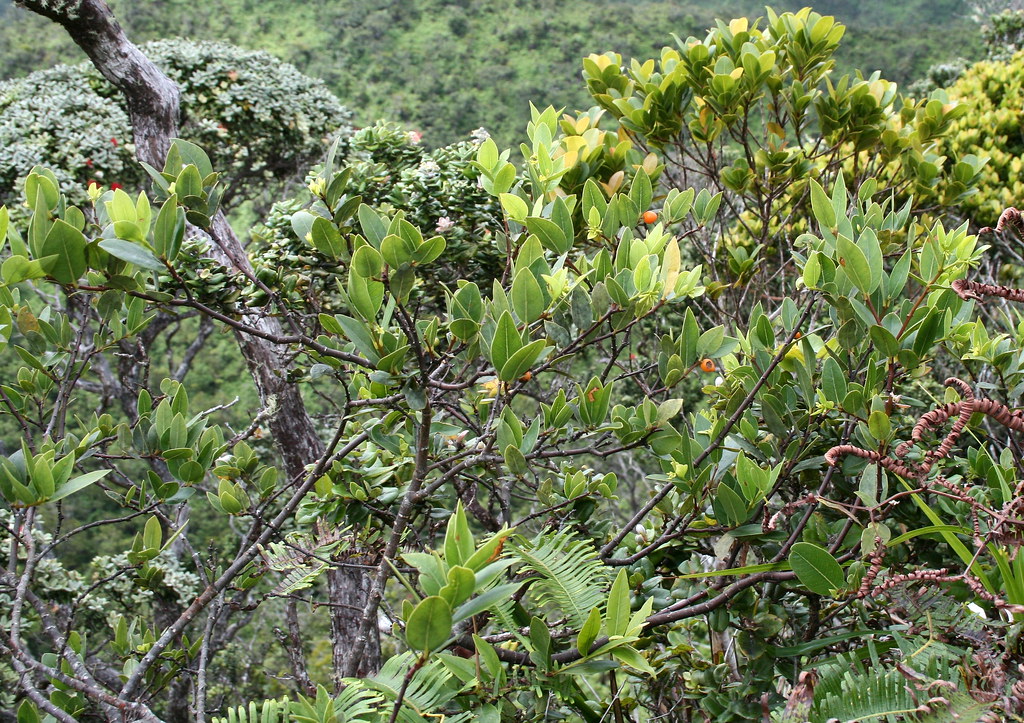

ʻAkiohala - Hibiscus furcellatus
Also Known As: Purple Hibiscus
Indigenous: Kauai, Oahu, Maui, Hawaii
A medium sized hibiscus about eight feet tall with rough leaves that are slight to moderately lobed. New stems, flower buds, and leaf surface are densely pubescent. They have awesome flowers that emerge on tall stems which stand up above the rest of the plant. Each flower is large and has light purple/pink petals with a dark purple center and staminal column. Once pollinated, the calyx will turn brown and be filled with many small, shiny brown seeds.
Flowers can be used medicinally as a laxative and also for a dye, while the bark can be stripped and woven into cordage.
ʻAkoko - Chamaesyce celastroides
Endemic: All of HI including Nihoa.
Prostrate groundcovers two feet tall or less or erect shrubs up to six feet with thick, glabrous leaves. This very attractive plant has light blue-green leaves with tiny, yellow, insignificant (for landscape purposes) flowers. It forms a very dense bush or nice looking ground cover depending on the variety.

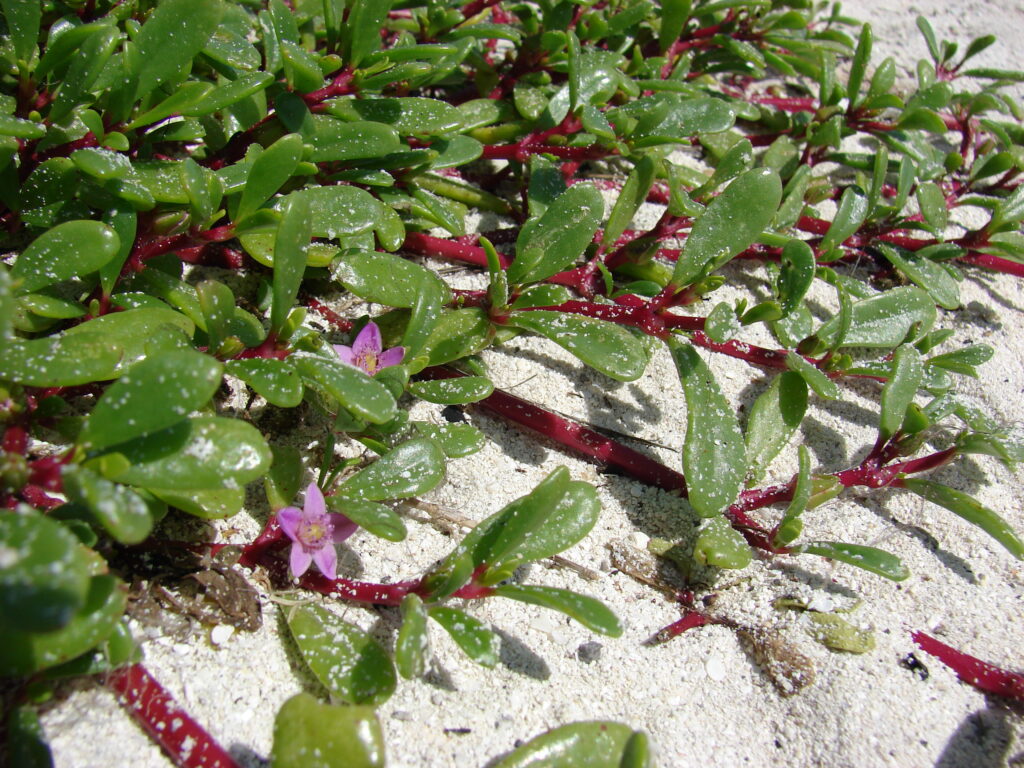
ʻĀkulikuli - Sesuvium portulacastrum
Indigenous: All HI
The ʻākulikuli plant is a very low crawling ground cover. It has very succulent green leaves with bright red stems and purplish pink flowers.
The flowers as well as the leaves and branches can be strung into lei. The leaves can also be eaten but have a rather salty taste to them, more so they were used as roughage in pig feed.
ʻAlaʻalawainui - Peperomia blanda
Indigenous: All the main islands except Kahoolawe.
A low growing very succulent plant that grows up to about 10 inches tall with fleshy, light green stems, dark green leaves that have a semi-rough texture, sometimes reddish-pink streaks are found on the underside of the leaves. They have tiny insignificant flowers that rise up above the rest of the plant on short soft flowering stalks and once pollinated they form slightly adhesive, poppy-seed looking seeds that cover the stalk.
A rich, gray dye for dying kapa can be made from the ashes of this plant.
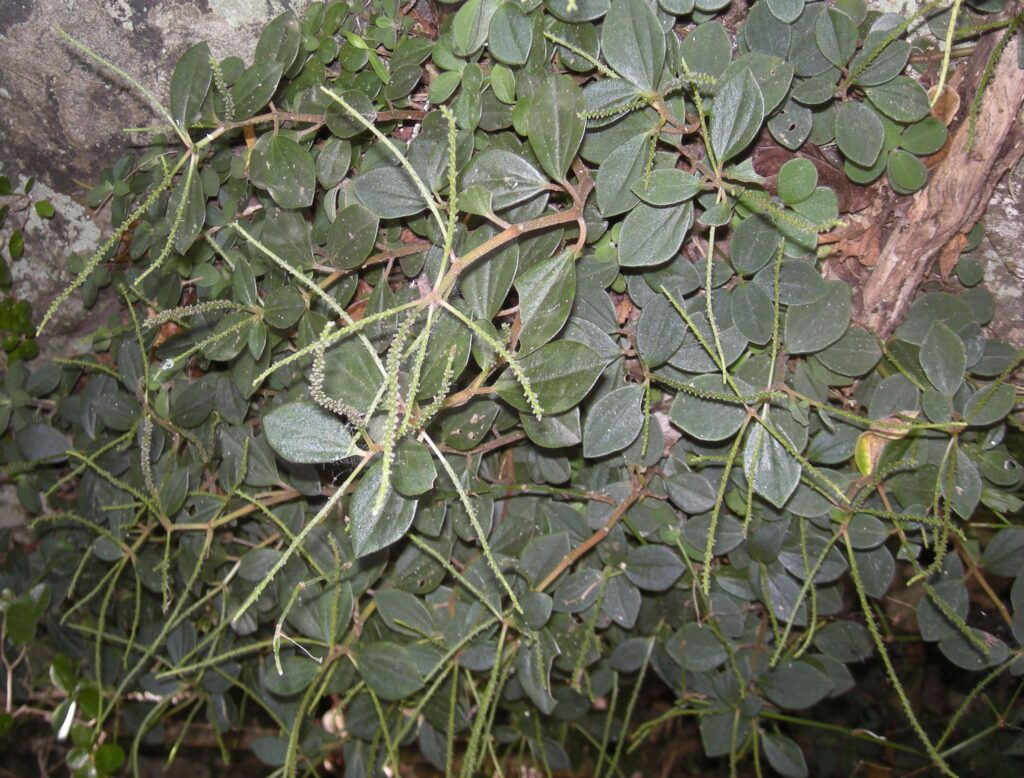
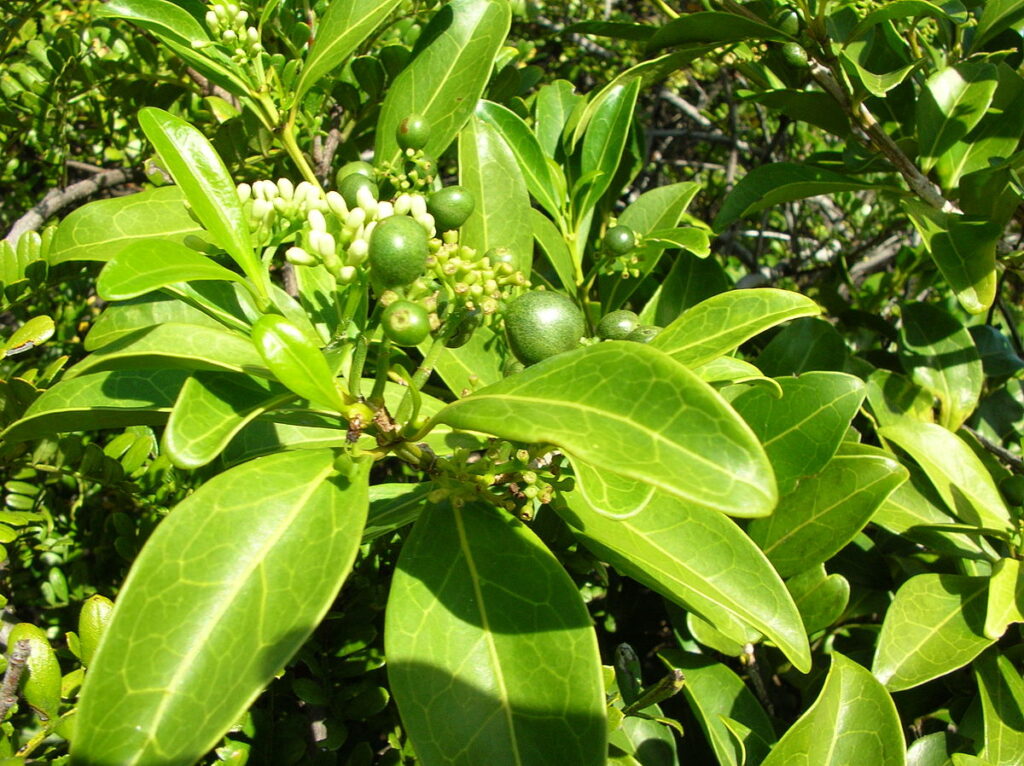
Alaheʻe - Psydrax odorata
A large tree (20-30 ft.) with glossy green leaves and small, white, highly fragrant flower clusters. As the tree grows, it has a radially symmetric growth pattern to it, somewhat like a Christmas Tree, which by the way it subs as an excellent one. Not only that if you keep it alive in a pot then you can plant it in your yard after.
Digging tools and Adze handles were made from the hard wood of this plant while a black dye was also made from the leaves. In addition the flowers and fruit are used in lei.
Alena - Boerhavia repens
Somewhat succulent herbs with a thick center root from which prostrate stems branch out radially. Leaves are small and rounded. From the leaf axis, small white flower clusters extend up from a single, narrow stem.
The succulent roots of Alena are used as a diuretic.
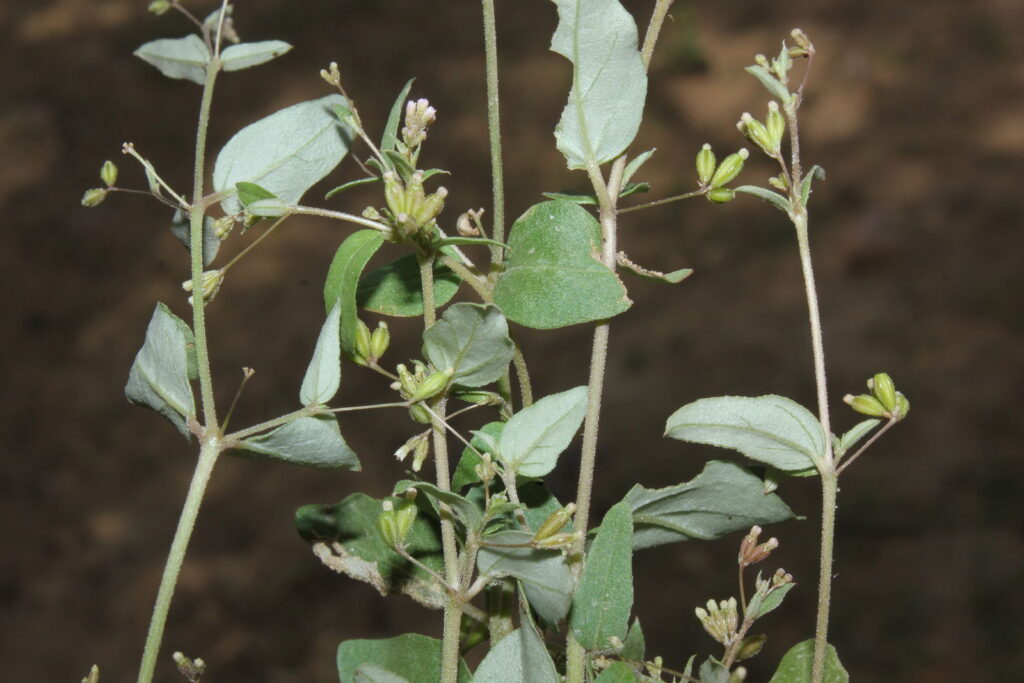
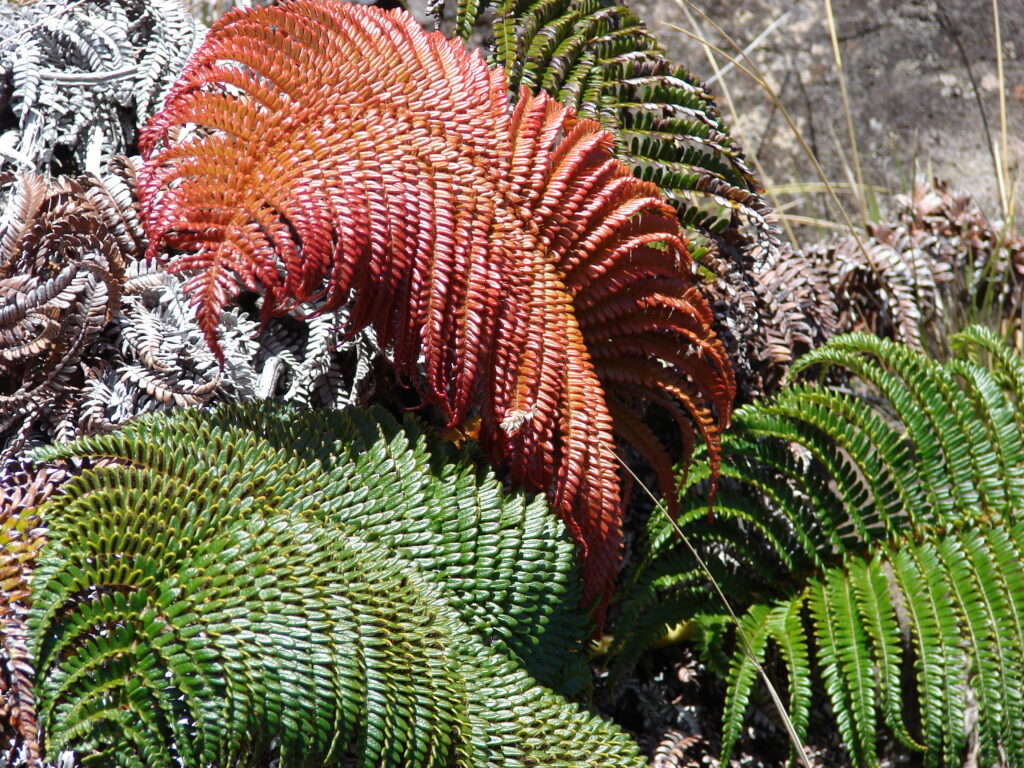
ʻAmaʻu - Sadleiria spp.
Endemic: All HI
Commonly mistaken for hapu’u fern the easiest way to distinguish amau is from its new fronds that once unrolled are bright red then eventually turn green as they age. It also has more narrow frondlets which uncurl outwards unlike hapu’u which has more elaborate frondlets that they themselves look like individual fronds. The pulu on amau is more coarse and golen than the fine pulu of hapuu.
Occasionally in times of famine the starchy pith of ama’u was eaten just like that of hapu’u. A red dye was also extracted from the cortex of the trunk. The sap from within the rolled up fronds was used as a glue for binding and patching sheets of kapa. The fronds were also used as thatching the center ridge pole for waterproofing, or sometimes the whole house when pili wasn’t available.
ʻĀnapanapa - Colubrina asiatica
Indigenous: Ni’ihau, Kaua’i, O’ahu, and Moloka’i
Large shrubs with extremely glossy leaves almost resembling a coffee plant. It has small yellow-green flowers that once pollinated turn into small apple shaped fruit about 3/4” in diameter. The foliage is sometimes sparse on the branches still the plant is very bushy. Often it will grow on and over other shrubs and trees, including other anapanapa, needing their support to grow taller.
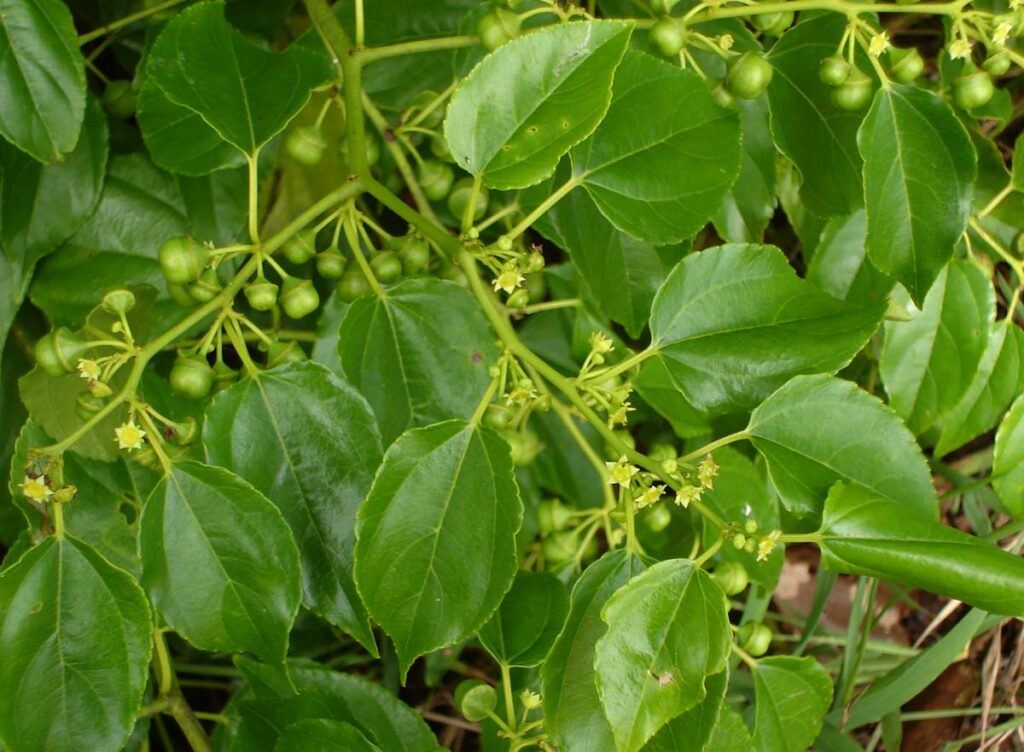
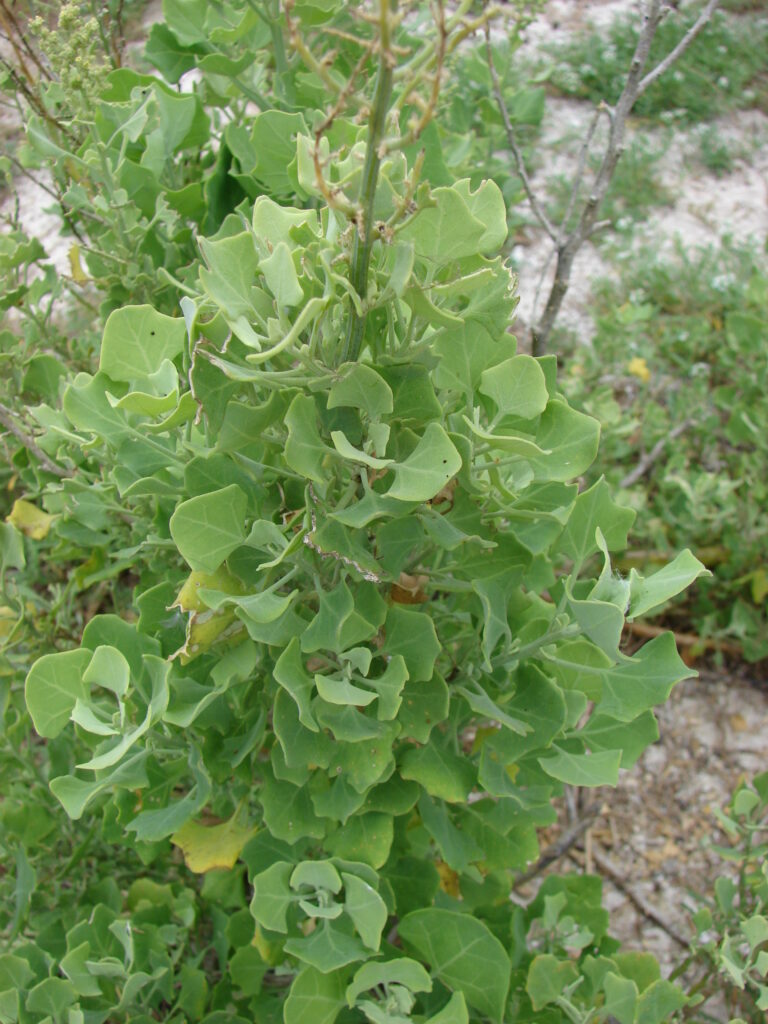
ʻĀweoweo - Chenopodium oahuense
Endemic: Kauai, Oahu, Molokai, Maui, Lanai, Hawaii, plus Lisianski, Laysan, Necke, French Frigate Shoals, Nihoa.
‘Aweoweo are typically low shrubs to small trees 2-8ft. tall with light blue/green leaves that are in the shape of a goose’s foot (they belong to the goose foot plant family Chenopodiaceae). Sometimes the leaves call be very tiny, about ¼”-1/2″ across or they can be up to 2 inches depending on the growing conditions. Usually less water and more sun will result in smaller, thicker leaves whereas regular watering will make the plant have larger more thin leaves like in the picture. The flowers are very small and are in clusters above the plant. The older stems are usually streaked with red, similar to the fish, but also, when the leaves and flowers are crushed it smells just like the ‘aweoweo fish too! fo’ real! I not joking! But, you have to crush it first. You don’t have to worry about the plant smelling up your yard.
The young leaves and stems are wrapped in ti leaves and steamed to be eaten in times of famine. The harder wood at the base of the plant can also be shaped in to fish hooks so you can catch ‘Āweoweo with ‘aweoweo.
Other names for this plant include: ‘Aheahea, ‘ahea, ‘ahewahewa, alaweo, alaweo huna (Ni’ihau), kaha’iha’i.
ʻĀwikiwiki - Canavalia hawaiiensis
Endemic: Lanai, Maui, Hawaii
A climbing vine with very pubescent, trifolate leaves (three leaflets comprising a single leaf) and striking purple flowers. The flowers are similar to those of pea-flowers like the ‘Ohai (Sesbania tomentosa), but are a bright purple and have a white spot at the base of the petal and keel. After the flowers are pollinated, large seed pods with 3-9 tan colored seeds, about an inch in diameter, develop on the inside.
The flowers and seeds of this spectacular vine are strung into extraordinary lei. The color of the flowers range from almost all white with splashes of purple to deep purple depending on which island you are on.
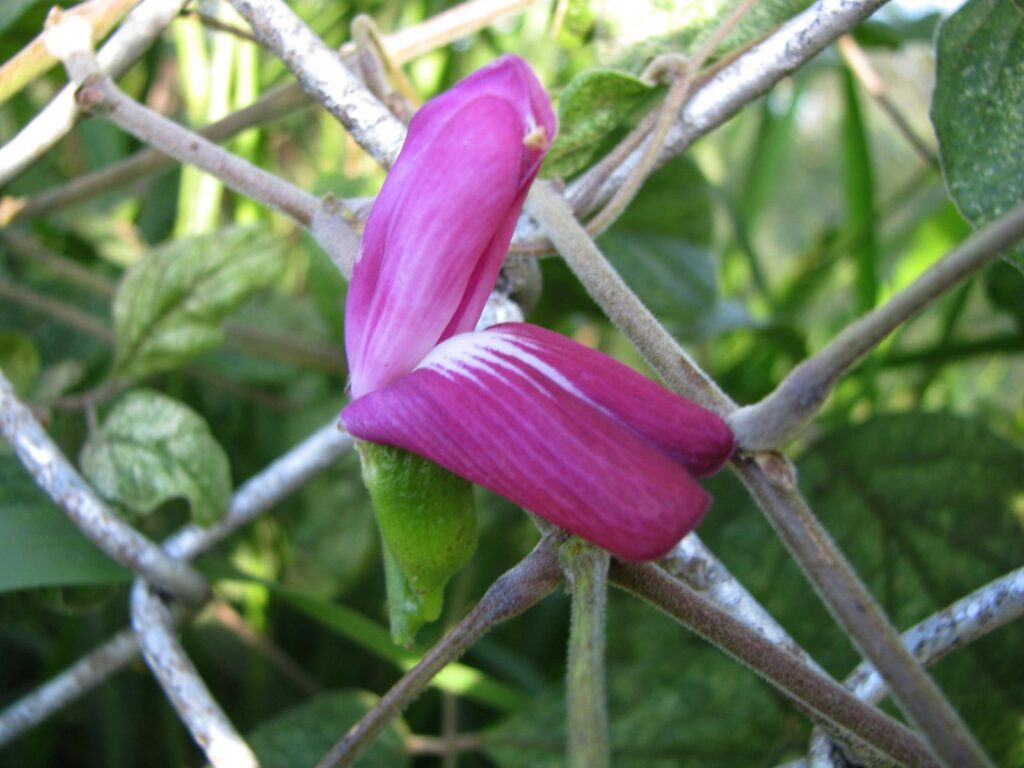
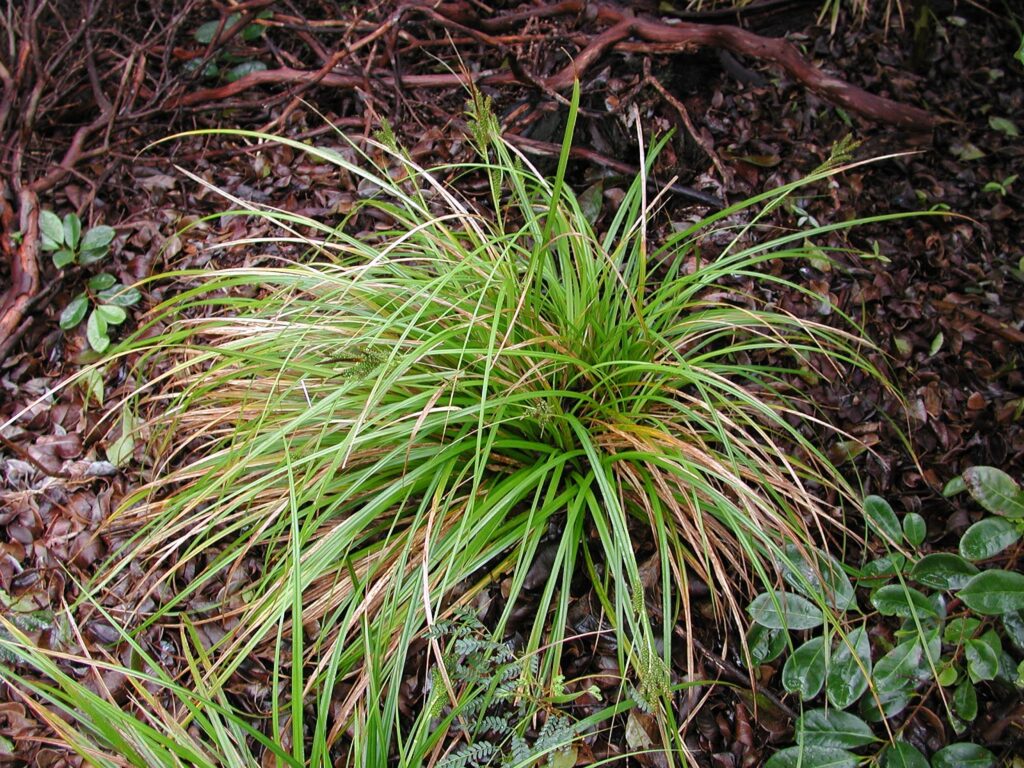
Carex - Carex wahuensis
Endemic: Kaua’i, O’ahu, Maui, Moloka’i, Lana’i, Hawaii
Graceful sedges that form thick clumps and reach heights close to two feet tall, however, the long leaf blades droop downward and can actually reach lengths up to four feet long. These blades are about a half inch across at the base and gradually reduce to a narrow elongated apex. Tiny flowers emerge on the upper portion of long stalks called spikes. Once pollinated, the flowers become small seeds called achenes and can range in color from light brown to bright orange. Really attractive when contrasted against the dark green coloration of the surrounding foliage.
The long slender leaf blades and seed clusters can be used to accentuate leis and can be used in flower arrangements.
Coastal Hedyotis - Hedyotis Littoralis
Spectacular, unusual-looking plants, similar to succulents in appearance. Leaves are rigid, extremely glossy and elliptical. They often fold back on the margins from the base of the leaf, to the pointed tip.
New leaves emerge in pairs and alternate to the opposite side of the stem from the previous pair. Most of the branching, if any, occurs toward the base of the plant with individual stalks rising upward. Flowers are small, white and star-shaped, usually with only four lobes or petals. Numerous flowers are arranged in a round cluster that forms at stalk tip.
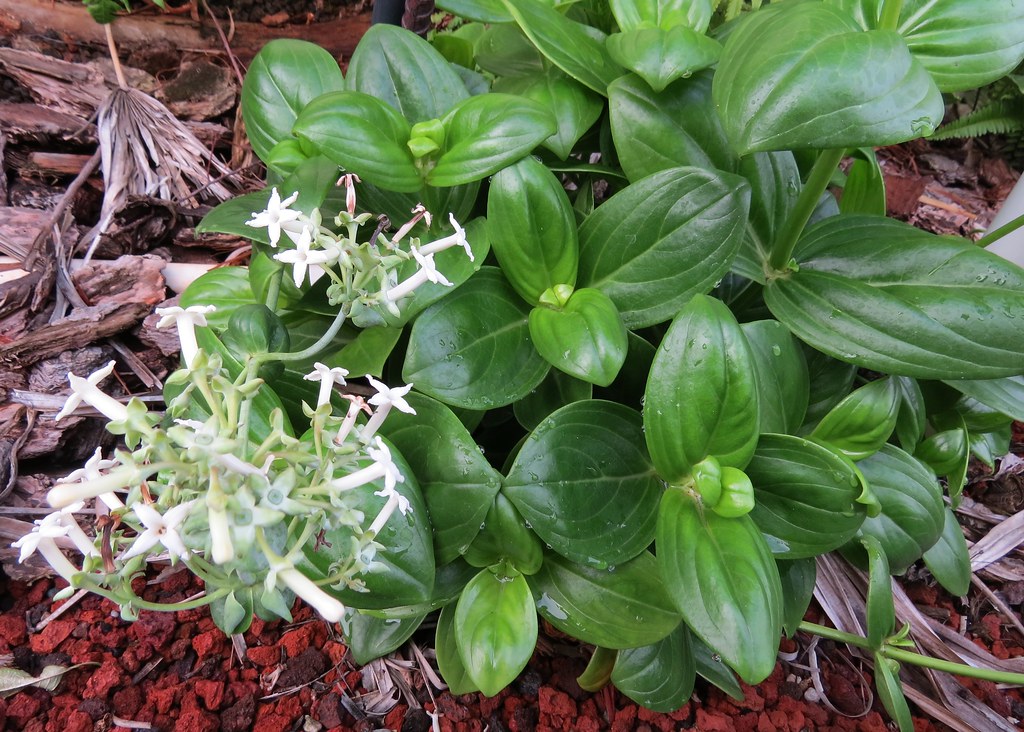

Coastal Lysimachia - Lysimachia maritima
A low crawling herbaceous groundcover with light green, succulent leaves and white flower clusters. The leaves emerge radially out from the center giving it a nice shape, while the flower clusters protrude up above the rest of the plant, allowing them to be shown off. Once pollinated the flowers develop into small light brown seed capsules, each containing numerous, tiny, dark brown seeds.
Other than using the flower clusters in head lei, there are no other known uses for this plant in Hawaiian culture.
Hala - Pandanus tectorius
A medium sized tree up to 30+ ft. with long spiny leaves and many prop roots.
Leaves for weaving mats, sails, thatch. Fruit for leis, dye brushes. Roots for cordage, medicine.
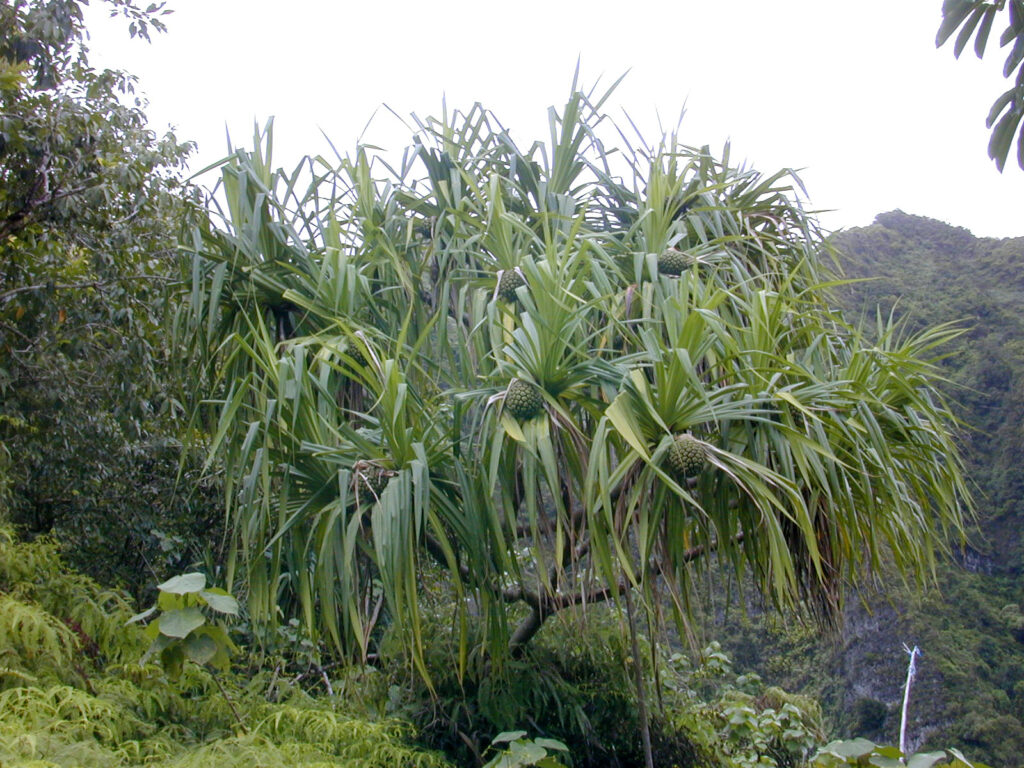
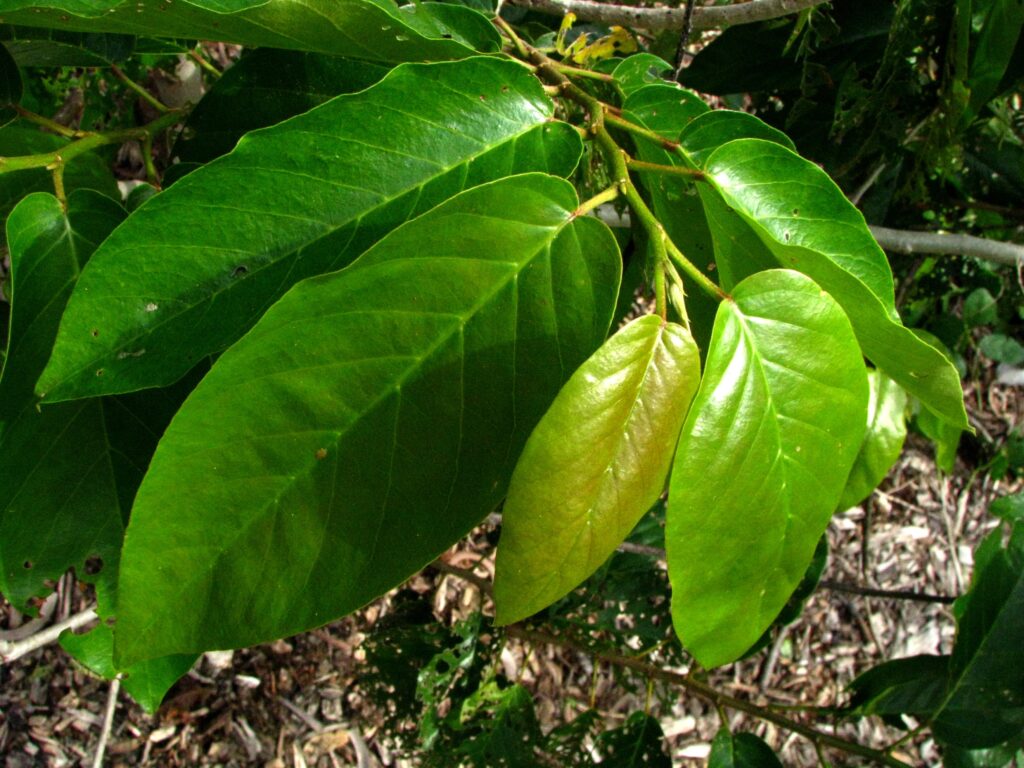
Hame - Antidesma pulvinatum
Endemic: O’ahu, Moloka’i, Maui, and Hawai’i.
These are small trees up that can grow anywhere between 6-25 ft. tall.
They have beautiful foliage in terms of their color: which is a glossy maroon when young and a glossy dark green when older; their shape: elliptical with clean margins and a sharp apex; and their arrangement which alternates tightly along each branch. Flowers develop on panicles which turn into small reddish-purple grapelike fruit. The contrast between the young leaves, mature leaves and fruit make this plant very attractive.
The hardwood of hame is used to make anvils either for beating kapa or even more for preparing olona (kahako over the a) (Touchardia lattifolia) to make cordage. The dark reddish-purple berries are also used to make a dye for kapa.
Hao - Rauvolfia sandwicensis
These plants are one of a few native plants related to Plumeria, which is not native. They are gorgeous trees which can reach heights up to 30 ft. but generally are in the 5- 15 ft. range with great looking elliptical leaves that form whorls of up to seven leaves per node. Each leaf has smooth margins, is bright green with a yellow mid-rib and is about five inches in length. The flowers are very tiny, white and emerge on clusters just like Plumeria and have a fragrance very similar to it; surprisingly they are very easy to smell considering how small they are. Once pollinated, the flowers will form small fruit about ¾ of an inch across which eventually turn dark purple/black when ripe. The outer bark is a very light tan as is the inner wood which is very hard hence the name “hao” which is also the Hawaiian word for iron or any iron tool. Like the Plumeria, hao also bleeds a milky sap when either leaves or stems are broken.
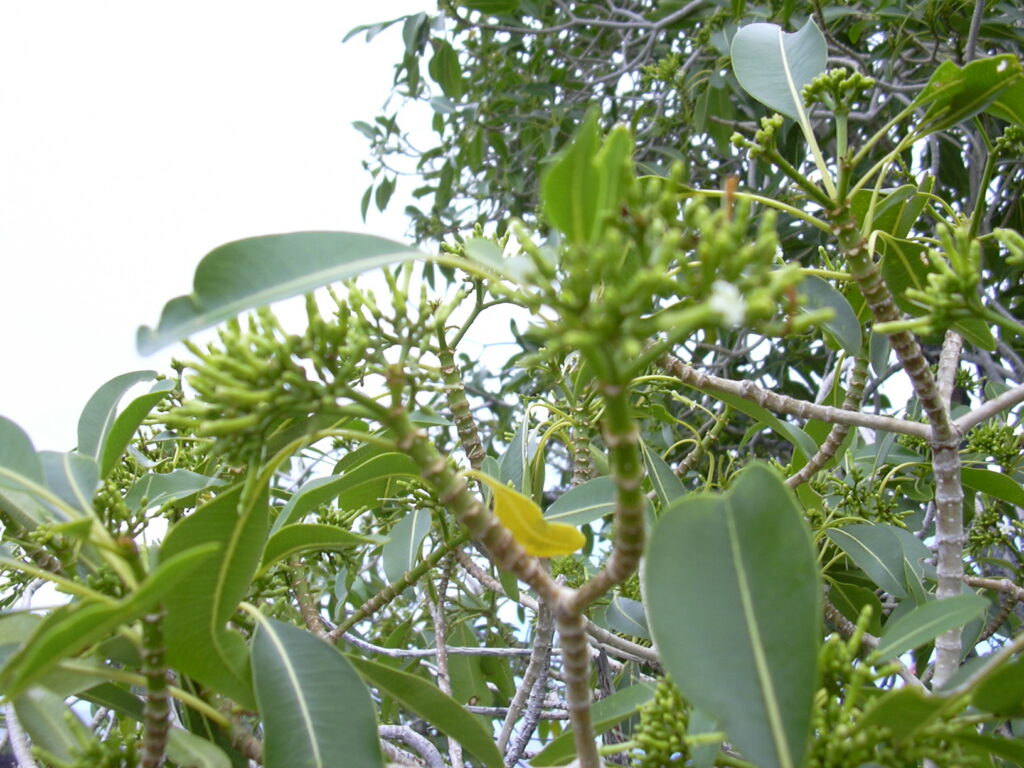
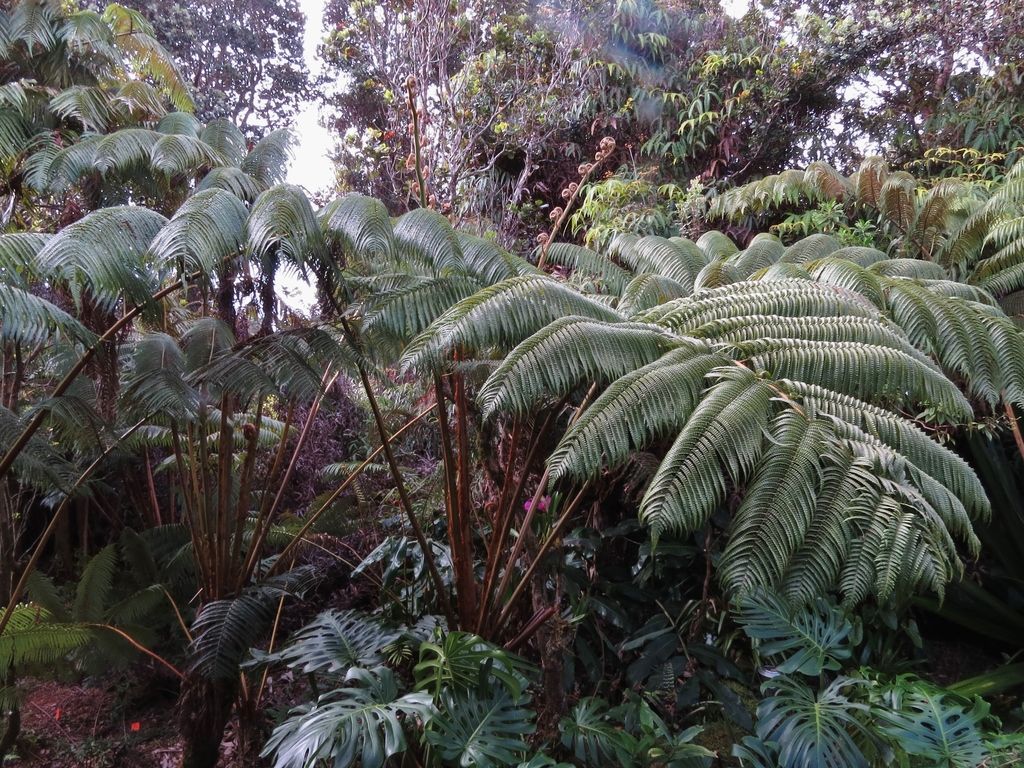
Hāpuʻu - Cibotium glaucum
Beautiful tree ferns with large fronds that have bluish green undersides and soft “pulu” at the base of the fronds and on new frond fiddleheads.
The starch within the trunk was cooked and eaten in times of famine while the pulu is used in burial ceremonies and to aid in cleaning out digestive tracts.
Hau Hele ʻUla - Kokia drynarioides
A beautiful hibiscus tree with large maple-like leaves and gorgeous salmon colored flowers with petals that ruffle and tweak backwards, very unusual. This plant can be quite tall for a hibiscus, reaching heights of up to 25 ft. plus.
A pinkish dye can be made from the flowers of this plant as well as a darker reddish dye derived from the bark used to color fishnets. There is also documentation of the flowers being used for lei. A good picture of this plant used in lei can be seen in the book Na Lei Makamae by Paul Weisich and Marie McDonald.
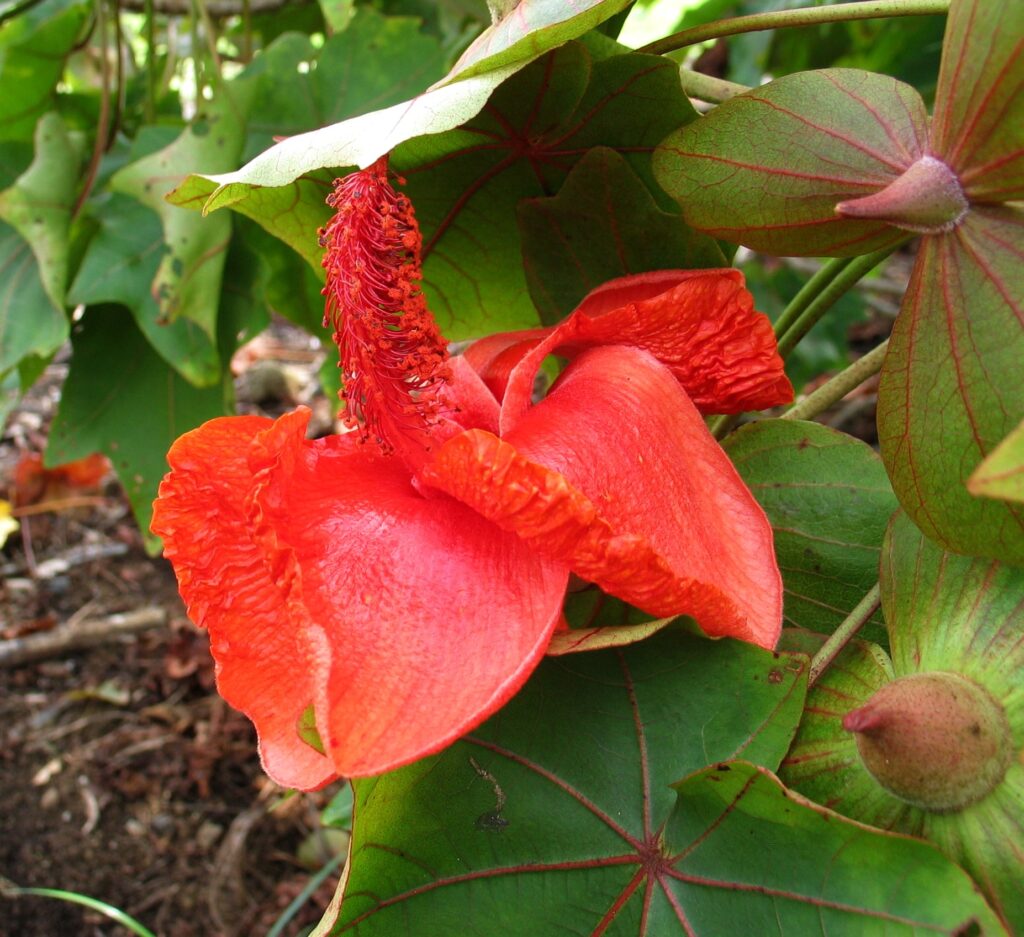
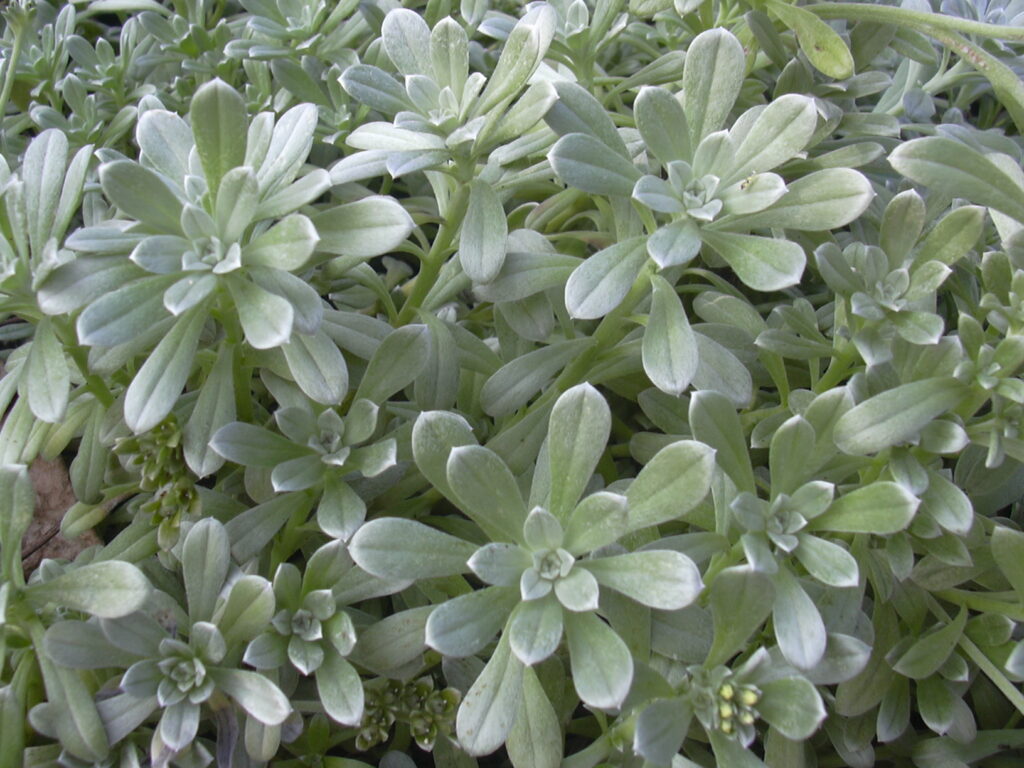
Hinahina - Heliotropium anomalum var. argenteum
A prostrate ground cover with one of the nicest smelling flower clusters of all the native Hawaiian plants. Each flower cluster is comprised of up to 15 small white flowers that protrude up above a tight, silvery rosette of leaves.
The flowers and leaf rosettes are highly prized and valued for lei making. It would be nice to have this plant in your own yard that way all your lei making material is there for your use and you wouldn’t have to go out and potentially diminish what few plants remain in the wild.
Hōʻawa - Pittosporum hosmeri
Endemic: Hawaii Island Only
These are usually small trees up to about 20-25 ft. tall with long tear-drop shaped leaves. The young leaves as well as the underside of the more mature leaves are usually covered with minute, golden-brown hairs. Their flowers emerge as “manapua” shaped clusters which protrude right out of the stems. Once pollinated, they develop into large nut shaped capsules that are almost cubicle in form and about three inches long and 1-2 inches wide. Inside are numerous reddish-black seeds which totally stand out against the bright orange inner surface of the seed capsule.
There isn’t much known about this plant from a cultural point of view but in nature it is interesting to see the seed capsules when they become ripe. At this point they open up by fold back and exposing the bright orange inner surface and dark seeds within. This is to attract birds that feed on the oily seeds and help the plant with seed dispersal. In fact this is one of the favorite foods of the nearly extinct Hawaiian crow the ‘alala.
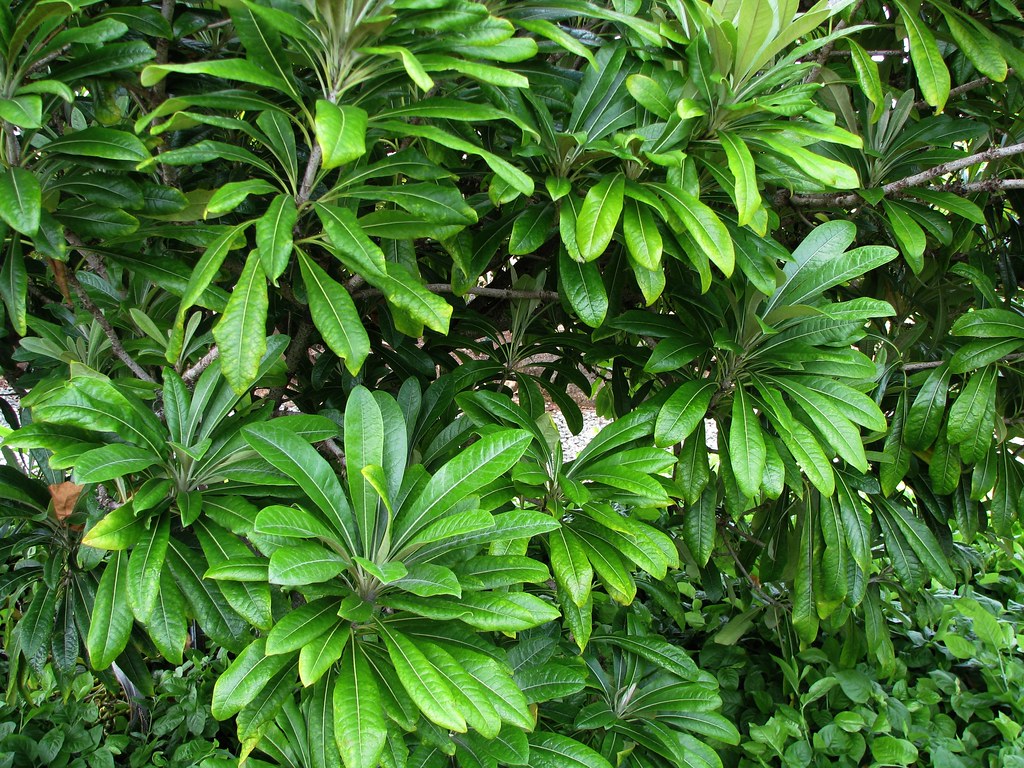
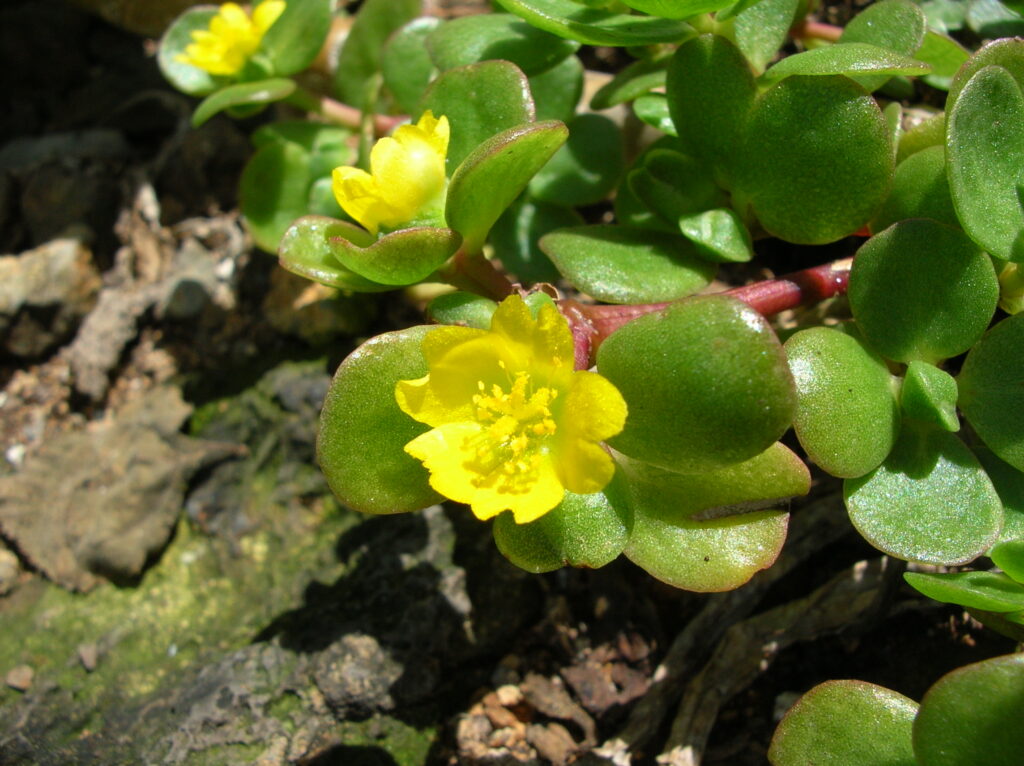
ʻIhi - Portulaca lutea
Indigenous: Northwestern H.I., Oahu, Molokai, Maui, Lanai, and Hawaii
Prostrate herbs with thick stems and tightly arranged, alternating leaves which are rounded and very succulent (very similar in apperance to the dwarf jade plant, only this plant is prostrate). On the top of the stems a small cup of leaves hold a cluster of yellow flowers each one about an inch and a half in diameter. This plant closely resembles and introduced Portulaca often referred to as pigweed, but that plant has very small yellow flowers about a quarter inch in diameter and often has softer stems that are red towards the base whereas the native one has a light tan, almost woody looking base.
ʻIhi Molokini - Portulaca molokiniensis
Endemic: Molokini, Kaho’olawe
Short and stocky is the best description for these rare succulents. They have thick leaves that usually cluster towards the top of an even thicker stem. These plants usually branch up from the ground and look more like tiny cactus than Portulaca. They also have a cluster of bright yellow flowers that sit in a cup of leaves which rises up from a long tube above the plant, they’re really cool looking. By far these are one of the most exotic looking plant specimens from Hawai’i if not the world.

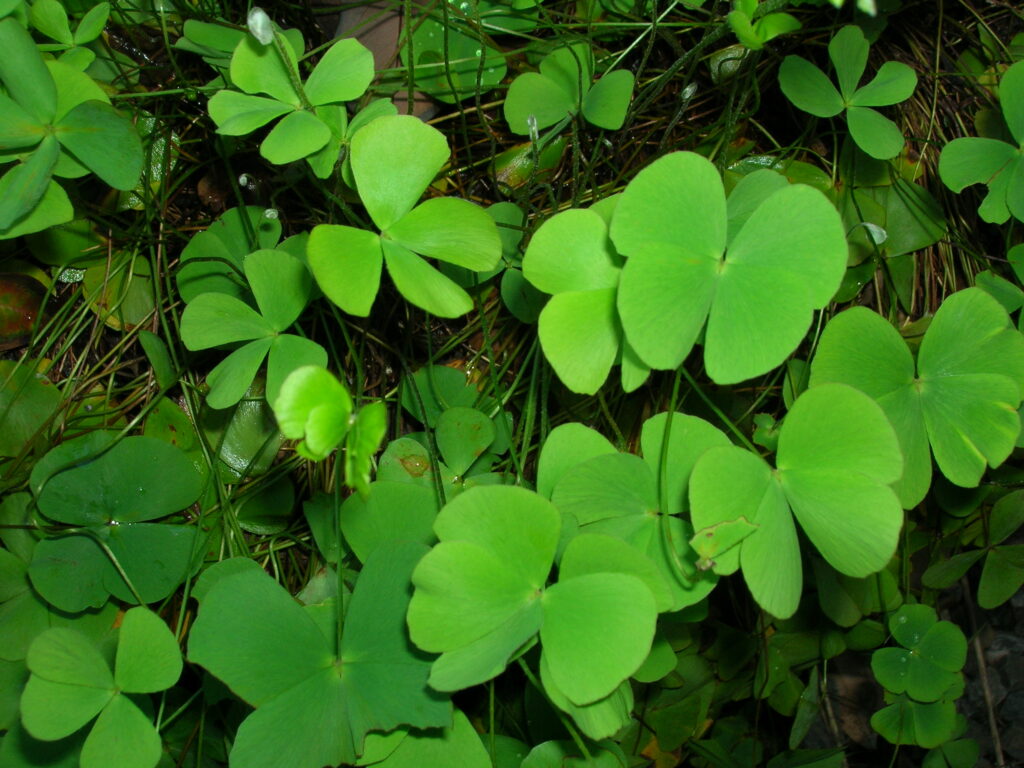
ʻIhiʻihilauākea - Marsilea villosa
Endemic, Endangered
As much as it looks like it, ihiihilauakea is not a four-leaf clover. In fact, it is not a flowering plant at all, but a tiny fern reaching up to 6 inches. This petite plant with an oversize name sprawls across the ground with tendril-like rhizomes and periodically sends out a four-petal frond on a stalk no thicker than a strand of hair. At night the fronds fold up, then open again after the sun rises.
ʻIliahi - Santalum ellipticum
Also Known As: Sandalwood
Large bushy shrubs or trees up to 15 feet tall, but usually 4 to 8 feet tall, with elliptical, pale, green-blue leaves and fragrant flower clusters that are light green with hints of salmon or orange. Once pollinated, the flowers develop into round fruits that ripen to a dark purple and have a single hard seed within. The most appealing feature is its sweet-smelling heartwood, which retains the sandalwood fragrance for a long time.
The sweet-smelling wood of ‘iliahi is used to scent kapa, and the flower clusters can be used in leis.
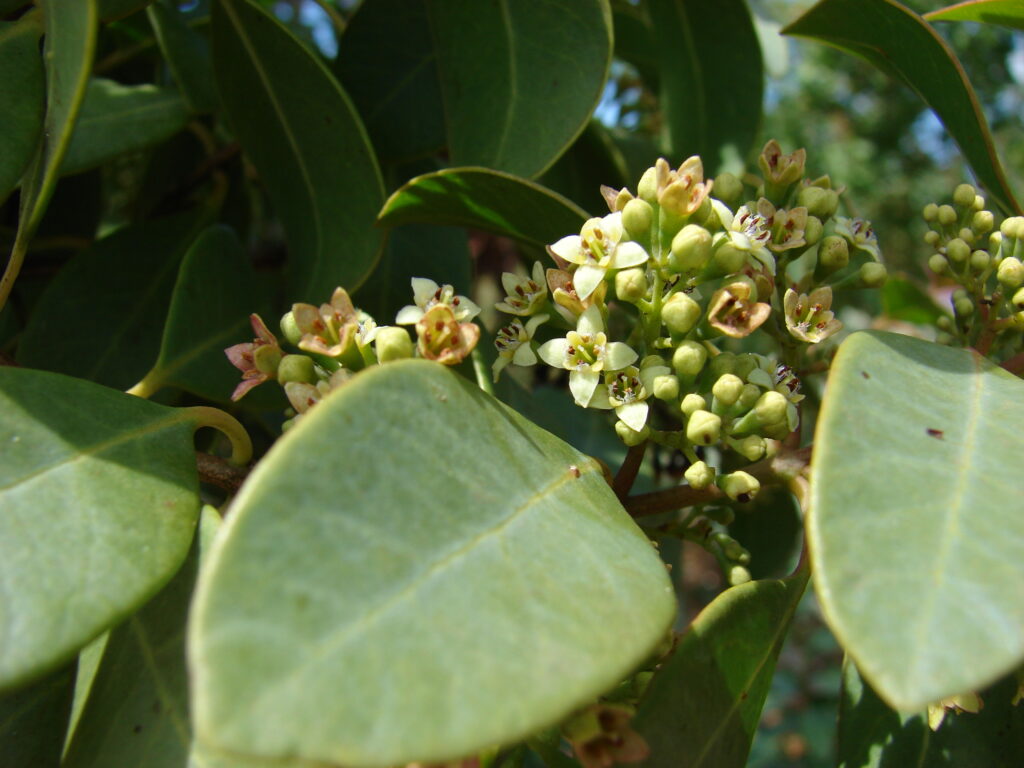
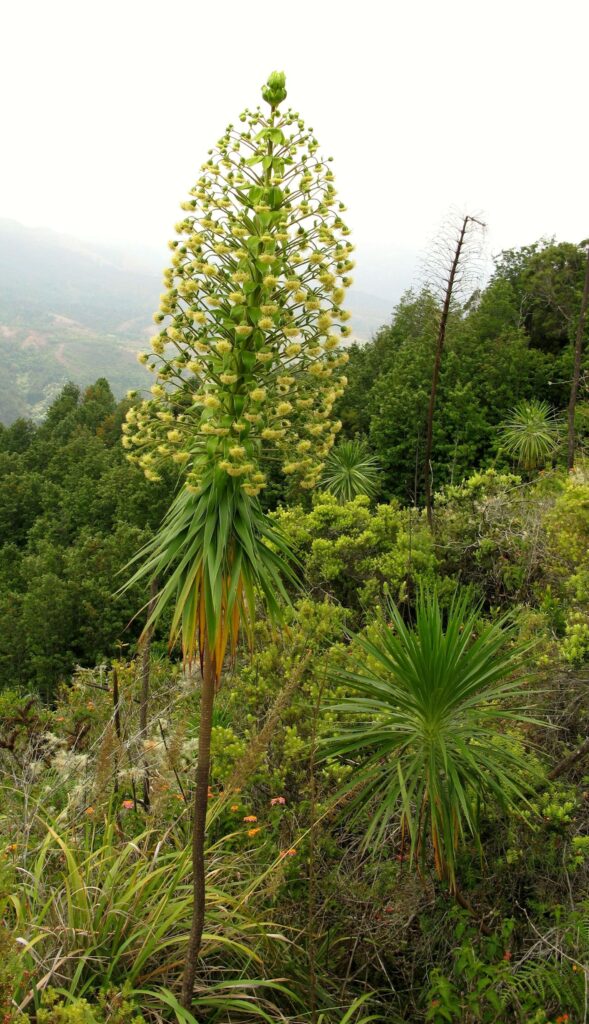
Iliau - Wilkesia gymnoxiphium
Also Known As: Kaua’i Greensword
Endemic: Kaua’i Only
Erect, normally unbranched rosette shrubs 3-10 ft. tall with long, narrow, green leaves and slightly fragrant, cream colored flowers arranged in heads of 40-350 on a stalk that protrudes above the whole plant. Towards the evening, this plant (not the flowers) is known to give off a slight, but pleasant scent, closely resembling that of a white ginger flower. Undeniably, one of the most intriguingly exotic looking plants native to Hawaii. It should be said that this plant is related to the silverswords (read the info. below) and just like those plants, these plants take at least 7 years to flower and once they do….. they die. But, the bloom is definitely worth the wait and the eventual outcome.
ʻIlieʻe - Plumbago zeylanica
Indigenous: All HI
A low sprawling shrub with long stems, light green foliage and clusters of bluish white flowers that emerge at the stem tips. Once the flowers are pollinated, small, cigar shaped fruits that are slightly sticky will begin to develop.
The sap of ’Ilie’e is used by Hawaiians to blacken tattoos.
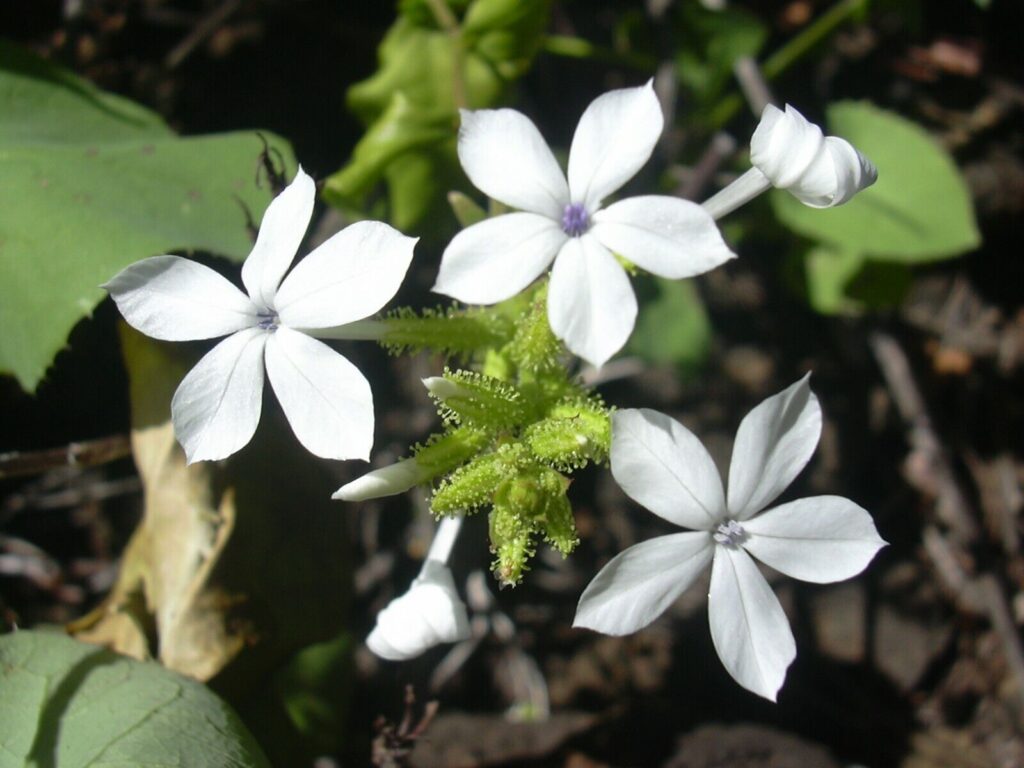

ʻIlima - Sida fallax
Also Known As: Black Coral
There are many different varieties of ‘ilima in Hawai’i. On the coast, ‘Ilima papa (flat ‘ilima) grows prostrate, perhaps up to a foot tall, while others in dry and mesic forests grow into bushes up to four to six feet or so. All have rounded green leaves with serrated margins but the mountain varieties tend to have more of a pointed apex on the leaf tip. Some coastal varieties have leaves that are covered with extremely soft, velvet-like hairs which are actually an evolutionary adaptation to reflect sunlight and prevent the plant from drying out but are really nice to touch. Their flowers for which they are most known for are about an inch in diameter and a rich orange hue, they are also very soft but at the same time very fragile.
The flowers of ‘Ilima can be strung into lei and they are also used as a mild laxative for babies.
ʻIlima papa - Sida fallax
Groundcover ʻilima
Description: Prostrate plants with pale green leaves, woody stems and bright orange flowers. There are many different varieties of ‘ilima, although they have the same botanical name, morphologically they appear quite different. Some types grow into bushes while others, like this one, lay flat. Even leaves and flowers may look different between dissimilar varieties.
Uses: ‘Ilima is the island flower of O’ahu and is used to make lei ‘ilima. The flowers can also be used as a mild laxative for babies. You can even put some in your tossed salad to add nice color by pinching them out of their calyxes (the small green cup that the petals emerge from), don’t worry about it being a laxative, it only works for babies. You would have to eat half a lei to make it work for adults but if you need to go then just keep pickin’. I’ve even used the flowers as a garnish for sashimi, it looks nice and tastes way better than parsley.
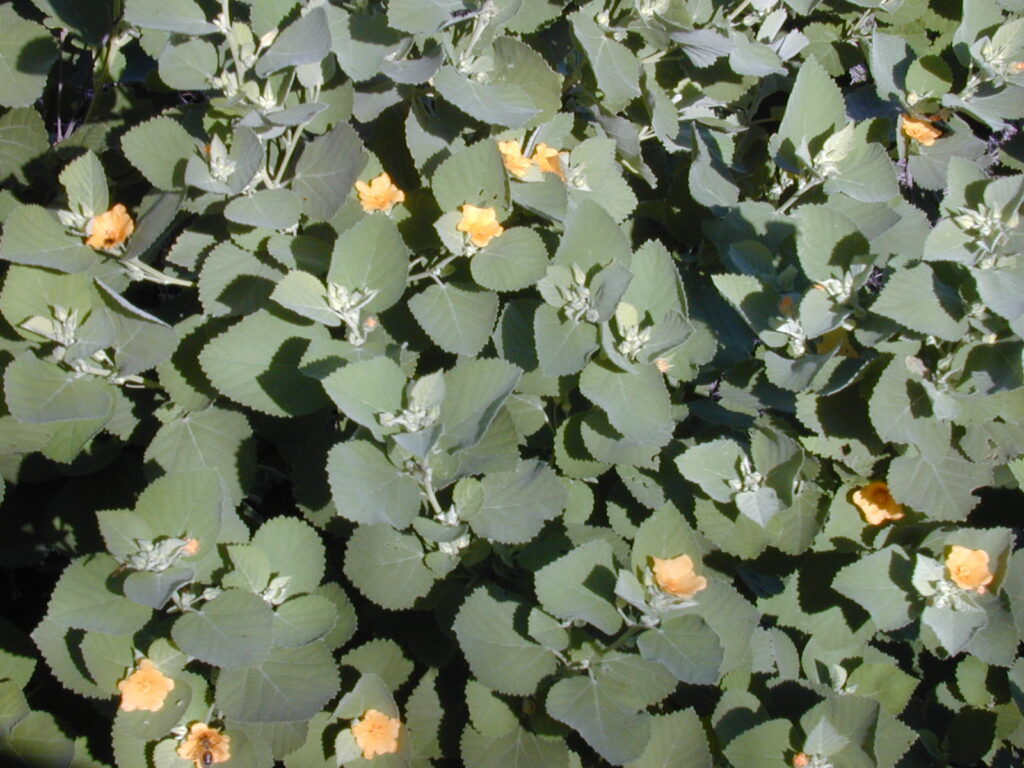
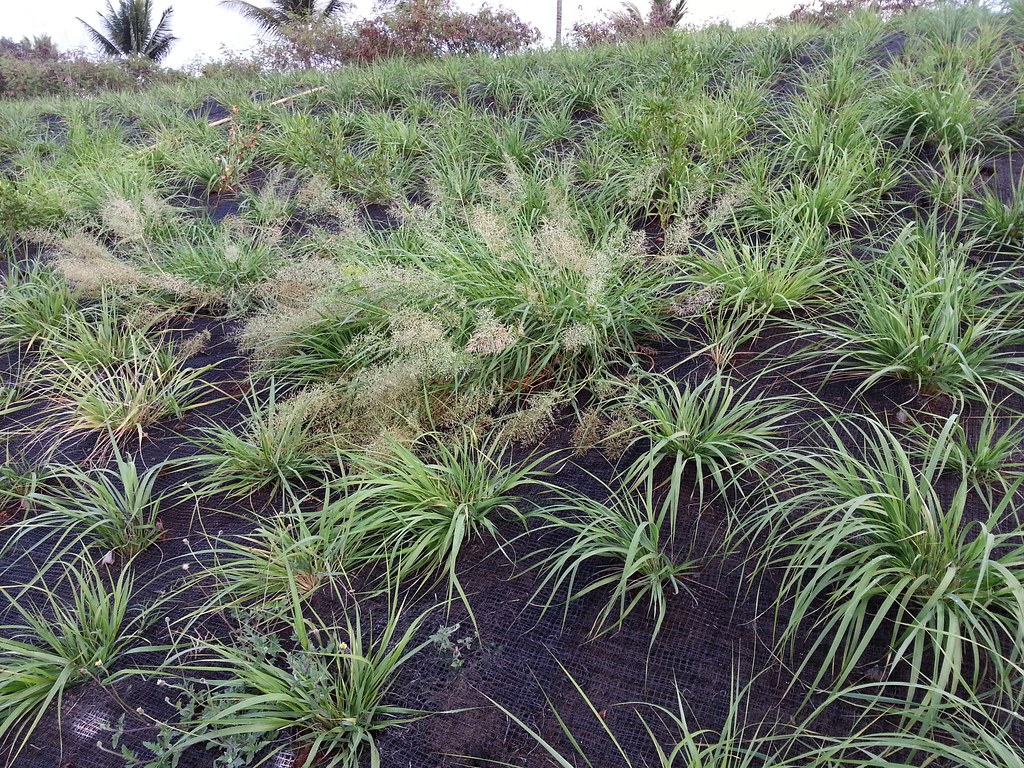
Kāwelu - Eragrostis variabilis
Endemic: All HI including most of the Northwestern Hawaiian Islands
A perennial clumping grass with long, slender, bluish-green leaf blades that reach over two feet in length. When in bloom, a panicle of tiny flowers will protrude up on a stalk which displays them. Sometimes the flowers cluster together tightly other times they are more open as in the picture above.
Many chants and hula refer to this plant for the way it moves and flows in the wind, similar to that of a graceful hula dancer.
Kī - Cordyline fruticosa
Polynesian Introduction
Shrub (6-10ft.) with large green leaves and few branches.
Leaves: thatch, food wrappers, hula skirts, sandals. The sweet roots were baked and eaten or used to make an alcoholic beverage called ‘okolehao.
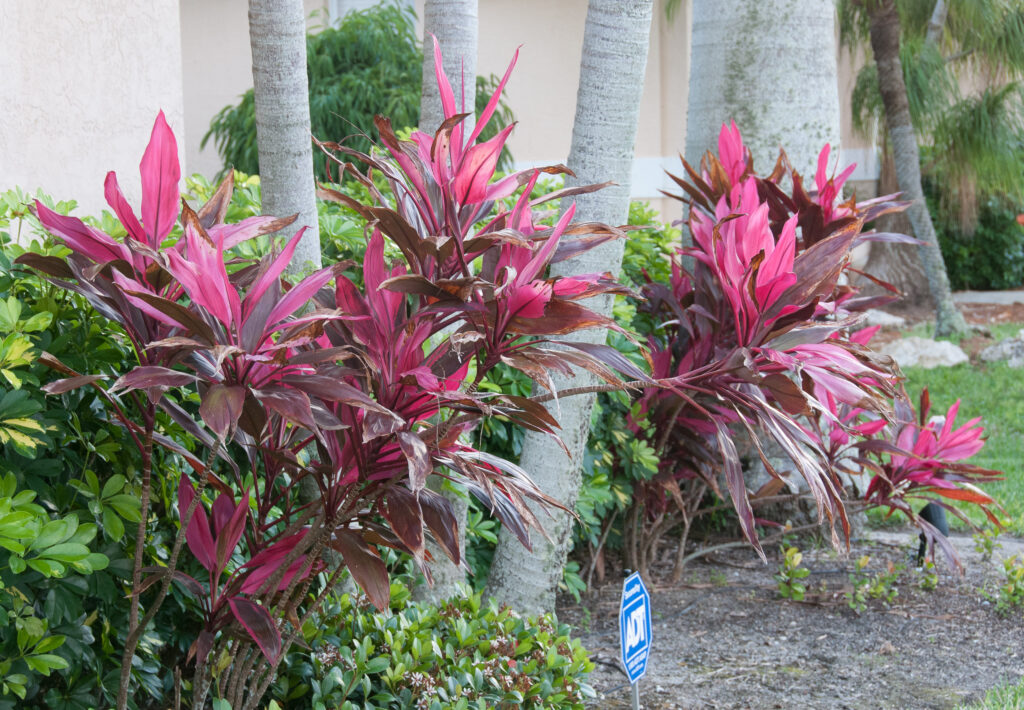
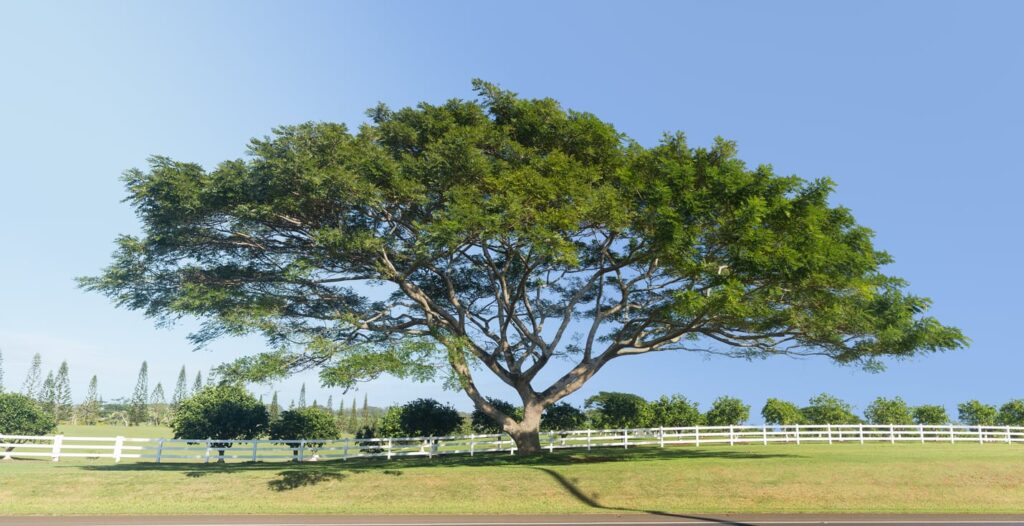
Koa - Acacia koa
Endemic: All HI except Kaho’olawe and Ni’ihau
These are large trees that on other islands, mainly on Kaua’i, Maui and Hawai’i that can reach over 100 ft. tall. It is easily distinguished by its light colored, flattened out, sickle shaped, modified stems (which look like its’ leaves). These special stems called phyllodes are packed with chlorophyll and take the place of its true leaves in more mature plants. When a seedling, the koa plant has bipinnate compound leaves, much like its other non-native cousin the koa haole.
Koaiʻa - Acacia koaiʻa
Endemic: All HI.
A tree with the same physical resemblance to Koa but only smaller (up to 15 ft.). It has the same sickle shaped foliage, which aren’t actually leaves but modified stems called phyllodes. It also has harder, more dense wood and longer, narrower seed pods with a different arrangement of seeds. Some sources list this tree as a variety of Koa while others separate it into its own species.
The very hard wood of this small tree is used to make many useful tools including kapa anvils and spears. The name koai’a comes from combining the two words koa (like the koa tree) and i’a (fish), since the wood from this plant was used to make fish hooks but more specifically due to its durability, shark hooks.
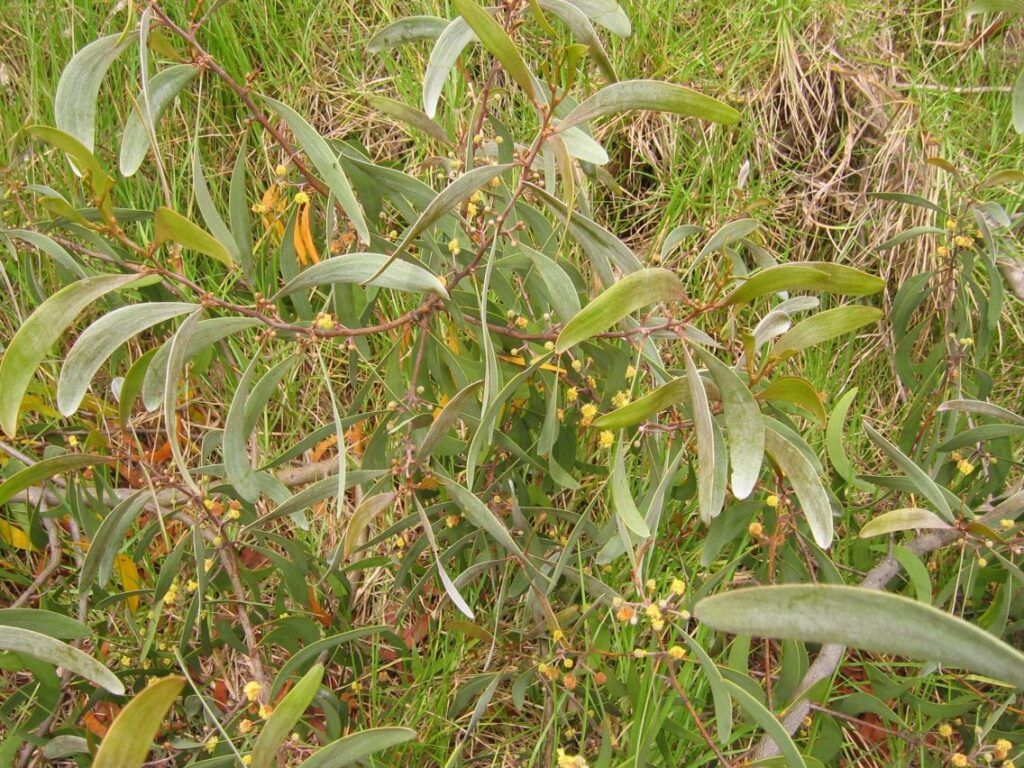
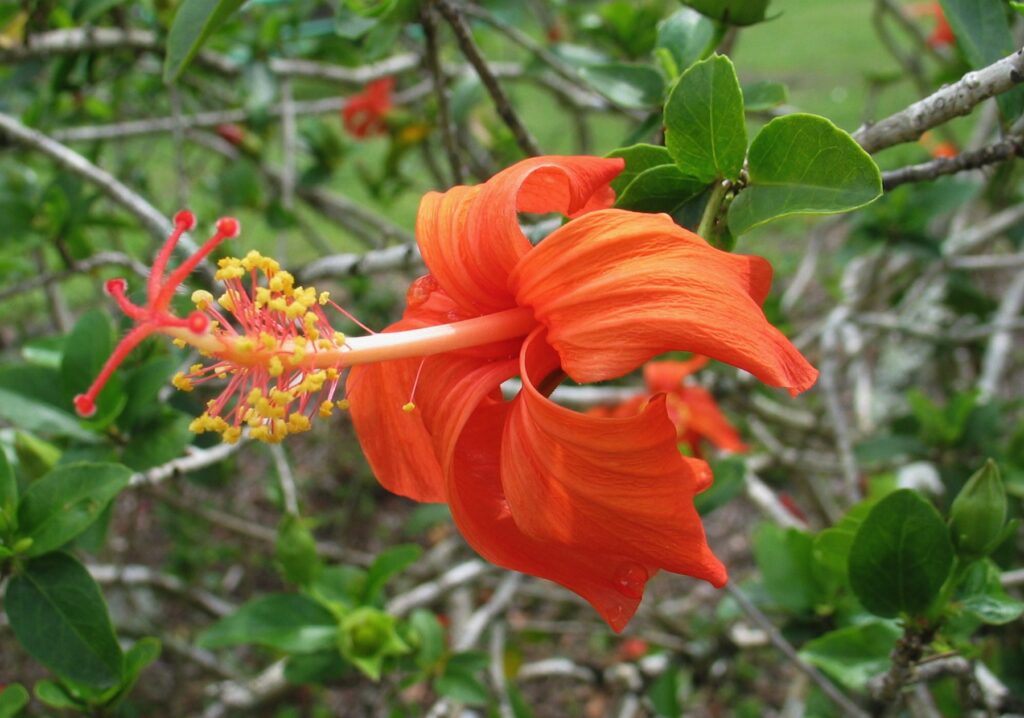
Kokiʻo - Hibiscus kokio subsp. st.johnianus
Native Hawaiian Shrub – Endemic – Rare
Ok, if you can find a more beautiful Hibiscus species than this one I gotta see it to believe it. I don’t know what it is about this flower that draws me to it but it is truly a spectacular event to witness. And don’t think that I’m over exaggerating when I say event because once you see it you count the days before the next flower bud blooms, trust me, other people that own this plant tell me the same thing. In fact someone just told me that they saw this flower blooming in the store from a distance and had to walk across the garden department just to see it up close. It drew her in, spell bounded by its beauty. This is a gorgeous shrub that is generally 4-10 ft tall. It has dark glossy green leaves with some varieties having reddish petioles that connect the leaves to the stem. But of course the most distinguishing feature of this plant is its amazing flowers. By far I feel they are the most striking of hibiscus, it has bright orange to orange red flowers that are so vivid, they almost look fluorescent.
Flowers used in lei as well as for a laxative. Ironic how something so beautiful is used to make something so un-beautiful (and I’m not talking about the lei).
Kokiʻo Kea - Hibiscus waimeae
Endemic: Kauai
Unreal shrubs or small trees up to 15 ft. tall but usually stay in the 5-8 foot range. These plants have light green foliage which is densely pubescent on the underside and less pubescent on top which makes the underside an even lighter green. The most attractive feature of this plant is its beautiful white and also fragrant flowers which emerge at the tips of branches. In the morning, the flowers open up and are a brilliant white and by the end of two days they slowly fade to a light pink and begin to close up before falling off. The petals of this hibiscus are very robust and thick which enable it to stay open for so long and which also adds to it’s stronger than normal fragrance. The staminal column is reddish pink which makes it stand out against the white petal background but it is shorter and more robust than other native whites.
The flowers of Hibiscus were eaten as a laxative and some sources say that the native red hibiscus were eaten by girls and women while the white hibiscus were eaten by boys and men. In addition the flowers were also strung into lei but today it is most often put behind the ear.
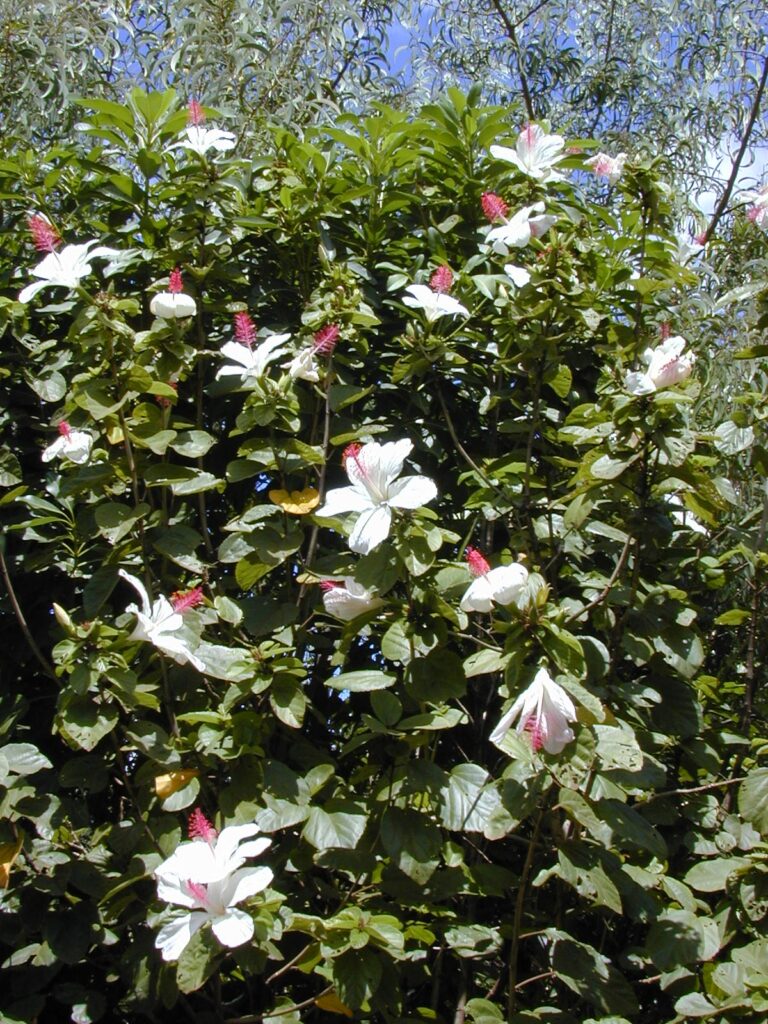
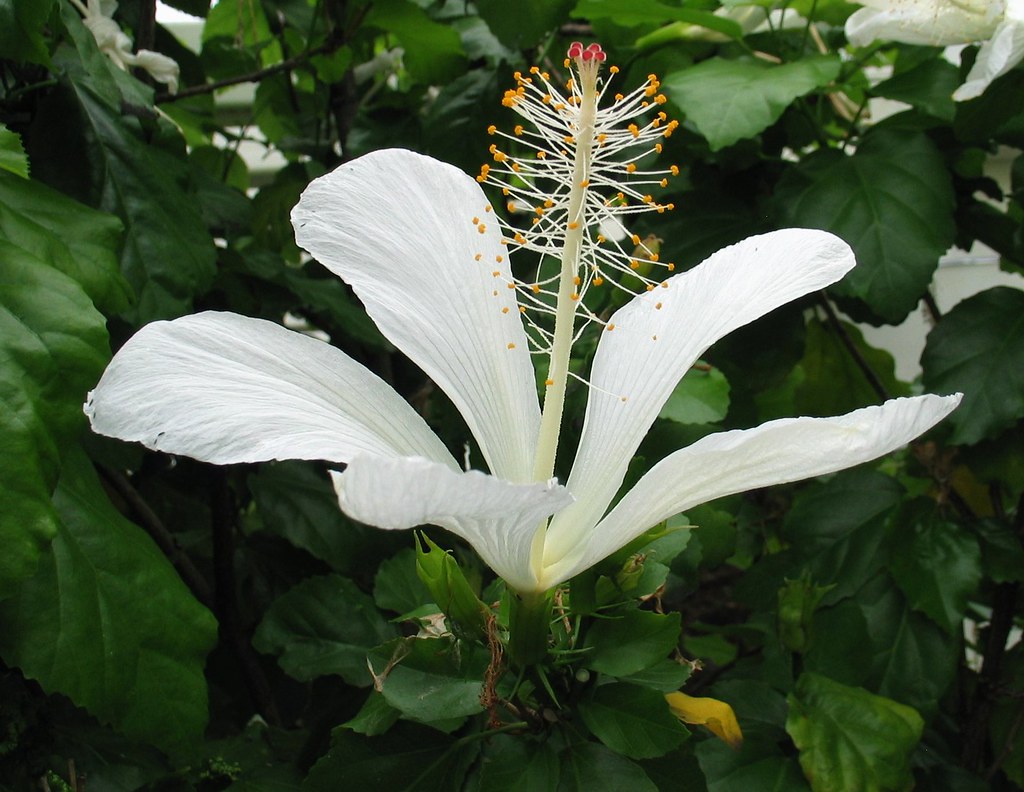
Kokiʻo keʻokeʻo - Hibiscus arnottianus subsp. immaculatus
Endemic – Endangered
This much-sought-after shrub can reach the height of a 15-foot tree but usually stays in the 5- to 8-foot range. It has light green leaves that are large compared with the typical Hibiscus waimeae, but its flowers are one-fifth the size of its more common relative. They do have one thing in common: the color and scent of their flowers. Both are bright white with a light pink stamen, with a slight fragrance.
The flowers can be eaten as a laxative. Some say that the native red hibiscus was eaten by girls and women, while the white was eaten by boys and men.
Kokiʻo ʻUla ʻUla - Hibiscus kokio
A typical hibiscus shrub (4-10 ft. tall) with extremely glossy, dark green leaves and small red hibiscus flowers.
The flowers of this plant were used as a mild laxative and as a dye.
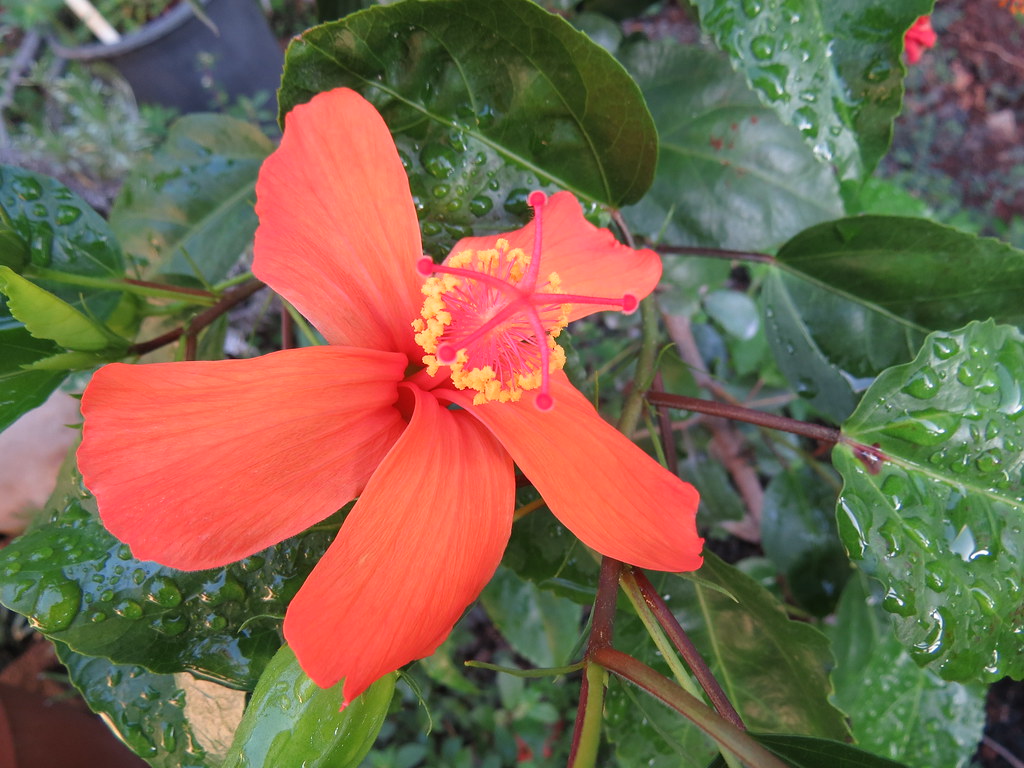
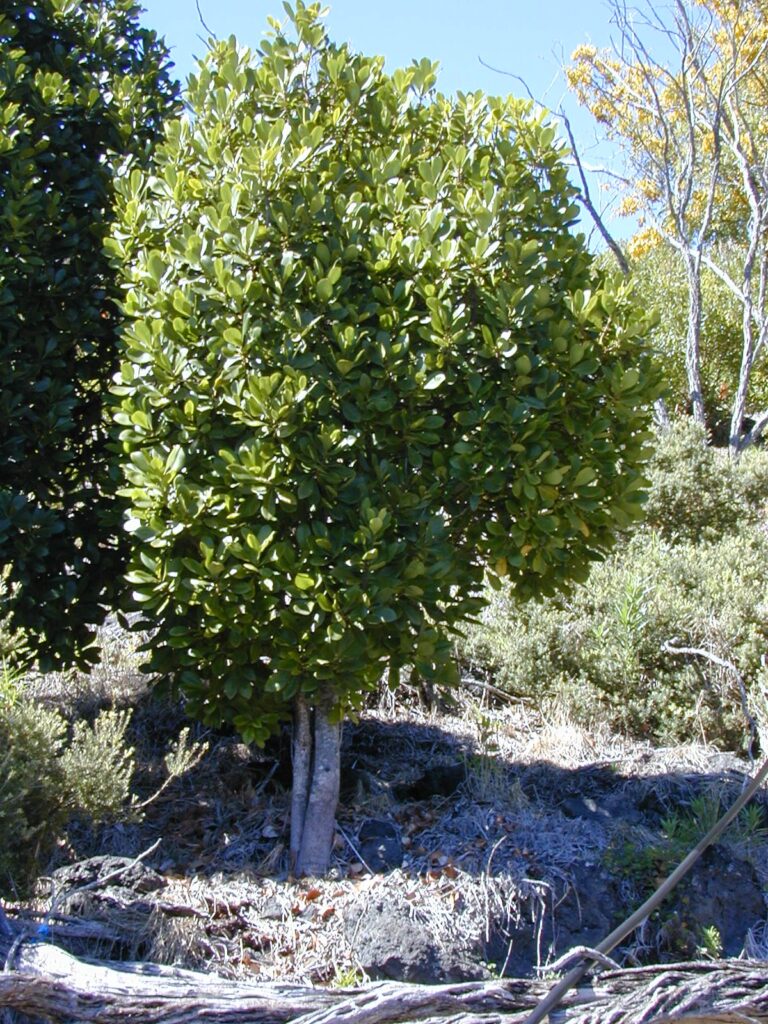
Kōlea lau nui - Myrsine lessertiana
Stunning trees or large shrubs reaching heights of up to 25 ft. tall. They have extremely glossy, light green leaves that when they are young (liko) are colored brilliantly pink. This is one of the most beautiful sites to see in the wild (or in the landscape) when all of the branch tip buds are starting to show new signs of growth and the tree is covered in pink. The flowers are small, green with purple tinges and emerge from woody knobs along the branches. Once the flowers are pollinated they develop into tiny black fruit about ¼” across.
The strong wood of kolea is used for posts and beams in the construction of hale as well as to make the anvil for beating kapa, while the red sap of the plant is used to make a red dye and the wood charcoal a black dye.
Kōlea lau li’i - Myrsine sandwicense
Endemic: O’ahu, Moloka’i, Lana’i, Maui and Hawai’i
Beautiful shrubs or small trees up to 20 ft. tall with small elliptical leaves that cluster up toward the stem tips. Like all kolea, the young leaves, called liko, are bright pink and add tremendous color to the plant. Small yellow flowers tinged with red and purple emerge from small woody knobs along the length of the branch. Once these are pollinated they develop in to tiny black fruit about ¼” in diameter.
The bright yellow-green liko with purple mid-vein and margins are highly sought after to make lei. Liko lehua is not the only type of liko that looks good in lei kolea lau li’i is right there next to it.
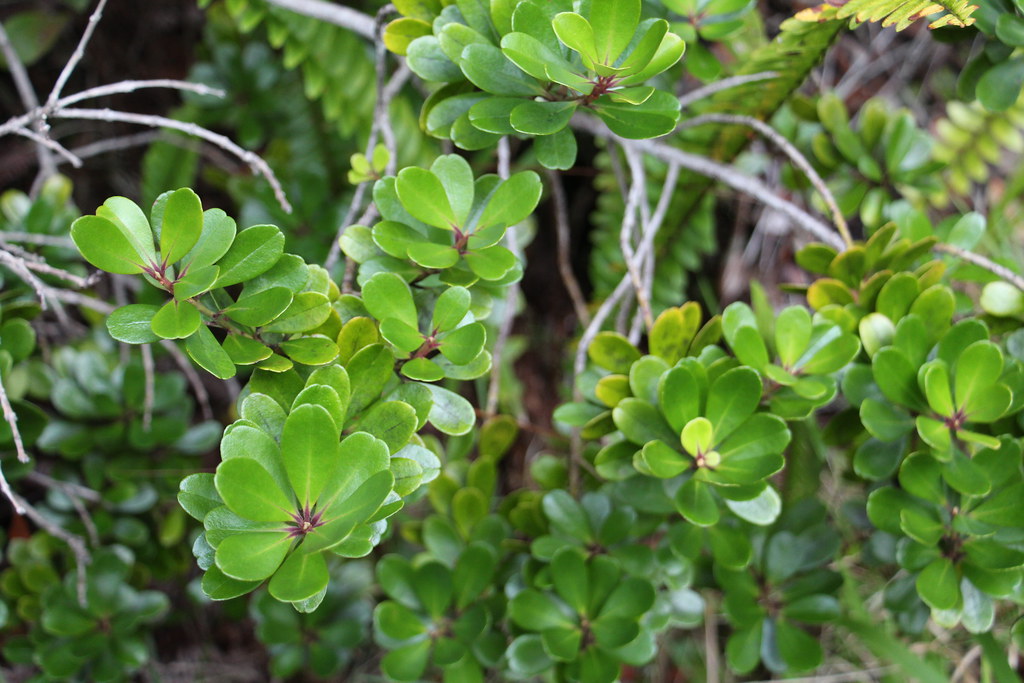
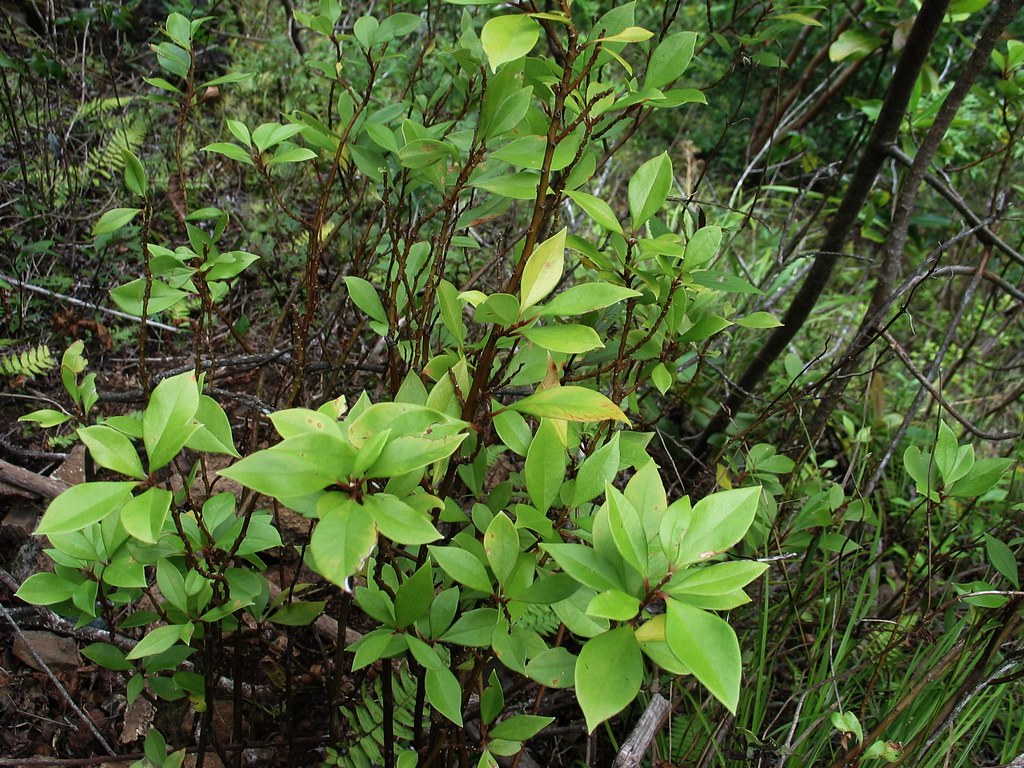
Kolokolo Kuahiwi - Lysimachia hillebrandii
A Sprawling shrub with dark green, oval leaves that have a pointed apex. New leaves tend to cluster toward the top of the stems, then later spacing out as the plant grows. The new braches as well as the veins on leaves are pinkish-red, then as the branch becomes older it will eventually turn woody. The flowers of this plant are most striking. They hang facing downward on stems that extend out past the leaves. Each flower is about 3/4″ in diameter and is light maroon in color with dark maroon veins on each petal. I’ve seen individual branches with over twenty flowers on them and they look awesome! The flowers will stay on the plant and don’t lose there beauty for about a week, sometimes even longer! Although this is a general description of this plant, don’t be surprised if you see something different when hiking, they are highly variable, especially in leaf shape, leaf orientation and size, pretty much the only thing static are its flowers. There are also a couple of other native Lysimachia that resemble this species found in the same type of habitat so you really have to know your stuff in order to distinguish them from one another.
The longevity and unmatched beauty of the flowers make this an ideal plant for lei making.
Koʻokoʻolau - Bidens amplectens
Endemic
Small shrubs usually 3 to 4 feet tall with dark green serrated leaves and many bright yellow flowers. The flower of this species is unique compared with other native species within the same genus.
For one, they are very large, usually 3 to 4 inches in diameter. Most other species in the genus (with the exception of B. cosmoides and B. valida) have smaller flowers. Second, the flowers have a pleasant fragrance similar to that of carnations. I’m unaware of any other native Bidens that possess that type of fragrance, if any at all.
Like other ko’oko’olau, this species can also be used to make tea. Pick the fresh leaves (flowers are OK, too), wash them off and boil them in water. No need to dry the leaves first – fresh leaves are healthier and they taste better. Pick enough leaves and flowers to cover the surface of the water in whatever size pot you are using, and enjoy!
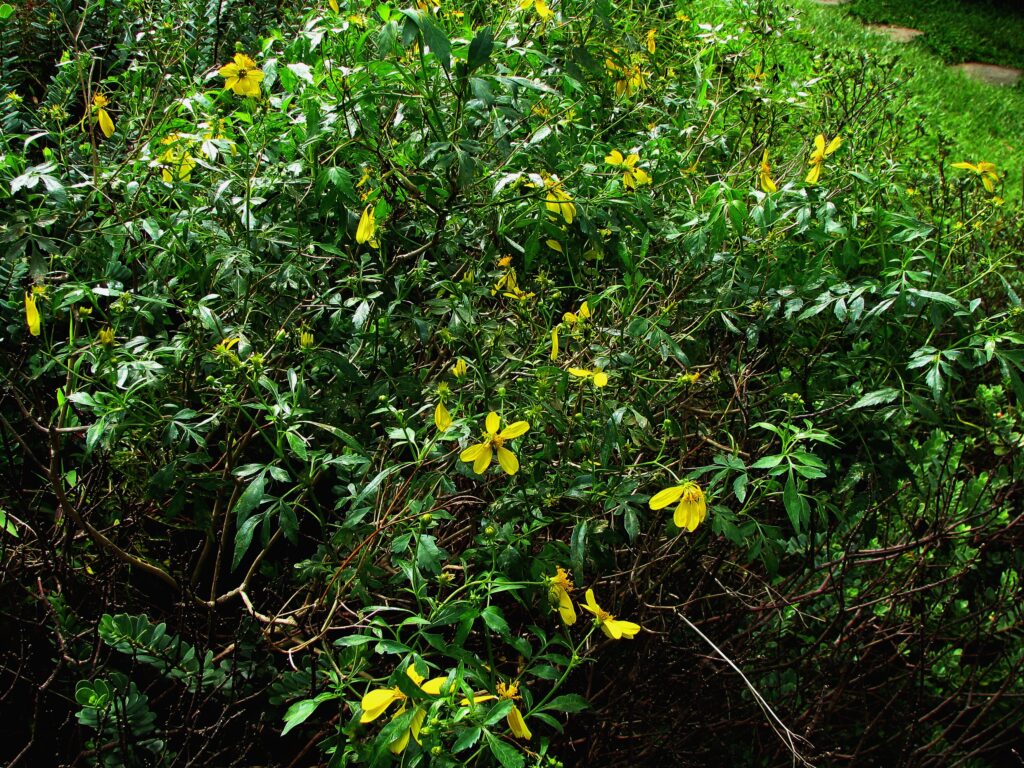
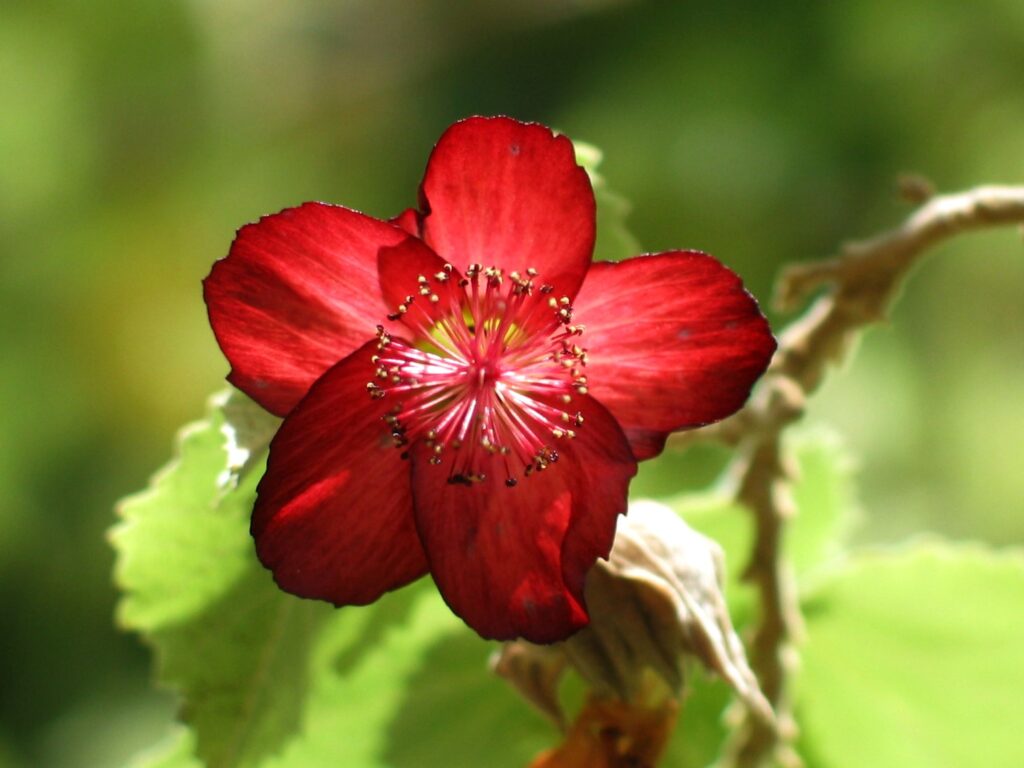
Koʻoloaʻula - Abutilon menziesii
The dense shrubs grow 4 to 8 feet tall with light green foliage. Leaves and branches are somewhat velvety to the touch. The plant’s most appealing feature is its flowers which range from dark maroon to bright yellow, and can be strung into stunning lei. The flowers, which are about 1- to 1-1/2 inches wide, emerge from the leaf axis and hang upside down. Flowers, sometimes hundreds of them simultaneously, bloom throughout the year. If enough flowers are gathered, a subtle, but sweet fragrance is noticeable.
Kūkaenēnē - Coprosma ernodeoides
Very cool looking low sprawling shrubs, which in most cases look like ground covers. Although the main look of the plant is herbaceous, to the touch it is very stiff and rigid. Tough, tiny leaves that are triangular in shape cover the thick stems. Small, creamy yellowish-white flowers develop from within the leave axis and when pollinated form numerous shiny black fruit from which this plant is named. Yup, if you haven’t figured it out already, kukaenene means nene poop. Not for the smell, but for the look. Each tiny fruit kinda looks like a black licorice jellybean which also happens to look like the droppings of nene birds. What’s even more interesting is that these fruits are one of the favorite foods of the nene.
There are no known uses of this plant culturally but it is an important component to the ecology of the upper dry forests and sub-alpine regions of Maui and Hawaii. It is crucial to protect this plant’s habitat not only for the plant itself but for other animals like the endangered nene goose, our state bird, which depend on it and other native plants so greatly.
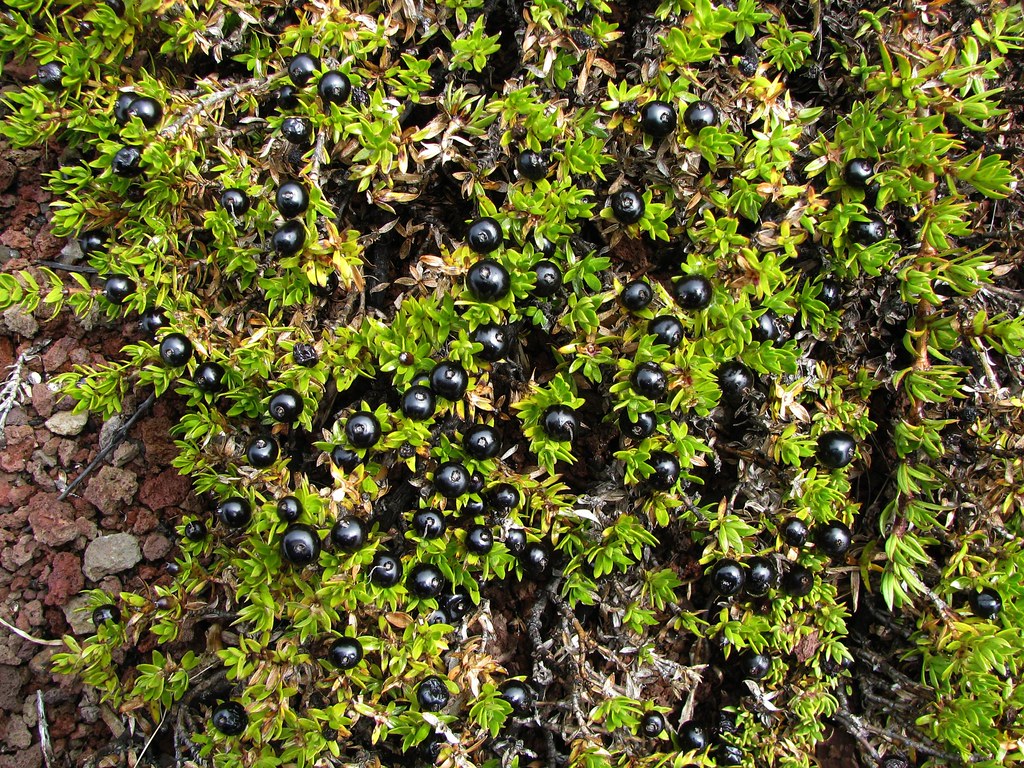

Kuluʻi - Nototrichium sandwicense
The kulu’i pictured here is the form that comes from Kaua’i. The underside, margins and veins of the leaves are extremely pubescent. In addition, the veins, stem tips and new leaf buds are tinged with pink. As a result, they shimmer and shine silvery-pink sparkles in the sun. The more sun it receives, the shinier the plant becomes. This kulu’i’s foliage is also very dense and the plant can reach a height of up to 4-7 ft. The flowers emerge in dangling spike clusters, 1-2 inches long that resemble teardrops.
The flower spikes and new leaves look great in head leis or flower arrangements.
Kupukupu - Nephrolepis cordifolia
A type of sword fern with erect fronds standing 1-2 ft. tall and 2-3 inches wide. Each frond is comprised of many smaller pinnae (frondlets), each about 1-11/2 inches long and about ¼ inch wide. Generally, these ferns are terrestrial meaning that their stolons (sprawling stems of ferns, which look like roots) spread out across the surface of the dirt but occasionally they will be epiphytic, crawling up trees or tree ferns. The most distinguishing characteristic of this fern is that it is the only species of Nephrolepis in Hawaii to have underground tubers that develop on the stolons which serve as food storage as well as a means to reproduce since new ferns will develop from it.
It was often used to decorate hula altars symbolizing that it was a place of learning, or sprouting knowledge since the word kupu means to sprout. The fronds are also used for making lei.
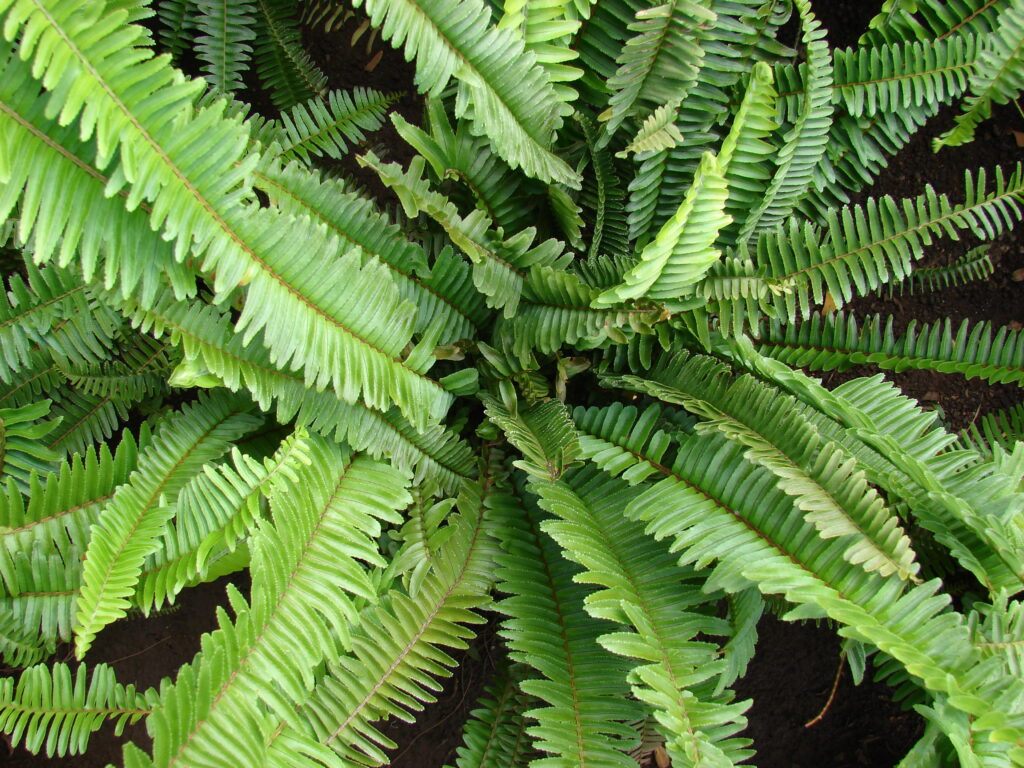
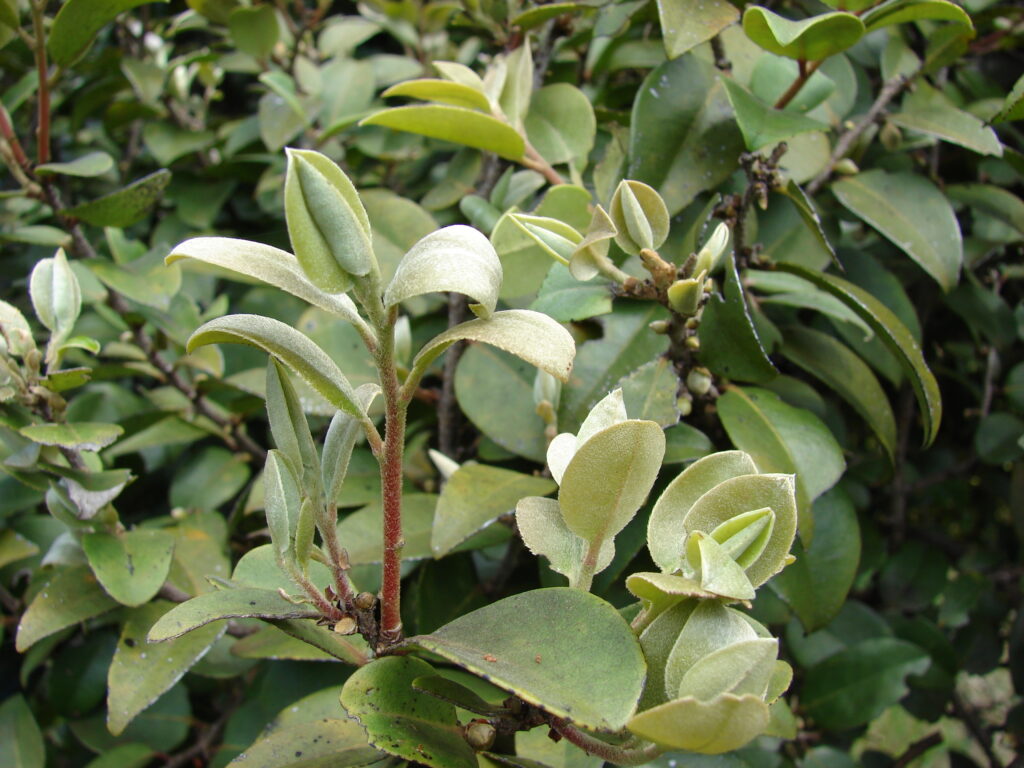
Lama - Diospyros sandwicensis
Also Known As: Hawaiian Ebony/Persimmon
Small to medium sized trees, 5-40 ft. tall that has a dark brown bark and pale green foliage. New leaves, called liko, are a bright pinkish-orange and are very attractive. Their flowers are tiny, about 1/8″ in diameter, and emerge at the leaf axis. Once pollinated small, oval shaped fruit that are about an inch in length develop. The color of the fruits starts off green, then change to yellow, and finally either orange or red when ripe. Each fruit can contain from 1-3 seeds. One of the most appealing features of this plant is its heartwood. Being part of the ebony family, lama wood is very hard and can be polished to reveal its deep, dark luster. It is a very slow growing plant so be patient when you plant it in the ground.
The wood of lama is used to decorate hula altars since its name is associated with enlightenment. The wood is also used to build houses for curing sick people as well as fence posts marking sacred areas.
Lonomea - Sapindus oahuensis
Stunning trees up to 45 ft. tall with dark, pale green leaves up to a foot long and three to four inches wide. The outer bark of lonomea is often a very light gray almost white color which adds great contrast to the leaves as well as any other dark background. The flowers are small and emerge on a skinny spike but the fruit are about two inches long, over an inch across and look like dried dates. Within the fruit is a large black, pear shaped seed that is somewhat rough in texture.
The black and naturally glossy seeds of lonomea were often strung into lei.
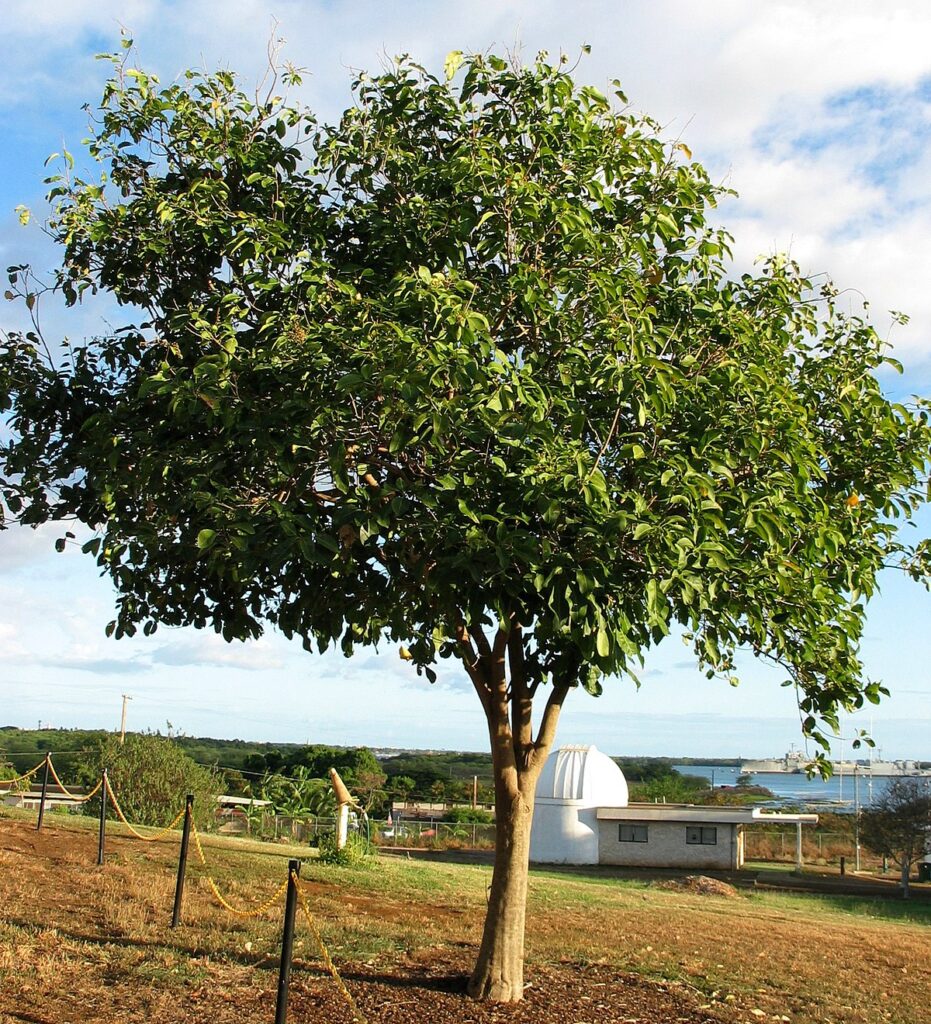
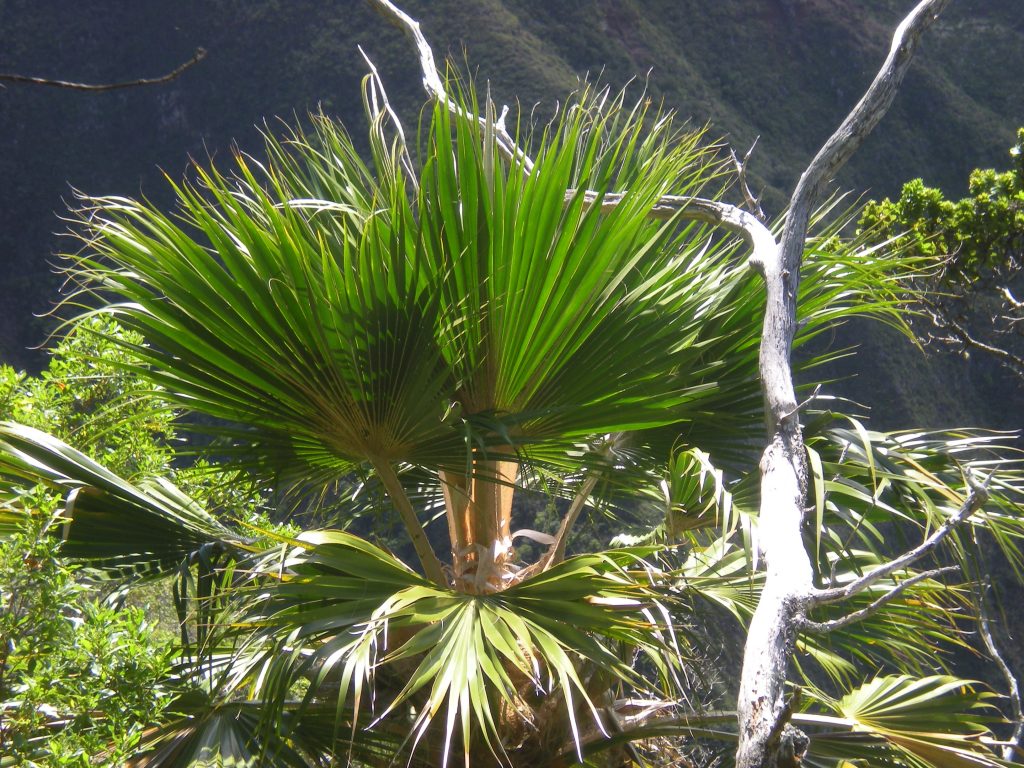
Loulu - Pritchardia
19 different species of Loulu are native to the Hawaiian Islands. Depending on the species, they can be as short as 4 ft. to up to a 100 ft. tall.
The seeds were a source of food for early Hawaiians. The trunks were used in construction, leaves used as umbrellas, thatching, and also in a cliff jumping/gliding game.
Maiapilo - Caparis sandwichiana
Endemic: All HI as well as some of the Northwestern Islands
Maiapilo is a small sprawling shrub with soft, light green leaves, fragrant white flowers and brittle stems. The large white flowers are extremely fragrant and look as though it is a cross between a rose and an ‘Ohi’a Lehua flower. Simply put, if you have a white rose and take out all the center petals and replace them with a white ‘Ohi’a lehua flower, you’ll have a maiapilo flower. These are night blooming flowers which usually open up in the early evening and by mid morning the next day they are wilted. Generally during the night, native moths pollinate the flowers when taking nectar. They are most likely attracted by the bright white reflection of the flowers in the moonlight and also by their beautiful scent. Once the flowers are pollinated small cucumber-like fruit, 2-4 inches in length begin to develop. The fruit is filled with bright orange pulp and numerous small brownish-black seeds.
This exceedingly rare endemic plant is found on the coast of all the main islands including some of the off shore islets as well as some of the Northwestern Hawaiian Islands. The plant pictured here is one of the last known plants on the eastern side of O’ahu, there were two plants side by side but the other fell victim to a recent construction of a walking path.
Although this plant is a relative of capers, there is no known cultural use at this time.
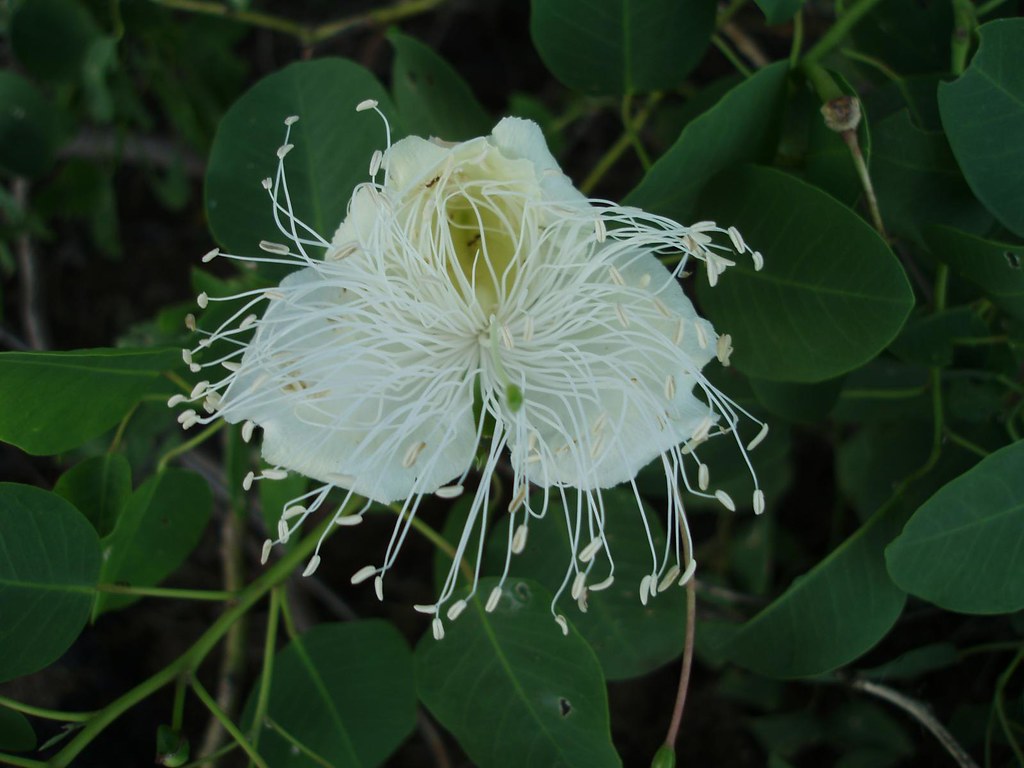

Maile - Alyxia stellata
Endemic: All HI except Kaho’olawe and Ni’ihau
Shrubby lianas that often twine like a vine but are more shrub-like in appearance. The leaves are highly variable in size, shape, and color ranging from dark to fairly light green. The flowers, which are very small, number 3-5 in a cluster and range from light green to creamy yellow. Once these flowers are pollinated they form green fruits that turn dark purple to black when ripe and are very glossy. Sometimes they segment into two or even three in-line fruits.
Maile is an endemic plant which means that it is only found in Hawai’i and no where else in the world. Today it is still fairly common in dry to mesic forests on all the main islands except Kaho’olawe and Ni’ihau, where they probably occurred in the past.
The new growth on maile is used to make very beautiful and highly fragrant lei. All parts of the plant contain a chemical called coumarin, which is the substance that gives this plant its fragrance (Wagner, et.al, 1999). Now days most of the “maile” lei that are sold come from the Cooke Islands and are not the actual maile that is native to Hawai’i. This is probably good because the Hawaiian maile is not as abundant today as in the past and grows very slow compared to the plants from the Cooke Islands.
Makaloa - Cyperus laevigatus
Also Known As: The Hawaiian Mat Making Flatsedge
Indigenous: All HI except Lana’i and Kaho’olawe
A small rounded sedge with narrow culms up to about 2 ft. tall ending up into a sharp point. The flowers are small spikelets that usually come down about an inch or two from the tip, protrude out from the side and are light brown-gray in color.
This plant is famous and highly valued by Hawaiians for its use to weave mats and more recently hats. In fact even the author Robert Louis Stevenson wrote that there were no mats finer than the makaloa mats of Hawaii during his travels throughout the Pacific.


Mamaki - Pipterus albidus
Endemic: All of HI except Kaho’olawe and Ni’ihau
Large shrubs or small trees 5-15 feet tall that generally have light green leaves with whitish undersides and either green pink or reddish colored veins. The leaves range in size from about four inches up to a foot across and are also fairly rough to the touch. Flowers are insignificant in appearance, but develop into fleshy white fruit which are connected directly to the stem usually where the leaf connects to the stem as well. A single plant can have hundreds of fruit at a time and each fruit contains many tiny brown seeds from which new plants will develop from.
Mamaki was used to make kapa (clothing) when the softer, more preferred wauke (paper mulberry) wasn’t available. Today as well as in the past, mamaki is commonly used to make a mild but invigorating and healthy tea.
Manono - Hedyotis terminalis
Endemic: All of HI except Ni’ihau and Kaho’olawe
Shrubs, small trees or even lianas (woody vine like plants) that reach heights of up to fifteen feet tall. They have extremely glossy green leaves that come out in pairs which alternate up the branch. The new leaves or liko are easily distinguishable because they almost look like a pair of puckered up lips ready to give you a big, fat, manono kiss. The flowers, which are usually green but can also be purple, have narrow petals and look very star shaped and can come out in clusters of up to 30 or more individuals. The fruits are numerous and can be either dark blue, purple or even black.
Manono are generally found in mesic to wet forests and bogs from 800 ft. to over 6000 ft. in elevation on all of the main islands except Ni’ihau and Kaho’olawe.
The flower and fruit clusters as well as the liko are highly valued and were commonly used in lei.
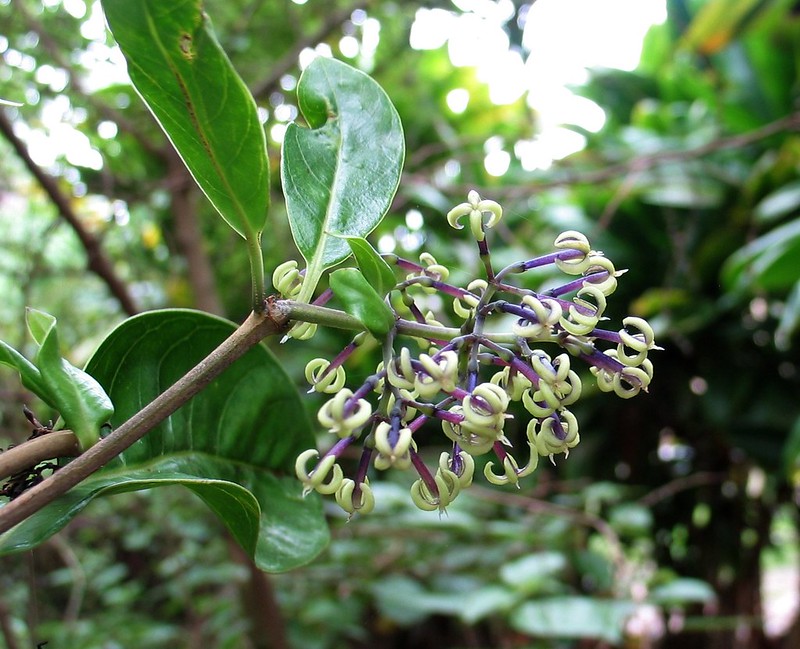
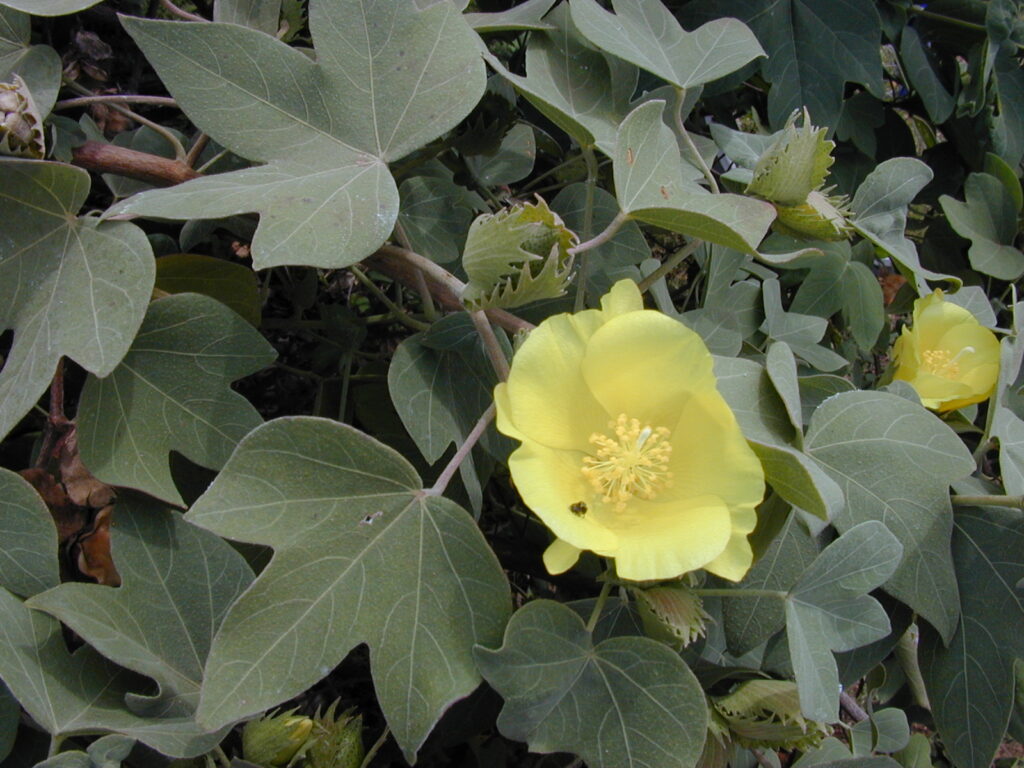
Maʻo - Gossypium tomentosum
Shrubs with pale green palmate leaves which have a light covering of silvery hairs called tomentose, which is how it gets its name. The flowers are very attractive being bright yellow, opening in the morning and closing by the next day. After the flowers are pollinated they develop into hard seed capsules about an inch in diameter. When the capsules become ripe they dry up and crack open revealing the small light brown cotton balls within. Unlike the commercial cotton we are used to seeing this type of cotton has short hairs making them not as useful as the other one. Ma’o can reach heights of three to four feet tall.
Ma’o can be strung into lei but primarily this plant was used to make a green dye, hence the name ma’o (green), but it was made from the yellow flowers.
Maʻo hau hele - Hibiscus brackenridgei subsp. molokaiana
Hawaii’s Official State Flower
A shrub (up to 10 ft.) with maple like leaves and bright yellow hibiscus flowers. This plant varies in appearance between islands but generally falls into three subspecies: H.brackenridgei subsp. brackenridgei of Maui, Molokai, Lana’i, and Hawai’i and H. brackenridgei subsp. mokuleianus of O’ahu and Kaua’I and this one, H. brackenridgei subsp. molokaiana of Molokai and O’ahu. The most visible difference between the three subspecies is in the leaves and stems. Subspecies mokuleianus has leaves with more serrated margins and pink veins; there are also tiny spines on the branches. Meanwhile, subspecies brackenridgei has leaves with more rounded margins, yellow veins and lacks the tiny spines on the branches. This particular subspecies came from Makua Valley on O’ahu where it was only recently discovered and posses characteristics of both subspecies making it very appealing. Its leaves resemble those of the subspecies brackenridgei but with pink veins like subspecies mokuleianus and although it is from O’ahu, it lacks the branch thorns of subsp. mokuleianus which is a good thing cause those little pricks can hurt.
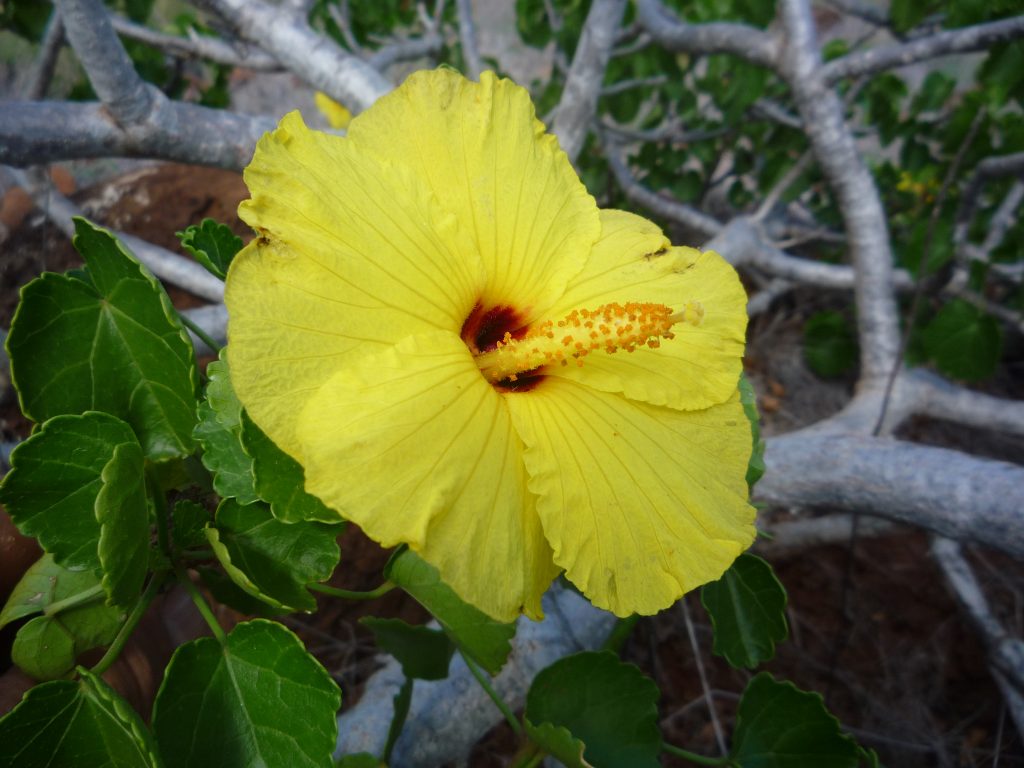
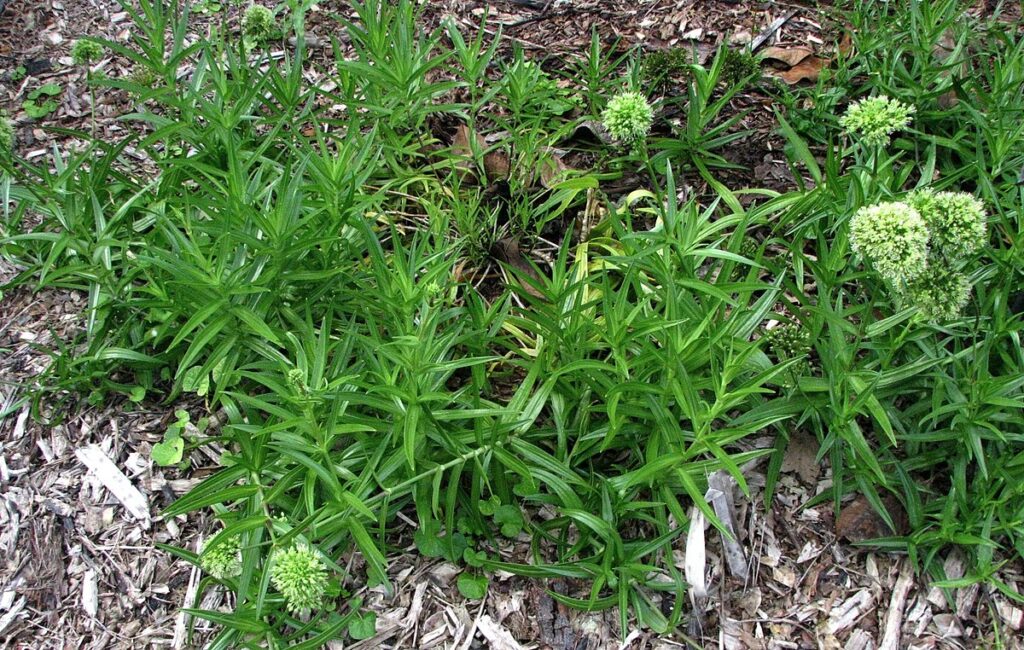
Māʻoliʻoli - Schiedea globosa
Low growing plants with narrow, almost succulent leaves and tiny flowers that form a rounded sunburst cluster that protrudes up above the plant.
Mauʻu ʻakiʻaki - Fimbristylis cymosa
This is a type of native sedge that forms short, rounded tufts up to 10 inches high. It has light green foliage with narrow, erect blades that are very stiff. When flowering, a cluster of brown spikelets form on a taller stem that rises slightly above the rest of the plant. Mau’u’aki’aki is a plant that you have to touch in order to get the full effect of it.
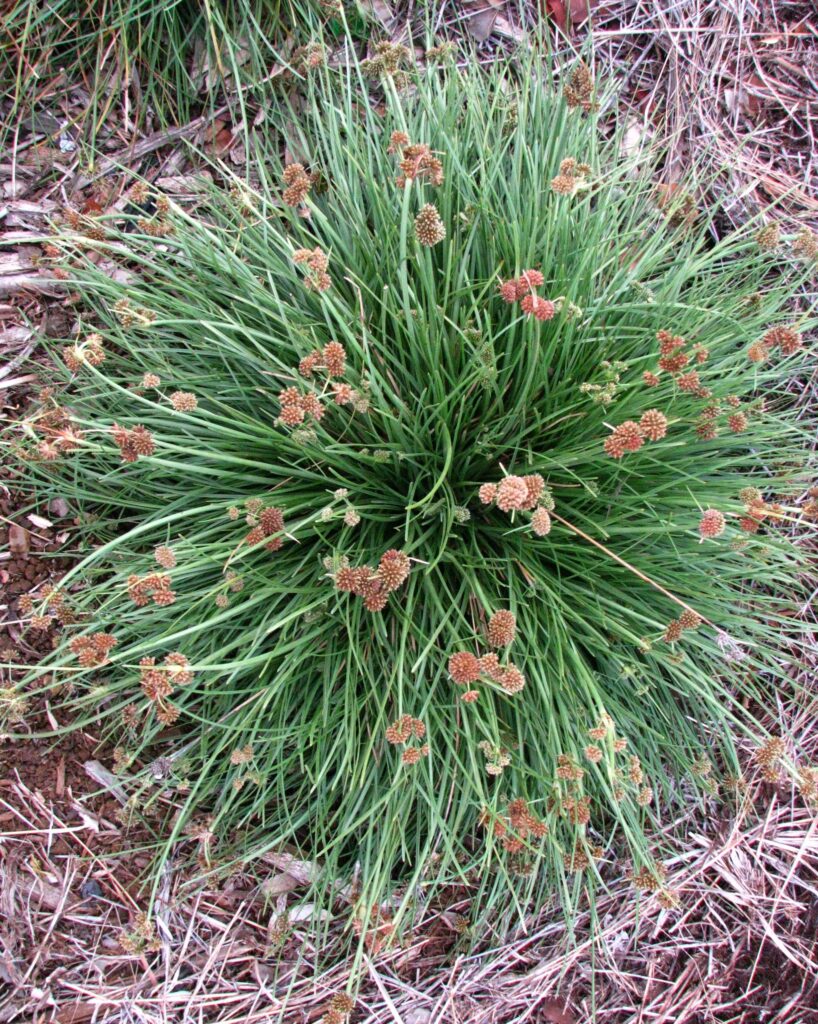
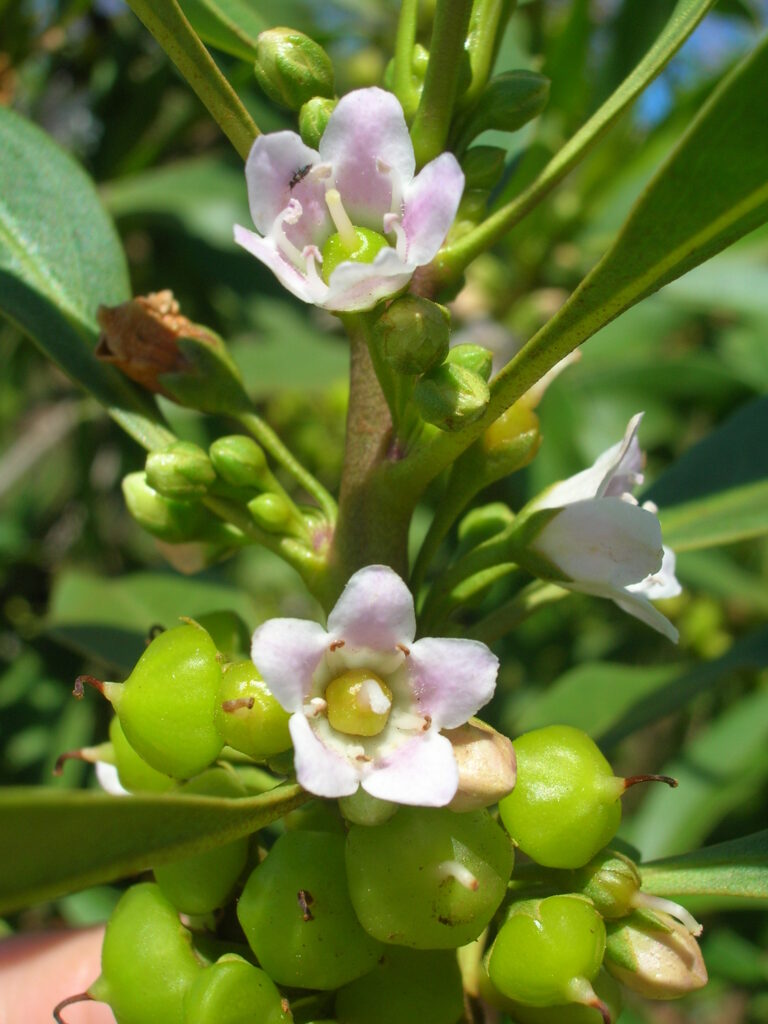
Naio - Myoporum sandwicense
Depending on which island you are on or perhaps more specifically which part of the island you are on, naio can take the form of a prostrate ground cover, such as naio papa at South Point on the island of Hawii; or fairly large shrub (about 8-10 ft tall) as in other coastal localities on most islands including the Pohakuloa region again on the island of Hawai’I or a 50-80 ft tall tree like those in the upper dry forests and subalpine regions of Maui and Hawaii. All of these forms will usually have glossy dark green, glabrous leaves which are anywhere from 1-8 inches long and about 1-2 inches wide. I say usually because there is also an endangered subspecies of this plant that is found on O’ahu (M. sandwicense sub sp. stellatum) that has smaller leaves that are covered in tiny tan colored hairs that make it seem almost velvet like in appearance. However all plants will have small, whitish-pink flowers about a half an inch in diameter that emit a spicy-sandalwood like fragrance. Once pollinated the flowers develop in to small fleshy white fruit of about the same size containing a single hard seed.
The hard wood of this plant is used in the construction of houses, spears and other smaller utensils.
Naio papa - Myoporum sandwicense
Naio papa is a crawling ground cover with dark green, glossy leaves and tiny white flower clusters that emerge from the leaf axis and stems. It has round white fruit that is up to a quarter of an inch in size. When in season hundreds of these tiny fruit can be seen dangling from the underside of each stem. Apparently there are a few different forms of naio papa. This is quite unusual considering that to my knowledge there is only one area in which this plant is found (as you can see in its distribution) and to have three obviously distinct forms growing within this one population is pretty unique.
One form has leaves that are a shade or two lighter than the rest, are much broader and appear almost succulent in appearance with marginal serrations near the leaf tip that are a little ‘jagged’. It also has fatter stems that are light green and spread out in a more prostrate manner. The second form has darker leaves that are a little narrower than the first and with much finer marginal serrations. The stems of the second form are also maroon at the tips and tend to not be as prostrate as the first; the flowers also have a pink tinge to them. The third form has dark leaves too but they seem to practically lack the marginal serrations as with the first two and its stems are much woodier in comparison to the first two. This form to me is also the tallest of the different varieties of naio papa.
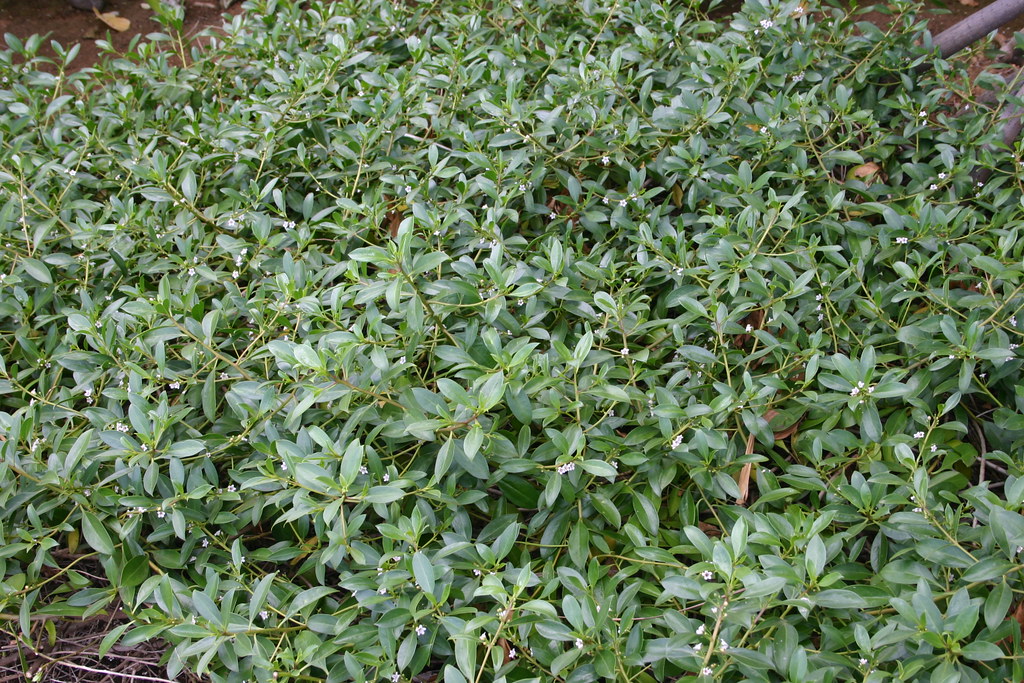
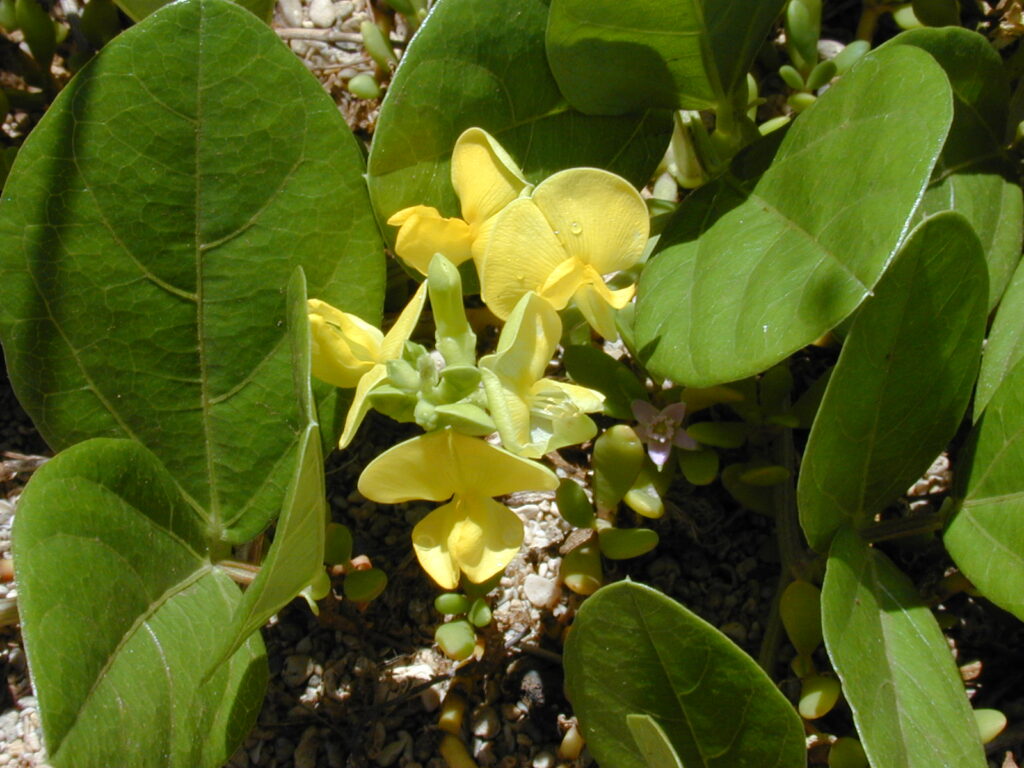
Nanea - Vigna mariana here
Also Known As: Beach Pea
An herbaceous plant that becomes woody towards the base; it can either crawl along the ground or grow up a fence or trellis. One leaf is composed of three oval leaflets about three inches in length each attached to very long running stems. They have pea type flowers which are bright yellow, about an inch wide and are arranged in clusters of 1-6 flowers. Once pollinated, pods develop with 2-10 small, reddish-brown seeds that are about a 1/4 inch long.
The flowers of nanea are beautiful enough and seem strong enough for use in lei, as well as the seeds.
Nāʻū - Gardenia brighamii
Also Known As: Hawaiian Gardenia
A large shrub or small tree 4-12 ft. tall (some of the few natural plants are about 20 ft tall) with light green leaves and light tan trunk. Tiny clear to opaque yellow resin balls develop at stem tips prior to new leaves forming. Small flowers about 2 inches across resemble a puakenikeni flower in petal shape rather than a gardenia and smells like the larger bushy, non-native gardenia flower but with a hint of coconut oil, that’s right you heard me, coconut oil. It smells so good you want to eat it, but I wouldn’t recommend that, it tastes terrible. Once the flowers are pollinated a large green fruit about the size of a golf ball forms. Inside the ripe fruit, brilliant yellow-orange pulp surrounds a hard seed capsule filled with even a bright, richer yellow orange pulp and housing around 100 seeds.
The yellow-orange pulp found within the seed capsule was highly valued for making a rich yellow dye for Ali’i. The color is so unique that it was called na’u, after the plant from which it is derived. The light colored wood was also used for making house posts for people of high status and the fragrant flowers are also strung into beautiful lei.
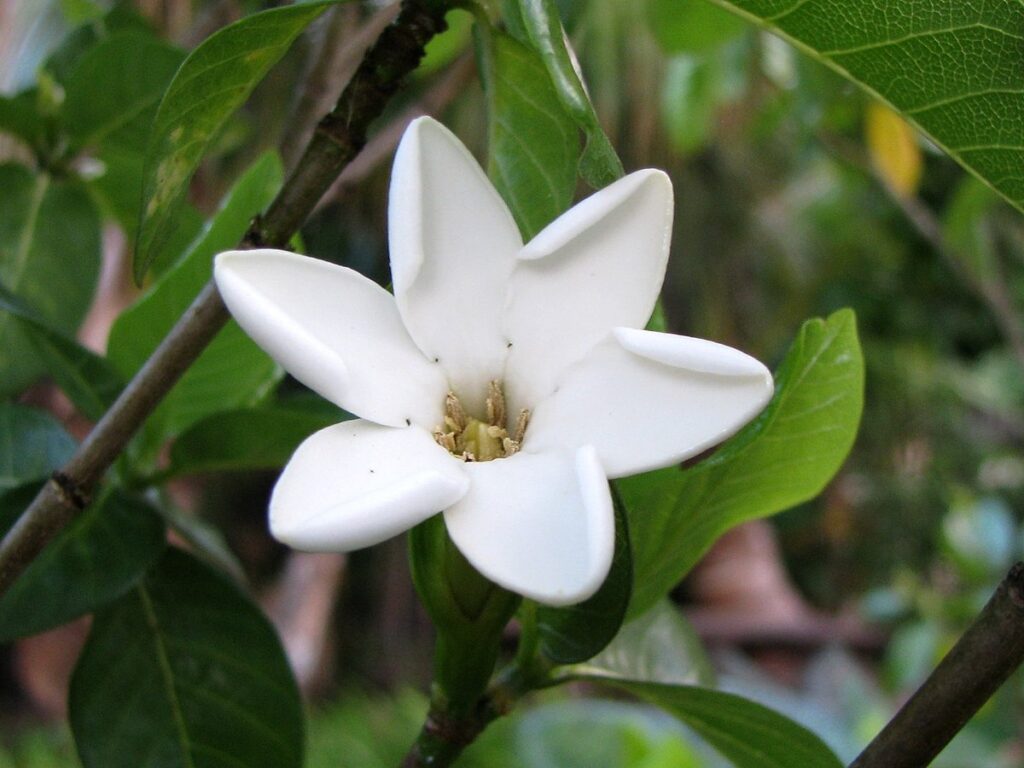
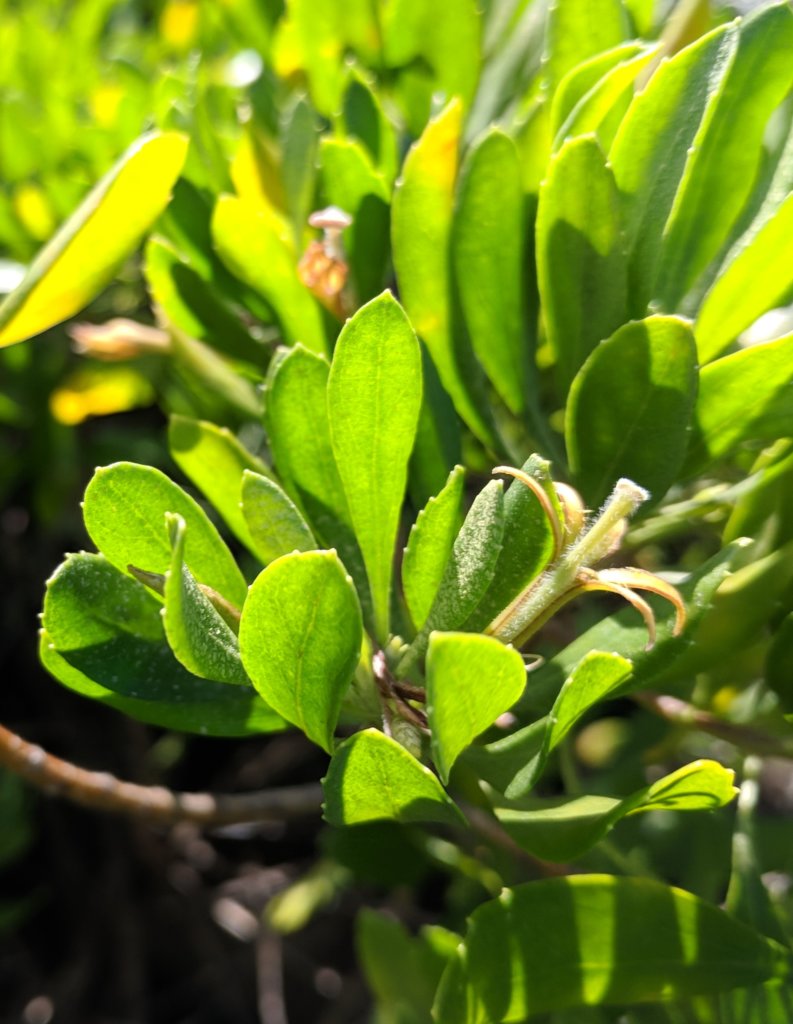
Naupaka Kuahiwi - Scaevola gaudichaudii
Also Known As: Mountain Naupaka
Small shrubs 3-4 ft. tall with narrow leaves about 2-3 inches long and ½-1 inch wide. The margins of the leaves are slightly serrated as you approach the tip. The most appealing feature of this native plant are their fragrant yellow ‘half flowers. Compared to the other 8 native species of Naupaka, 6 of which are also mountain dwelling (the other two are the common coastal naupaka kahakai (Scaevola sericea) and the Endangered dwarf naupaka (Scaevola coriacea) which is also found near the ocean). This particular species has the most narrow and pointed petals of them all, its very striking. The color of the flower is fairly unusual as well being that it is only one of two yellow flowered species of naupaka, the other being ‘ohe naupaka (Scaevola glabra) which is much more rare and only found in the upper elevation wet forests of the Ko’olau Mts. on O’ahu and on Kaua’i, it too has yellow flowers but their shape is more tubular and similar to that of a native lobelia rather than a naupaka. Once the flowers are pollinated, small black fruit develop with a single seed within.
The fragrant flowers of various naupaka kuahiwi are used in lei as seen in the book Na Lei Makamae by Marie McDonald and Paul Weissich (a definite must have for everyone especially hula dancers, native plant collectors, lei makers and Hawaiian culture enthusiasts).
Neke Fern - Cyclosorus interruptus
Also Known As: Marsh Fern
Medium sized ferns about 2 ft. tall with light green fronds and creeping rhizomes. Each frond is comprised of 20 or so pairs of pinnae, or smaller frondlets that are evenly spaced apart. The rhizomes are covered in small brown hairs. Overall this is a very attractive looking fern that has the potential to be a great addition to the landscape industry.
The fronds, but more specifically the pinnae are use to produce beautiful lei, either made up entirely of neke or having neke woven into a lei made up of numerous plants.
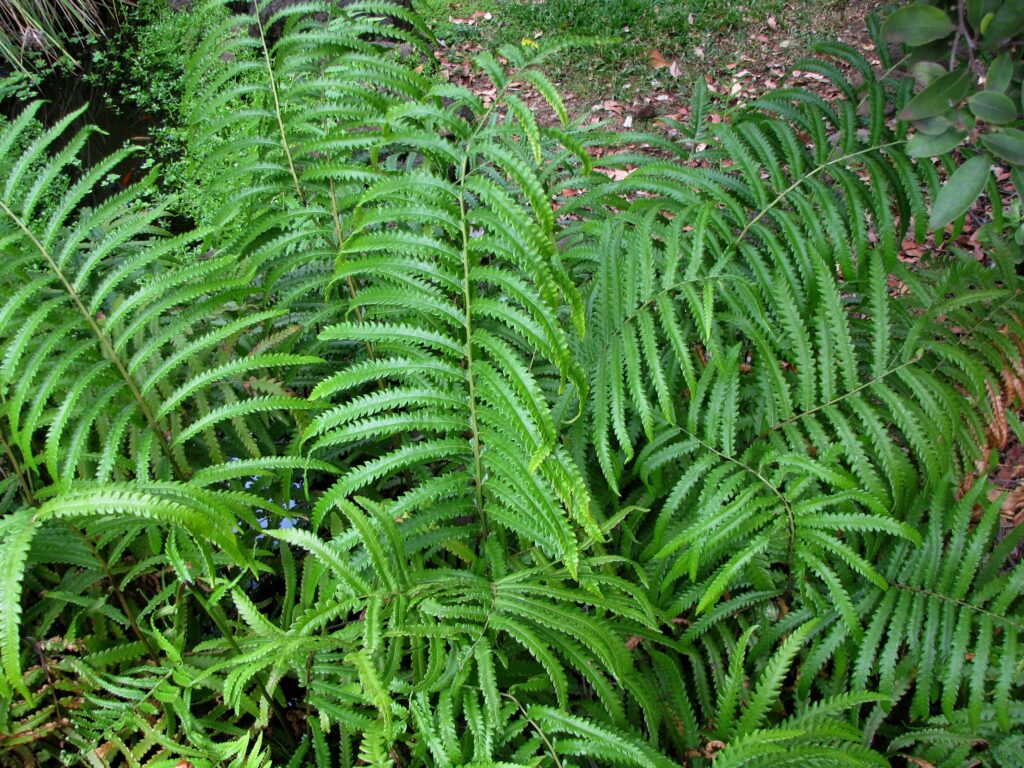

‘Oha - Delissea rhytidosperma
This is a type of native lobelia (family Campanulaceae) with herbaceous stems that sometimes branch, it also has a rosette type arrangement of leaves that cluster toward the tips of the branches and curved tubular flowers. Each leaf is elliptical in shape, about 4-10 inches long and 2 inches wide with margins that are pointedly serrated. The flowers are whitish-green and about 11/2″ long and later fade to a dark maroon before falling off. The petals are small, pointed and narrow and the stamen is situated so that it perfectly dabs pollen on the head of native nectar feeding birds so that they can pollinate other flowers in return. This flower design is common among native lobelias that have co-evolved with native avifauna. Once pollinated, the flowers develop into small, fleshy fruit that are dark maroon, about ¾” round and are filled with many tiny seeds.
There are no known cultural uses of this particular plant but it is known that other members of this family are used as bait to catch birds. Bird catchers would place sticky glue made from the fruit sap of papala kepau (Pisonia spp.) on the branch that the bird would perch on to feed, it would then become stuck to the branch making it easy to retrieve. The flowers of many other species of the family Campanulaceae are also used in making lei.
ʻŌhai - Sesbania tomentosa
Endemic Endangered Species
Very cool, to say the least, with unreal-looking flowers. These are small, upright trees 10 to 18 feet tall, with evenly pinnate leaves, which means that they have an even number of leaflets on each compound leaf.
Young leaves also have shiny, golden hairs on the surface, an evolutionary adaptation to help reflect the sun so that they don’t dry out. The hairy texture of the leaves is called tomentos.
The plant’s flowers are pea-shaped and about 2 inches long. They emerge in clusters of about two to five and are either bright orange or orange with streaks of yellow and red. Once the flowers have been pollinated, narrow seed pods form, filled with small green-dark brown seeds.
The flowers of ohai are strung into lei, either front to back, side to side (facing forward, keel down) or with the keel of the flowers alternating up and down. Actually, it doesn’t matter how you arrange the flowers; as long as you are wearing this lei you’ll be “da talk of da party.” Besides looking awesome, if you hold the flower by its stem and hit it on the top of your other hand, a few drops of sweet nectar will come out that you can lick up – da buggah ono!
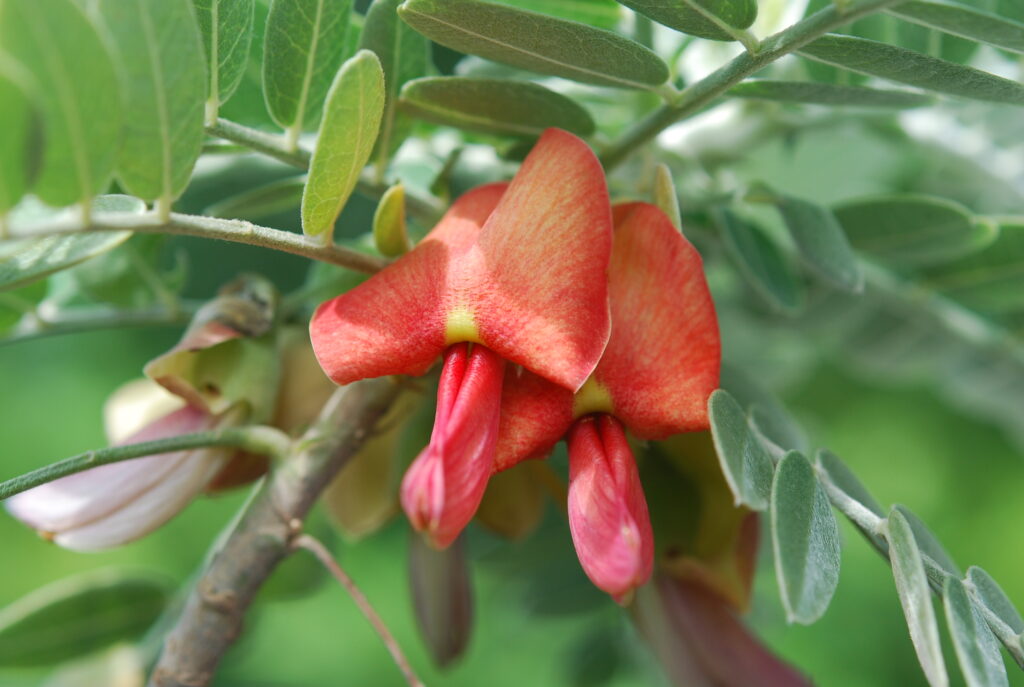

ʻŌhiʻa Lehua - polymorpha
Of the five different species of ‘ohi’a recognized, this is the most variable. The leaves of this plant range from 1/2″ to 3″, they can also be very glabrous or very hairy. The new leaves or liko range in color from dark purple, almost black to red, gold and everything in between. Some plants bush out while others grow to over 80 ft. tall. The ‘ohi’a or lehua as some people call, are best known for its flowers. They are just as variable as the plants themselves. Color ranges from very dark red (lehua ‘apane) all the way through to yellow (lehua mamo) or even white (lehua kea) according to some legends. I’ve even seen a flower that was dark red at the base, gradually faded to yellow and finally ended with greenish tips, it was unbelievable.
One of the most important woods in Hawaiian culture, ‘ohi’a was used for a number of things: In house construction, rafters and posts were made of it; decking, seats and gunwales of canoes were also made of ‘ohi’a; various leis either used the flowers, flower buds or leaf buds of ‘ohi’a; it decorated hula altars for the god Kuka Ohi’a and religious images called ki’i were made of ‘ohi’a as well.
Palapalai - Microlepia strigosa
Medium sized ferns that grow to be about 2-3+ ft. tall. Fronds are very soft and are usually light to medium green in color. Individual blades and midrib are usually very hairy as described by its Latin species name, striga which means short bristle like hairs. The degree of hairiness ranges from light to very heavy and are acknowledged as separate varieties.
Palapalai is a very important plant in Hawaiian culture, primarily for Hula. It is one of the plants Kapu (sacred) to Laka, the goddess of hula, it is also used to adorn the Hula altar and dancer as well and is highly sought after for making lei. Many songs and chants also refer to palapalai for its beauty and cultural importance.
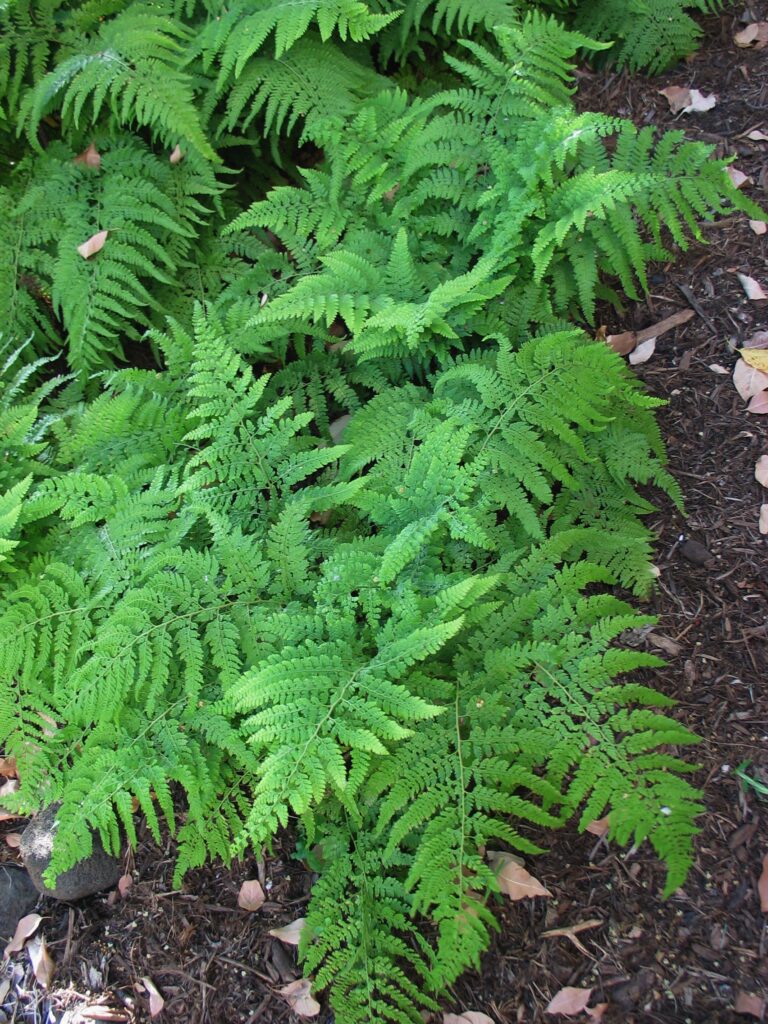
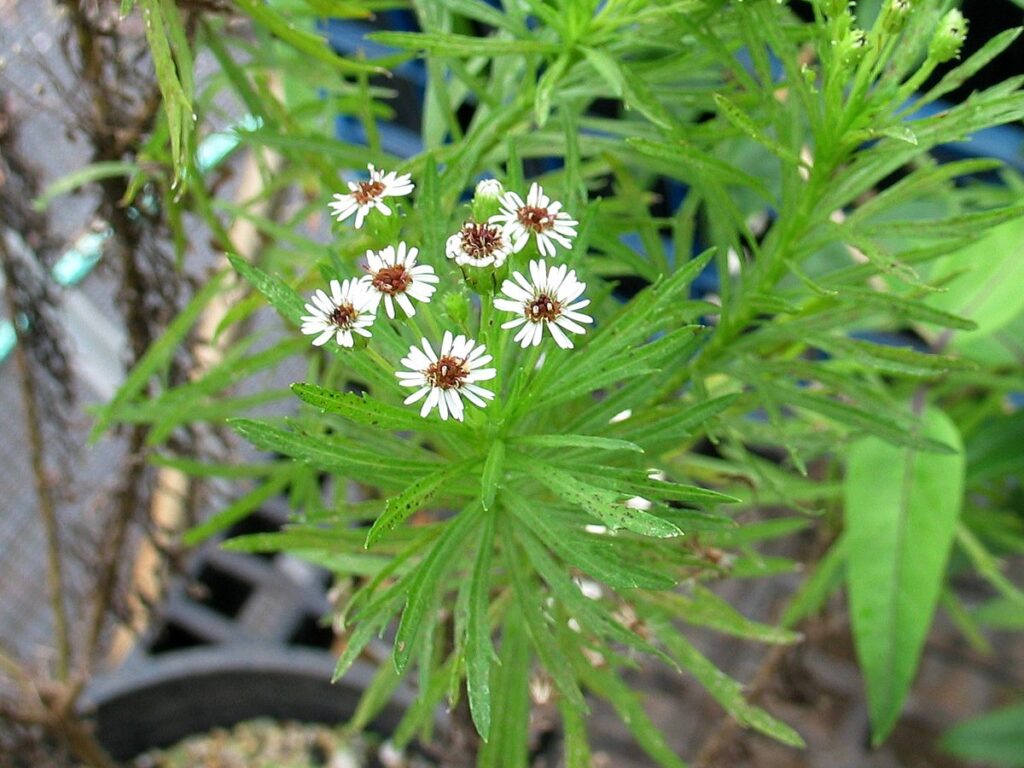
Pāmakani - Tetramolopium lepidotum subsp. lepidotum
Small compact shrubs about a foot tall with soft, featherlike leaves. Its flowers protrude above the plant in tight little clusters. Each flower has white petals with a yellow center, almost like a daisy. Basically, as manly as I can say it, this plant is very cute.
There are no known cultural uses for this plant, although with enough flower clusters, they would look very nice in leis. Because of their scarcity, I don’t recommend going out and collecting them; buy them from a nursery, plant them in your yard and then collect the flowers.
Pāpala - Charpentiera obovata
Exotic looking shubs to medium sized trees up to 15 feet tall with large elliptical leaves that are easily distinguished by their pronounced marginal rib that encompasses the entire leaf perimeter. Foliage color is usually light green but often new shoots can be reddish-pink. The veins of the leaves can be varying hues of green, cream and yellow or sometimes even maroon, pink and or purple. The flowers are very small and emerge on a hanging inflorescence that can also vary in color from yellow to dark red and is usually 12-18 inches long. The foliage and flowering characteristics of this plant make it look very unusual and is a definite attention getter for any yard.
The dried wood of this plant is very light and flammable and it was used as fireworks. Hawaiians would ignite the wood and throw them off of cliffs leaving a trail of fire as it fell.

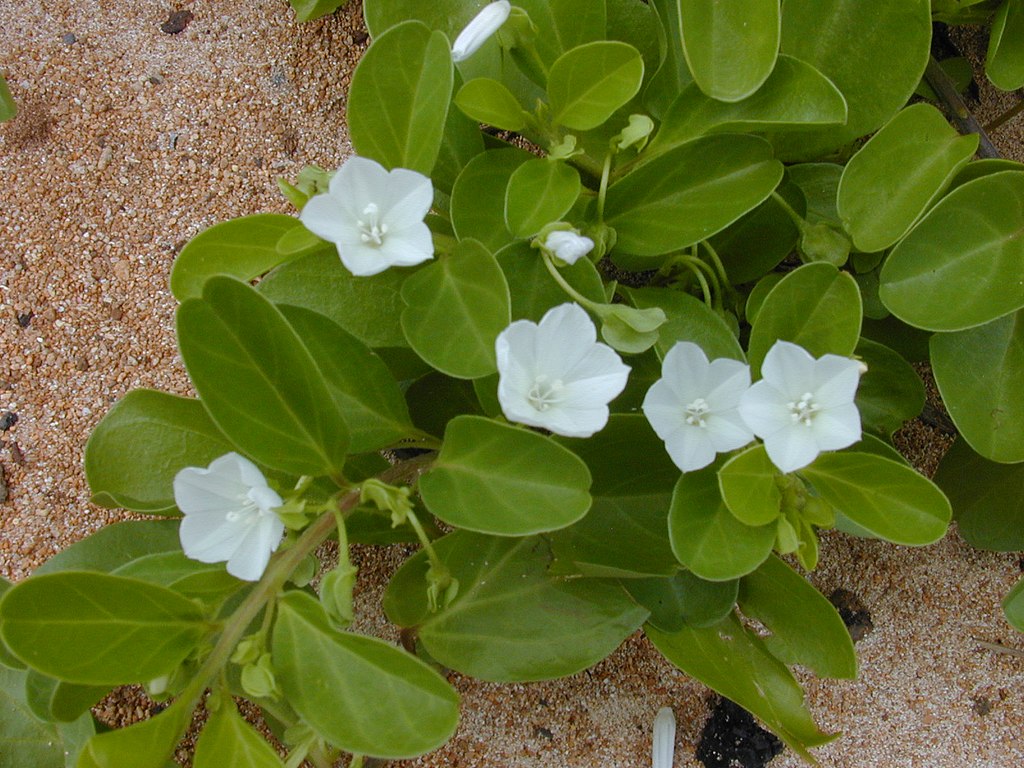
Pāʻu o Hiʻiaka - Jaquemontia ovalifolia subsp. sandwicense
Prostrate strand plants with small, alternating leaves that are light to dark green in color. Delicate flowers about 1 inch in diameter emerge from the leaf axis and range in color from lavender to white. They often look like vines crawling on the ground, but can become quite thick in some areas. In dry regions, the stems may be covered with fuzzy soft hair that helps them adapt to the harsh conditions.
Leaves of Pa’u o Hi’iaka were commonly used as a cathartic as well as to treat babies with thrush. The vine like runners were braided and used as a make shift lashing when other fibers were not available.
Pāwale - Rumex skottsbergii
Very unique, medium sized shrubs three to five feet tall with bright red stems and fairly thick leaves that are usually flat and elliptical in shape. Each leaf has a distinct yellow midrib that contrasts very well with the foliage and red stems. The petioles, which connect the leaf to the stem, are also red with green streaks. When in bloom a large inflorescence of greenish-yellow flowers protrude up above the plant. Once pollinated paper-like seed pods resembling those of ‘a’ali’i (Dodonea viscosa), only much smaller, develop.
Although not commonly used, most likely due to the scarcity of the plant, the bright greenish-yellow flower clusters and seed pods look great in lei. This is one of those flowers that will make people say: “Aunty (or Uncle), what kine flower is dat in your lei? Unreal la dat!” and then you say: “Yeah, I know. It’s…….pawale” and den dey goin say: “Pa— what?” and den you say: “PAWALE, you know Rumex skottsbergii!?!?” and then watch the blank look on their face.

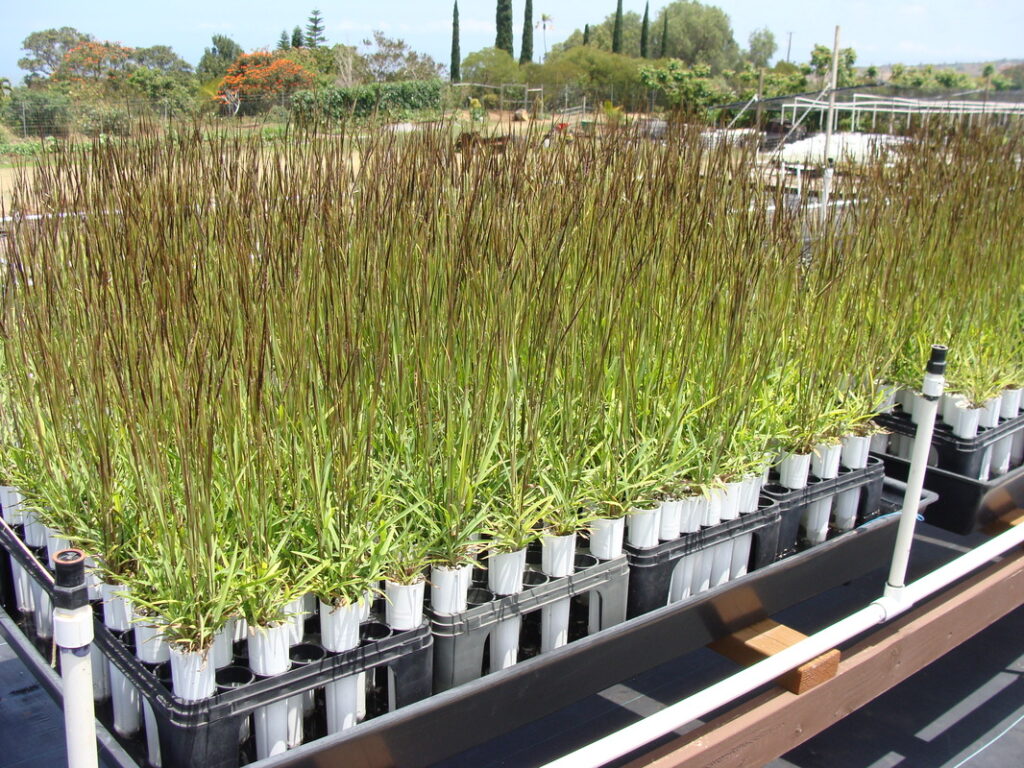
Pili - Heteropogon contortus
Pili grass forms bunches or tufts of light blueish-green leaf blades which range in height from two to three ft. tall. Their flowers, although insignificant in appearance, form spikelets at the top of the plant and often become tangled amongst each other. This dense cluster of seeds is most likely how the plant received its name since the word pili means to stick or cling to.
Pili was used in the past primarily for thatching houses and can still be used today for that purpose. It was also placed on hula altars for Laka in hopes that newly gained knowledge would pili, or stick in their minds.
Pōhinahina - Vitex rotundifolia
A sprawling shrub (2-3ft.) with rounded leaves that are silvery-green in color on top and whitish underneath. Small purple flowers form clusters which emerge at the top of the plant and sit in a pocket of the top leaves, very cool looking and it is definitely a striking site when a large area is in full bloom.
The fragrant leaves of this plant can be layered between folded kapa to repel insects.
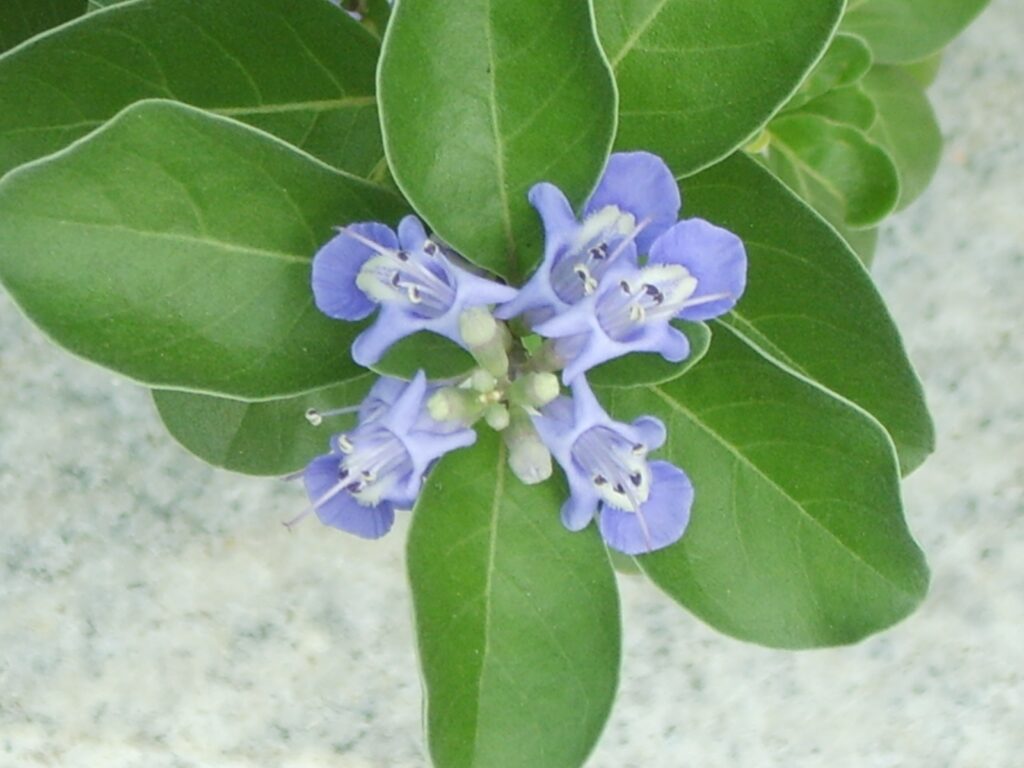

Pualoalo - Hibiscus arnotiianus
Unreal shrubs or small trees up to 20 ft. tall or more, but usually stay in the 6-8 foot range. These plants have dark green foliage, which is more glabrous than most species of native white hibiscus. The most attractive feature of this plant is its beautiful white and also fragrant flowers which emerge at the tips of branches. In the morning, the flowers open up and are a brilliant white and by the end of two days they slowly fade to a light pink and begin to close up before falling off. The petals of this hibiscus are very robust and thick which enable it to stay open for so long and which also adds to it’s stronger than normal fragrance. The stem tips of this variety is also dark maroon which makes the plant attractive even when not in bloom.
The flowers of Hibiscus were eaten as a laxative and some sources say that the native red hibiscus were eaten by girls and women while the white hibiscus were eaten by boys and men. In addition the flowers were also strung into lei but today it is most often put behind the ear.
Puʻukaʻa - Cyperus trachysanthos
Puʻukaʻa are beautiful sedges with long, graceful leaf blades that are very narrow and light green in color. The plant will reach a height of a little over three feet tall and it sends out short rhizomes to form dense tufts rather than long runners so they don’t spread too far. Within these long leaf blades emerges a tall stalk with several round clusters of spikelets (cyperus form of flowers) on top, as seen in the photo. These stalks will stand out taller than the rest of the plant and are an attractive feature.
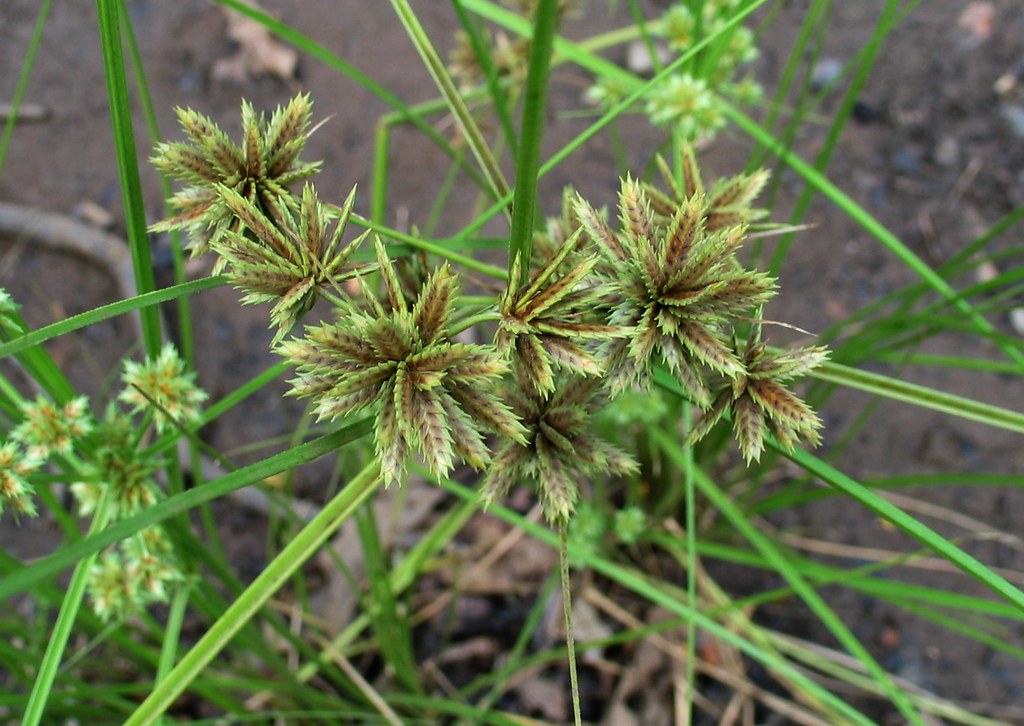

Uhiuhi - Caesalpinia kavaiensis
Large shrubs or trees up to 30 feet tall with light green pinnate leaves, grayish colored bark and strikingly beautiful red flowers.
The very hardwood (comparable to kauila and mehamehame) was used as house posts, for spears, holua sleds and ‘o’o while the flowers were strung into lei.
ʻUkiʻuki - Dianella sandwicense
From what I have seen there are two basic forms of ‘uki’uki found through out the state. One form has a more compact growth habit, only about 1-1.5 ft. tall (from now on this one will be referred to as the ‘short’ one) while the other has a taller, less compact look to it and can grow to about 2.5-3 ft. tall (we’ll call this one the ‘taller’ one). Both are beautiful lilies but in their own way. The short one (as seen in the picture above) has dark green leaf blades and when in bloom it sends up a short stalk in the middle of the foliage that is covered with small purple and yellow flowers that once pollinated develop into dark purple or even lavender berries about ½”-1” in diameter. The seeds of this form are black, smooth and extremely glossy. The taller one has lighter green foliage and sends out a taller stalk with much more of the same small flowers but these are usually white and yellow and once they are pollinated the fruit that develop are more transparent looking and not as vibrant purple color, sometimes they look brown and the seeds are not glossy and smooth like the short one, instead they are rough and come in a variety of shapes.
The leaves can be used for thatching while the berries of the short one make a nice bluish-purple dye for kapa while the taller one usually makes a yellowish-brown dye. As delicious as the berries look, don’t eat them they don’t taste ono at all and they turn your whole mouth blue, trust me I know.
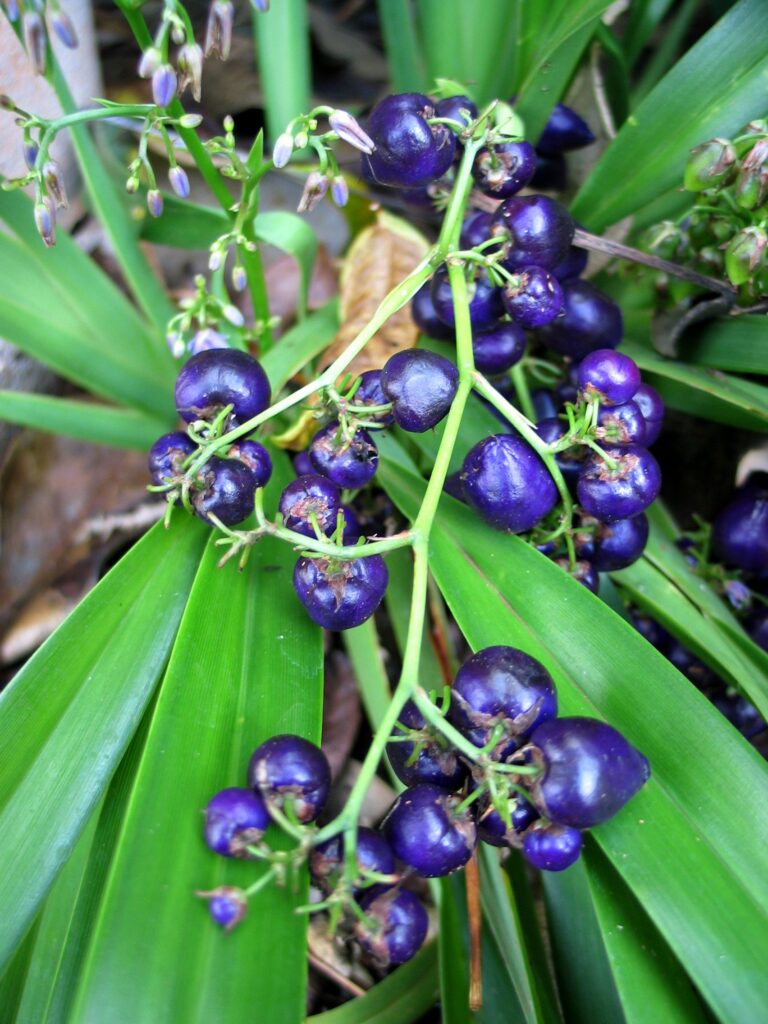
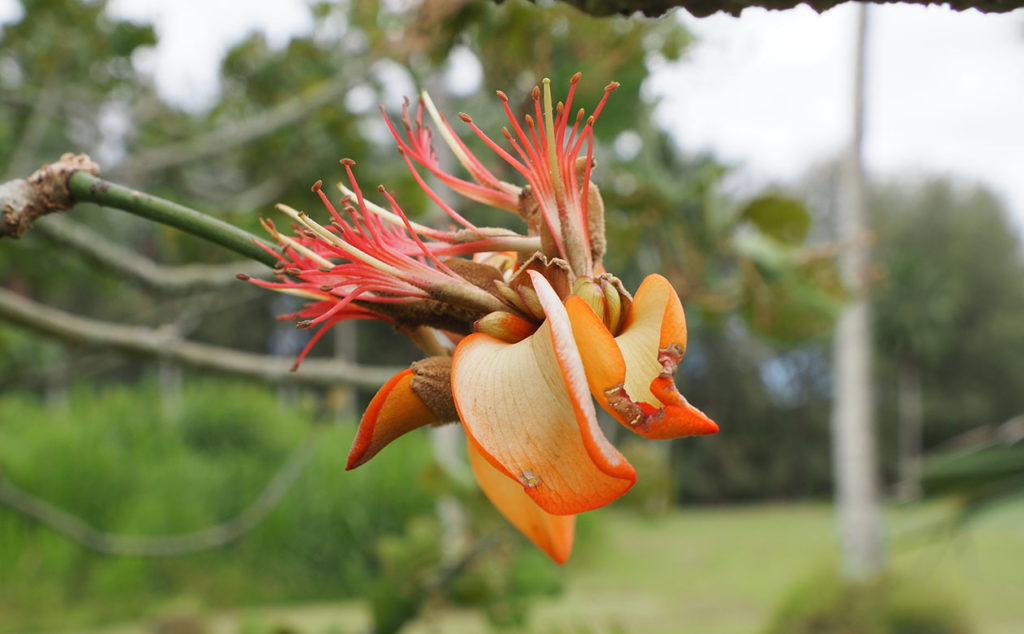
Wiliwili - Erythrina sandwicensis
Deciduous trees up to 40 feet tall with light green leaves, reddish-tan bark, and creamy green to dark orange-colored flowers that develop into seed pods with bright orange seeds. Sharp thorns develop on the trunk and branches. The thorns begin to fade as the tree ages.
The light wood is used culturally for constructing canoe outriggers, floats and surfboards. The seeds and individual flowers were strung into lei.
Nohu - Tribulus cistoides
Indigenous
Low-growing ground cover with bright yellow flowers that average in 2 inches in diameter. Once pollinated flowers develop in to sun shaped seed capsules that are covered with very hard and sharp spines.

